
Revision note:We've found coverage of Savoy 1165, "Tired of Moving" and "Blow Mr. Low" by Joe Williams (recorded either September 28 or December 31, 1953), in Cash Box for August 6, 1955. Obviously two sides from this session were sold to Savoy while Al Benson was still running Parrot and Blue Lake. We've added information about release dates for the 10 sides that Sister Rosetta Tharpe and Marie Knight recorded with Red Saunders at the drums. See the Club DeLisa page at http://www.facebook.com/pages/Club-Delisa/276533925813840.

At that time [1943], Red Saunders was one of the greatest show drummers in the world... I got a chance to see him play... at the Club DeLisa at 55th and State Streets. He was incredible. A lot of people are not aware of this, but Joe Williams got his first break working with Red.
—Roy Porter, There and Back (Bayou Press, 1991)
We did feature numbers up on the stage [at the Band Box] but, above all, the kids would love to dance to our music because Red has one of the most phenomenal beats even today. It just lifts you when you are playing so I can imagine how it would be when you are dancing. Musicians used to love to come and play with him because he had one of the fastest foots [sic], beautiful wrists and he could just swing so well. He's a great jazz drummer, but he's also one of the best show drummers in the country and that's not taking anything away from Sonny Payne, he'll say the same thing. Don't give him a show to play, he'll tear any show up.
Sonny Cohn, in Peter Vacher, "The Sonny Cohn Story," Jazz Journal, September 1963, p. 5.
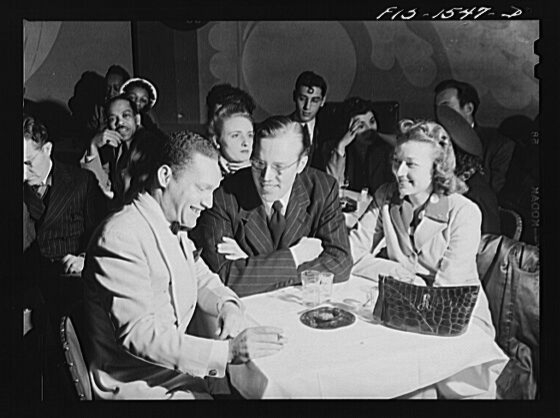
Theodore Dudley "Red" Saunders was born in Memphis on March 2, 1912. He became a permanent resident of Chicago in 1923. Here is how he described his early days to Art Hodes. Whatever editing Hodes did, the rat-tat-tat delivery seems authentic. (Hodes. we might add, was being euphemistic about the TOBA. It was usually glossed as "tough on black asses.")
Lil [Hardin Armstrong] and my sister were close friends, schoolmates. No, you can't say I come from a musical family. Nobody played. We did have an old Victor phono. We heard a variety of music—McCormack, Caruso, also Bessie Smith and Ma Rainey. I caught them in person—you know, TOBA (Theater Owners Booking Assoc., known to performers as "tough on black acts"), the Negro chain. Fifty-two weeks, all the major cities in the United States. I saw Ethel Waters long before she made the big time. And Johnny Dunn. Beating on fences and pans. My sister brought me north when my mother passed on. My father moved to Kansas City; he's passing. I tell the truth. (Down Beat, August 10, 1967, p. 18).
After attending St. Benedict the Moor (a Catholic boarding school in Milwaukee) and Tilden Tech in Chicago, Saunders became a professional musician in 1928. Of St. Benedict's Red recalled to Hodes, "That's where I took my first drum lession—10 cents a lesson; white teacher. I was about 13 years old." He also remembered John Philip Sousa coming and directing the band once while he was at Tilden Tech. His first gig was with pianist Stomp King, while he was still in school. Of King he said merely, "He wasn't good, but conditions were bad, and he could get musicians to hustle." At times King could call on musicians of the caliber of Darnell Howard or Omer Simeon, even though his modus operandi was to scour for work in joints in the "outlying towns"; the musicians would get paid, if at all, from passing the hat.
Subsequently Red worked for five years with Ira Coffey's Walkathonians, a band that (as the name suggests) played for Walkathons; he took the drum chair during a Walkathon at the Chicago Coliseum. These were a variant on the dance marathons that became popular during the Depression; couples walked around a track in a large hall, day after day, with only short rest breaks, and the last couple standing won a prize. The revenue source for the Walkathons was the substantial crowds that gathered to watch the event. The Coffey band toured extensively. It was on one of these tours that Red met his good friend Count Basie in 1932; the tours also seem to have cured him of any desire to spend time on the road. He didn't so much as mention the Walkathons to Hodes.
On July 4, 1933, the Walkathonians opened at the Convention Hall in Atlantic City. At this point in its history the band consisted of Edgar "Pudding Head" Battle (trumpet, vocals); Clyde Bernhardt (trombone); Norman Mason (alto saxophone); Edmund Duff (tenor sax); Ira Coffey (piano, leader); Red Saunders (drums). It should have been a plum gig, but the all-white Musicians Union local interfered, leaning on the promoter to give two weeks' notice to everyone but Coffey (whose knowledge of the Walkathon routines was deemed too hard to replace). The other musicians found work in New York and New Jersey, and rejoined Coffey in October at the Airport Inn in Camden, NJ. But Red Saunders had hit the road with Curtis Mosby's revue Harlem Scandals; he did not return to the Walkathonians, and was replaced by Harry Dial. (See I Remember by Clyde Bernhardt, published in 1986, pp. 113-115.)
Red continued with Mosby (who was out of Los Angeles) in the Change Your Luck show. Albert McCarthy in Big Band Jazz gives the following roster: Leroy Huston, Gene Prince, Theodore "Wingy" Carpenter (tp); Baron Willie Moorhead (tb); William Johnson, Clester Wells, John Mitchell (reeds); Wilbert Baranco (p); William Dirvin (g); Julius Harris (b); Red Saunders (d). It is interesting to see Red in the company of Wilbert Baranco, who in the 1940s was one of the first employers of the young Charles Mingus. After the Mosby tours wound up, Red returned to Chicago, where he had no trouble finding work; the pay scale was a whole nother matter... In 1934, he and trumpeter Guy Kelly were in one of the later bands led by Hartzell Strathdene "Tiny" Parham (McCarthy is the source for this connection as well). According to the Hodes article the Parham band played "one, two days" a week at the Savoy Ballroom. "I got $8 a night at the Savoy."
Red slowly climbed the ladder of Depression-era Chicago gigs. "Then I started at the 29 Club (47th and Dearborn). I got $14 a week; and you know when I asked for a raise (I asked for $15) I got fired. Yeah, those were days. The Annex at 23rd and State. Jimmy Cobb [trumpet] played there. And Chippie Hill. And Albert Ammons down the street at the Claremont." He described the regimen:
Entertainers used to have 'ups.' We hit the stand at 10. Your first intermission is at 3. Two shows and then 'ups.' The gals [vocalists] would make the rounds, sing at the tables, and split with the band. Sometimes they'd run in the toilet to steal. We had a guy who'd run right after 'em—right in the can—and make 'em split the dough. (p. 19)
By early 1937, Red was in the house band at the Club DeLisa, then a three-year-old club on the South Side. The band was under the leadership of Albert Ammons (1907-1949), soon to become famous as a boogie-woogie pianist. Ammons' drummer, Jimmy Hoskins, couldn't hold his liquor, fell off the bandstand one time too many, so Saunders replaced him. Then Ammons was pushed out because he couldn't read the arrangements required to back some of the acts in the floor show, which the DeLisa management was trying to build up. Leadership was assumed by Dalbert Bright (clarinet, alto sax; Bright was an alumnus of Tiny Parham's 1929 band as well as Albert Ammons' 1936 band, and Red described his musicianship as "very good"). Then Bright left to join Horace Henderson's big band (where he would remain till 1940).
On July 10, 1937 the Chicago Defender ran a story headlined, "Horace Henderson's Band Moves in as Swingland's Big Feature," which concluded as follows: "Red Saunders took over Delbert [sic] Bright's hot spot at the DeLisa Cafe July 8, with Porter Derrico, piano; Frank Owens, sax; Ike Perkins, guitar; Lawrence "Mickey" Simms, bass; Orlando Randolph, trumpet, and "Red" Saunders kicking the hides." Within the first year of Red's run, Leon Washington (just back from a stint in Earl Hines' big band) had taken over from Frank Owens. In the Chicago Defender for July 16, 1938, Jack Ellis proclaimed (in his regular column, "The Orchestras"): "Red Saunders is still packing them in at the DeLisa Cafe. Leon Washington is kicking plenty of tenor sax in Red's band, and how!"
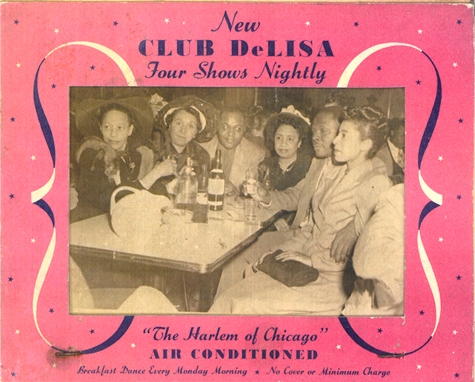
This is a good a place as any to introduce Porter Derrico. Porter Cortez Derrico was born in Memphis, Tennessee, on January 28, 1914 (Local 208's file card gave the date as 1913), the son of Cornelius Derrico and Julia Gray. His family moved to Chicago in 1926. We don't know when started playing piano in public, but he joined Local 208 on February 2, 1934. When he joined the DeLisa ensemble (probably before Red became the leader) he was 23 years old.
The original DeLisa band was a six or seven-piece ensemble. A band photo that ran in December 1938 shows 7 men.
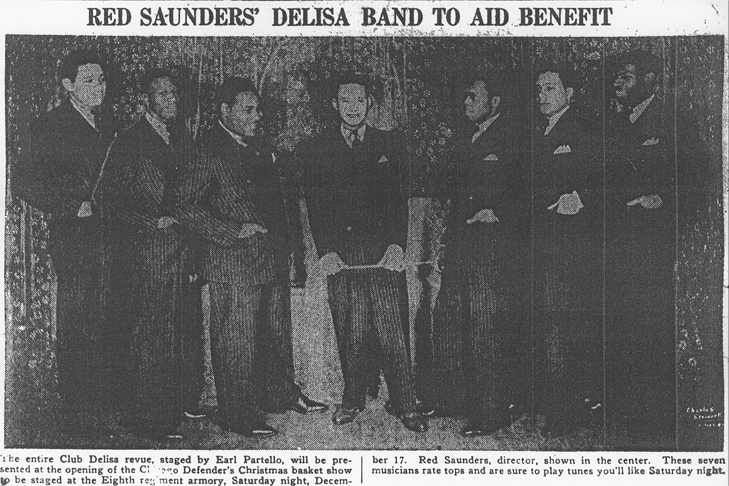
In a story we were tipped to by the late Michel Chaigne, Ted Watson, the Pittsburgh Courier's Chicago columnist, talked up the Saunders band on January 28, 1939 (p. 20). This could have been the band's first coverage in a newspaper outside of Chicago. The personnel, now 7 pieces, consisted of Orlando Randolph (trumpet); Leon Washington and Hobart Clardy (saxes); Porter Derrico (piano); Ike Perkins (guitar); Lawrence Sims (bass); and Red at the drums.
A photo in the Chicago Defender from May 11, 1940 depicted the same lineup of Randolph (tp); Clardy (as); Washington (ts, cl); Derrico (p); Perkins (eg); Simms (b); and Saunders (d, vib, ldr). The Mohr-Flückiger-Demeusy files contain an additional reference to the same lineup in 1939, with vocalists Jean Brady and Charles Isom added. Charles Isom would remain at the DeLisa for several years, often billed as a comedian or as the MC The same photo of the band was used on August 2, 1941, while a different photo of the same band appeared on November 23, 1940.
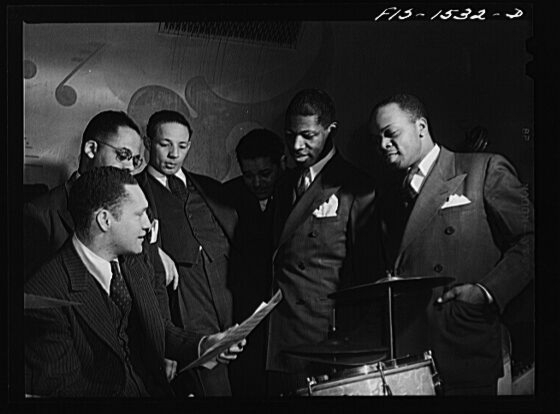
An article by Red himself appeared in Down Beat on June 15, 1940. In it he mentioned Charles Isom as his vocalist and stated that when he played vibes, Mickey Simms moved over to the drum chair. Red proclaimed that the band had a library of 50 originals, all fully arranged. The most interesting part described Red's unusually advanced business model:
I run the band as a cooperative club. We all draw our weekly checks, and deposit a specific amount into annuities. All our overtime money goes into a sinking fund. This, in turn, is used to buy uniforms, arrangements, equipment, and other band necessities. We own our own recording outfit, and continually check our progress by test sides. All gripes and laughs are shared alike at round table discussions at the club and at one of our homes.
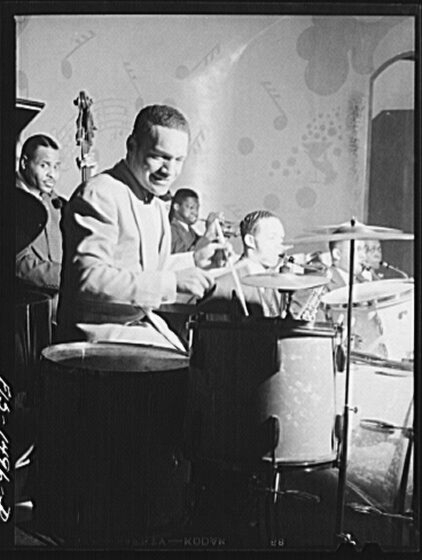
In April 1942, photos taken at the DeLisa show that Ike Perkins had left and Red was fronting a 7-piece band with three saxes, including Leon Washington on tenor. These were taken by Jack Delano and became part of the Office of War Information Photograph Collection; all 10 of them can be seen on the Library of Congress Website (by going to http://lcweb2.loc.gov/pp/mdbquery.html and typing "delisa" as a query).
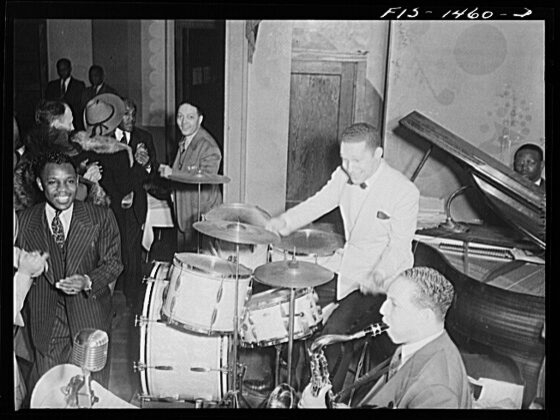
A rare mention of Red Saunders in the Amsterdam News out of New York City has him entertaining troops at the Great Lakes US Naval Training Center, specifically at Camp Robert Smalls, a segregated facility for Black servicemen.
The 8-piece swing band headlined an hour-long entertainment program, which also included the floor-show from the night-club at which "Red" is appearing in Chicago, and Camp Small's own rhythm band....
Before an audience of more than 2,500 applauding sailors, the two bands ran the gamut of musical entertainment from the solid "Drum Boogie" and Hoagy Carmichael's "Stardust," to musical parodies on symphonic numbers. (June 5, 1943)
Around the same time, a lawyer named Albert Marks started a series of Sunday afternoon jam sessions (4 to 7 PM) at the Hamilton Hotel, in which Red was a regular participant. With $1 admission, and "standby fees" being charged by the Musicians Union, the series was just breaking even, drawing 300 to 350 in a room that could seat twice that number.
The series lasted into September; besides those pictured, the participants included Ray Walter, Muggsy Spanier, Red Allen, Pete Brown, Boyce Brown, John Lane, Streamline Ewing, Henry Fort, Eddie Johnson, Marty Marsala, J. C. Higginbotham, and Morry Bercov ("Chi Jam Session Backer Hopes for Early Frost; Hot Jazz Finds Heat Tough Competish," Billboard, August 7, 1943, p. 15).
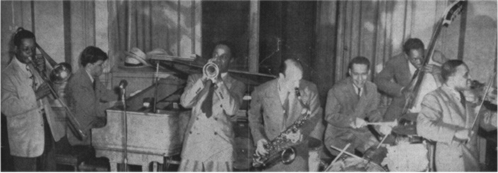
During his early years at the DeLisa, Red made an occasional brief road trip, during which he reportedly played with Duke Ellington and Woody Herman. There is no mention of Saunders in Timner's Ellingtonia (4th edition), so we expect any recordings with the Duke are ruled out. Duke obviously knew Red, however, and would served as the honorary chairman during the festivities in January 1953 that commemorated Red's 15 years at the Club DeLisa. Red did make one transcription session with Woody Herman, and this turns out to be his earliest known recording. (Thanks to Allen Welsh for checking Ellington volumes and for alerting us to this Woody Herman session.)
Woody Herman (cl, as, voc); Neal Hefti (tp); Billy Robbins (tp); Ray Wetzel (tp); Mario Serritello (tp); Ray Nance (tp); Juan Tizol (v-tb); Al Esposito (tb); Ed Kiefer (tb); Johnny Hodges (as); Chuck DiMaggio (as); Herbie Fields (ts); Toots Mondello (ts); Skippy DeSair (bars); Ralph Burns (p); Billy Bauer (eg); Chubby Jackson (b); Theodore "Red" Saunders (d); Frances Wayne (voc).
New York City, April 5, 1944
| 71939 | As Long as I Live [FW voc] | World Transcription 7289/7298 | |
| 71940-A | Perdido | Brunswick [Br] 03541, Brunswick BL54024, Decca DL 79229, Decca DL 9229, Decca DL8400, Coral CRL56090, Ajaz 231 | |
| 71941 | I Didn't Know about You [WH voc] | Decca 18641, Ajaz 231 | |
| Blue Lullaby | World Transcription 6539/6548, World Disc R650 |
Our information about this session comes from Lord's Jazz Discography. While there was considerable fluctuation in Herman's personnel during the first four months of 1944, Cliff Leeman was Woody Herman's regular drummer up through the previous transcription date on March 29, 1944. A Woody Herman appearance during a week at Frank Dailey's Terrace Room, in Newark, New Jersey, was reviewed by James C. Whitfield (Billboard, April 8, 1944, p. 20). Whitfield noted the presence of Herbie Fields and Neal Hefti in the band, along with considerable turnover in the rhythm section: "However, replacements, particularly the skin-beating chores, ably handled by 'Red' Saunders, currently subbing for the ailing Cliff Leemans [sic], still give the band the drive needed to make it move." The next known Herman recording is from the Old Gold Radio Show of August 2, 1944, and it features Dave Tough.
World Transcriptions was owned by Decca, which subsequently put some transcription material on commercial releases. The session was announced in Billboard as being for Decca, by a Woody Herman band with Johnny Hodges, Herbie Fields, Juan Tizol, and Red Saunders added. Six titles were mentioned, including "Querita," "Do That Thing," and "Today of All Days," which may not have ended up being recorded, while "Blue Lullaby" was not mentioned ("Herman Adds Four for Decca Waxing," Billboard, April 15, 1944, p. 12). "Perdido" has been issued on several LPs from Decca, Brunswick, and Coral. The Ajaz series was a chronological-order series of collectors' LPs that flourished during the 1970s.
By mid-1944 we know that his band included Leon Washington, Porter Derrico, Micky Simms, and alto saxophonist Nat Jones (mentioned as a Saunders band member in a short item in Down Beatfor June 5, 1944); the rest of the lineup needs to be recovered. Nat Jones, who was out of the Johnny Hodges lineage, had already worked for Duke Ellington by this time, serving in the Famous Orchestra from June through November 1943; he had also been in the notorious "Dream Band" at the Rhumboogie.
On July 29, Larry Nixon published his brief review of a live show at the Club DeLisa in Billboard. This was a bit unusual, since the Red Saunders band still had no recordings to its name:
Drummer Red Saunders puts a lot of enthusiasm into his job, vim and spirit that is conveyed to the other members of his band and to the customers as well. Instrumentation, four reed, two brass, and three rhythm. "Stump" Whitlock, good as hot trumpeter, also handles vocals.
The ork gets a lot of jump into hot music but manages to make it dance music, too. A competent job of playing for the show in this nitery proves the aggregation considerably more than a group of anxious-to-play individuals. Swing numbers were not neglected in keeping with the spot, but current pop tunes were as well done as Saunders's originals, I Don't Know and It Makes Me Blue.
Playing the De Lisa for some months, the ork may move to a Loop spot in October.
In fact, Red's next appearance in the studio was still not with his own band. Red's participation in the two T-Bone Walker sessions probably came about because Marl Young, who arranged numbers for the floorshow at the Rhumboogie Cafe, a few blocks away, had also been writing arrangements for the DeLisa floorshow since 1940 or 1941. While Young was working the Rhumboogie (as arranger and floorshow conductor from the summer of 1942, band pianist from November 1943 to June 1944, and as the bandleader from June 1944 to January 1945), he and other members of the Rhumboogie house band used to play the Monday morning breakfast dances at the Club DeLisa. T-Bone Walker, who had headlined the Rhumboogie to great success in 1942 and 1943, returned for another run from July through October 1944. Charlie Glenn, the owner of the club, decided to capitalize on T-Bone's popularity and promote the club by starting a new label to record him. See our Rhumboogie page and the late Charles Walton's online article on Marl Young.
Aaron Thibeaux "T-Bone" Walker (eg, voc); Marl Young (p, dir, arr); Henderson Smith (tp); Nick Cooper (tp); Nat Jones (as); Frank Derrick (as); Moses Gant (ts); Micky Simms (b); Theodore "Red" Saunders (d).
RCA Victor Studio, Chicago, October 10, 1944
| QB-3305-1B | Sail On Boogie (Young-Walker-Glenn) | Rhumboogie 4000B, Rhumboogie M-33-1^, Blues Boy BB 304, Mosaic MR9-130, Mosaic MD6-130 [CD], Indigo IGO CD 2123, History 20.1948-H [CD], Classics 5007 [CD] | |
| QB-3306-1A | I'm Still in Love with You (Walker-Glenn) | Rhumboogie 4000A, Rhumboogie M-33-2^, Blues Boy BB 304, Mosaic MR9-130, Mosaic MD6-130 [CD], Rhino R2 79894 [CD], Indigo IGO CD 2123, History 20.1948-H [CD], Classics 5007 [CD] | |
| QB-3307 | unidentified title | ||
| (QB) 3308-2 | You Don't Love Me Blues (Walker)^ | Rhumboogie 4003-B, Blues Boy BB 304, Mosaic MR9-130, Mosaic MD6-130 [CD], Indigo IGO CD 2123, History 20.1948-H [CD], Classics 5007 [CD] | |
| (QB) 3309-1 | T-Bone Boogie (Walker-Glenn) [ens voc] | Rhumboogie 4002 B, Blues Boy BB 304, Mosaic MR9-130, Mosaic MD6-130 [CD], Indigo IGO CD 2123, History 20.1948-H [CD], Classics 5007 [CD] | |
| (QB) 3310-1 | Mean Old World Blues (Walker)^ | Rhumboogie 4003-A, Blues Boy BB 304, Mosaic MR9-130, Mosaic MD6-130 [CD], Rhino R2 79894 [CD], Indigo IGO CD 2123, History 20.1948-H [CD], Classics 5007 [CD] | |
| (QB) 3311-2 | Evening (composer not listed) | Rhumboogie 4002 A, Blues Boy BB 304, Mosaic MR9-130, Mosaic MD6-130 [CD], Rhino R2 79894 [CD], Indigo IGO CD 2123, History 20.1948-H [CD], Classics 5007 [CD] | |
| QB-3312-1 | Cherry Red Blues | RCA Victor test pressing |

The matrix series suggests that eight sides were recorded at this session and two were not used. We used to think that the the QB prefix pointed to Quality Recording, a studio at 206 South Wabash in the Loop. Run by Milton G. Wolf, Quality Recording was listed in the Chicago phone book in 1945 and 1946. However, QB could also be part of an incomplete RCA Victor matrix number (in full, D4-QB for 1944 or D5-QB for 1945). The recent discovery (by Saul Smaizys, email communication, August 23, 2016) of a one-sided RCA Victor test pressing of QB-3312 settles the matter.
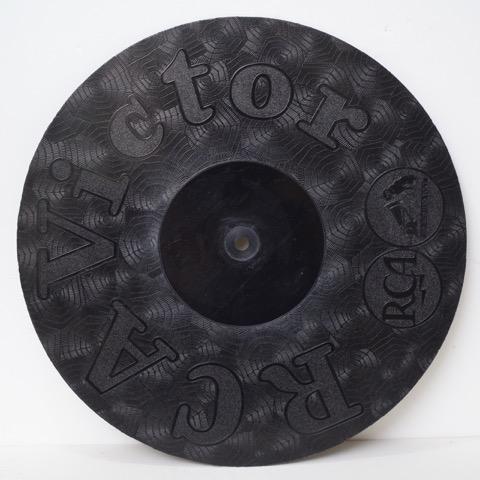
Before he became the house bandleader at the Rhumboogie, Marl Young had written arrangements for the floor show at the Club De Lisa. In the process, he had become tight with Red Saunders and some of the members of his band from the Club DeLisa, where Young and members of the Rhumboogie house band often played the Monday morning breakfast dances. In any case, the recording band is not the same one that Marl Young fronted at the club; it is smaller, there is no sign of Eddie Johnson, who was a featured soloist at the Rhumboogie, and Young made custom arrangements for the recording session.
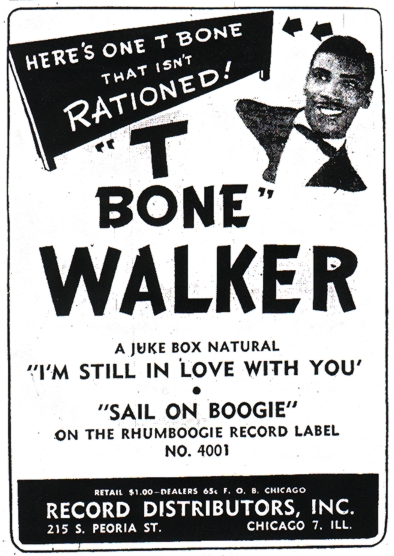
A trade ad from November 17, 1945 has it that "Sail On Boogie" and "I'm Still in Love with You" were paired for release on Rhumboogie 4001. But all extant copies of the 78 are numbered 4000, and the release is listed that way in Blues Research No. 3. Blues Research claimed to derive its release numbers from an undated distributor sheet put out by Record Distributors (839 South Wabash), which listed the three Rhumboogie singles among a series of "Latest Mercury Releases."
A good guess is that Rhumboogie 4000 came out in August 1945, since the Musicians Union heard the Charlie Glenn-Marl Young dispute on August 2 and 16 (and Glenn's name does show up in the composer credits on the records). By November the 78 had reportedly sold more than 80,000 copies. Its success forced Glenn to rethink the nature of his Rhumboogie label; the company had turned into something bigger than a promotional adjunct to his club. Thus, in November of 1945, in a story written up in Billboard, "Click Disk Spurs Rhumboogie Into Natl. Distribbing," he announced that he would be pressing up 150,000 more copies of the first single and expanding distribution for the national market.
Rhumboogie 4000 was reissued on the same brown Rhumboogie label as Rhumboogie M-33 (same tunes, but side designations reversed). Since Rhumboogie 4000 was pressed exclusively on the still-customary shellac and ground limestone, and some copies of M-33 were pressed on vinyl, our surmise is that Mercury put out M-33 in 1948 or 1949, when the move to plastic was under way.
The November 1945 story also announced the impending release of the second disk, "Evenin'" and "T-Bone Boogie" (Rhumboogie 4002). Given the late release of Rhumboogie 4002 it seems likely that Rhumboogie 4003 was put out in early 1946. Rhumboogie 4003 sports a black label instead of the maroon-brown label found on all of the other Rhumboogies that we know. The graphics are the same, however, including the Charlie Glenn beauty in elaborate costume that served as Rhumboogie's logo.
The matrix numbers and release information are largely drawn from the Mosaic booklet. No personnel are given by Mosaic, except for Walker and Young. However, the lineup is identical to that of the December 19, 1945 session as described in the booklet to the Mercury Blues 'n' Rhythm box: two trumpets, three saxes (two altos and a tenor), and rhythm. The altoists do not solo on the October 1944 tracks, but the tenor soloist sounds the same on both sessions.
The previously unknown QB-3312 is a rendition of "Cherry Red Blues" (the only information on the label is the title). When the session took place, the song was still selling for the Cootie Williams band with Eddie "Cleanhead" Vinson doing the vocal honors; their April 1944 release on Hit 7084 was on Billboard's Harlem Hit Parade by May 27, 1944 (p. 18) and would be going strong through January 1945. Perhaps Charlie Glenn decided he would just as soon not try to compete with the Hit release.
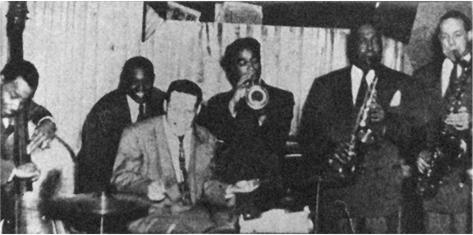
Red's first recordings as a leader were made during his only long absence from the Club DeLisa (a period of nearly two years). A story in Down Beat for August 1, 1945 gives the explanation for his departure. Apparently Red really wanted to entertain the troops overseas and signed up to do a tour with the USO. However, some members of Red's big band "couldn't pass the physical for an overseas tour." (Altoist Nat Jones jumped ship at this point, joining a combo led by Stanley Williams.) After a month without steady work (during which time Leon Washington moved over to Capt. Walter Dyett's DuSable-ites), Red regrouped with a sextet and took a job at the Capitol Lounge on State Street on July 9, 1945 (his 4 week contract, with 3 week option, was accepted and filed by Local 208 on July 19). Even so, Red seems to have been thinking about something bigger: "Saunders, however, still has big-band ideas... Since opening the Capitol, the USO has proposed a tour in the states and Saunders may reorganize to entertain the GI's..." The Stateside USO tour never came off either.
The same Down Beat that mentioned Red's stay at the Capitol Lounge (and reviewed some of their nights there) also commented that the band was "being romanced by Joe Sherman to move into the Garrick when Saunders' contract expires August 6, if the Capitol's three-week option isn't picked up." Besides the favorable attention that the Saunders combo was drawing at the Capitol Lounge, the Garrick was motivated by outside offers being extended to the popular Red Allen-J. C. Higginbotham combo that had been in residency there for over two years. Red did move as soon as his 4 weeks at the Capital were up; his 6-week contract (plus options) with the Garrrick was accepted and filed on August 2, 1945. For the rest of Red's engagements before he returned to the DeLisa, see below.
Meanwhile, Red's place at the DeLisa was taken by a band led by trumpeter Jesse Miller. Miller's contract was accepted and filed by Musicians Union Local 208 on May 17, 1945; his band opened on June 9 and held down the job through the middle of February 1946. Following that Fletcher Henderson (first with Marl Young, later with Sonny Blount at the piano bench) was on the bandstand from February 18, 1946 to May 18, 1947.
From July 9 to August 6, 1945, Red worked the Capitol Lounge with a sextet consisting of George "Sonny" Cohn (trumpet), Antonio Cosey (alto sax and clarinet), Leon Washington, Porter Derrico, and Micky Simms.
Sonny Cohn (born in Chicago on March 14, 1925) was a new addition; freshly back from military service, he had been working in Captain Walter Dyett's DuSable-ites before joining Red, who got the recommendation from Leon Washington. Sonny Cohn grew up on the West Side, picking up the trumpet at the age of 9, when he began playing an instrument that belonged to his father, a postal worker. As a teenager, he was a member of Frances and her Rhythm Kings, a trio that featured his sister Frances on piano and George Rhodes at the drums.
The new Saunders band was reviewed in the "Bands Dug by the Beat" column (Down Beat,August 1, 1945). "Saunders, a personable front man, is an exceptionally fine drummer and the fine spirit and drive the six-piece outfit obtain comes mainly from his drums.... Majority of the solos go to tenorman Leon Washington, who plays with more [of] a jazz conception than the others. One night Eddie Johnson was found subbing on tenor—his solo on Sunny Side of the Streetwas one of the greatest this reviewer has ever heard for the tune. Trumpet man is 18-year-old Sonny Cohn and real comer. Kid is featured on such stuff as Fiesta in Blues." (Red found it useful for publicity reasons to shave a couple of years off Sonny Cohn's age.) The only objection the reviewer had was that the front line tended to play too loudly in the small club, as if overcompensating for being downsized.
The Garrick Theater Lounge picked up Red's sextet during the second week of August 1945. A photo of the lounge in Dempsey Travis' book, An Autobiography of Black Jazz, shows several advertisements in the front window for Red Saunders featuring Leon Washington and Sonny Cohn. Red settled in for a long run. On October 13, 1945, Down Beatmentioned him in a story titled "Chi's Randolph St. Has No Shortage of Combos." According to Down Beat,"Leading the parade, and it's just that at the Garrick Bar and the Downbeat Room, is Red Saunders' fine six-piece crew, with Red on great drums."
When Red made his first session as a leader he was still working with the same combo at the Downbeat Room of the Garrick Lounge. The alto saxophonist appears in older discographies as Antonio "Cosie" (meanwhile, the Down Beat reviewer called him "Tony Casey").
Antonio Macio Cosey was born in Chicago on March 2, 1906. He was the son of Peter J. and Ana Cosey. In the 1920 census, a 13-year-old "Maceo" Cosey was listed as living at 4619 South Langley Avenue. In 1924, he was playing the mellophone in the University of Chicago band. The 1930 census found the "Cozeys" at 4948 South Forestville Avenue and Antonio M. Cosey's occupation listed as "Musician, Touring Orchestra". The touring soon took him overseas—in 1931 he was accompanying Myrtle Hawkins in Paris. He returned to the United States from the Netherlands on June 4, 1934, aboard the SS Rotterdam, still giving 4948 South Forestville Ave. as his home address. In 1936, he shipped out again, with Leon Abbey's band. On June 23, 1936, he recorded with Jazz Sam Castendet, getting two solos on the tenor sax (all of his recorded work before Red Saunders appears to have been on this instrument). He toured India with Abbey and appeared on a 4-tune session for the Swedish Sonora label—made in Stockholm on July 13, 1938, it consisted entirely of Latin music. However, Cosey also arranged a number called "Whoa Babe" for Abbey, which has been released on a Harlequin LP. He returned to the United States later in 1938. He subsequently played with Duke Ellington, at an unknown date but sometime before the late 1940s. And at some point in the 1940s he married Collenane G. Clark; in 1943 Cosey, Clark, and Louis Jordan were jointly credited with "Ration Blues," which Jordan recorded for Decca, at a session on October 4 of that year.
After leaving the Saunders band, Cosey made one more recording session that we know of, backing Big Bill Broonzy for Mercury on January 4, 1949. Antonio Cosey died in July 1951; he was just 44 years old. (Our thanks to Bob Eagle for his biographical research on Antonio and Collenane Cosey.)
Antonio Cosey was the father of Chicago guitarist Pete Cosey, who was born Peter Palus Cosey on October 9, 1943. Pete Cosey did a lot of studio work for Chess Records in the second half of the 1960s. He was a member of Phil Cohran's Artistic Heritage Ensemble, and of the Pharaohs (the precursor to Earth, Wind, and Fire). He contributed prominent solo work on some live Miles Davis recordings made in 1973 and 1974, shortly before Miles went into temporary retirement.
Antonio's widow Collenane was a partner in the very short-lived Cool label, which released two singles in July 1953 and planned two more that it couldn't afford to release (two of the four tunes on the singles that were released were her compositions). In 1956, she was running a cleaning service in Phoenix, Arizona, but she later returned to Chicago, where she died at age 100 in September 2010. Pete Cosey died in Chicago on May 30, 2012, aged 68.

Theodore Dudley "Red" Saunders (d, ldr); George "Sonny" Cohn (tp); Antonio Cosey (as); Leon Washington (ts); Porter Derrico (p); Mickey Simms (b).
Chicago, December 7, 1945
| S5855 | Hallelujah (Youmans-Grey-Robin) | Savoy 596-B | |
| S5856 | Red's Boogie Woogie (Saunders) | Savoy 596-A | |
| S5857 | Chicago Jam (Saunders) | Savoy (unissued) | |
| S5858 | Sweet Lorraine (Parrish-Burwell) | — | |
| S5859 | Memories of You (Blake-Razaf) | — |
Our basic information comes from Leadbitter, Fancourt, and Pelletier's 1994 blues discography. However, Leadbitter et al. give the wrong A side; they identify it as "Trust in Me," though their matrix number is correct. Michel Ruppli's Savoy discography gets it right, and the listings for the other three items are derived from Ruppli.

Savoy 596 was a 78-rpm single released in 1946. Though the sound we have heard off the original 78 is tinny and shallow, the two issued tracks feature Saunders and Leon Washington (duly featured on the labels), and give some sense of the abilities of both. Washington (born in 1909, already on wax with Frankie Franko's Louisianians in 1930) attacks an uptempo "Hallelujah" (part Swing and part Bop, just like the Red Norvo recording) in the manner of Don Byas.
Bob Porter says that the complete session was still extant in the Savoy vaults in the late 1970s and is presumably still available for reissue. Thanks to Daniel Gugolz for a tape of the three unissued tracks, which have circulated among collectors. "Chicago Jam" is a very different version of the boogie woogie; Derrico stays in the groove more successfully, and Leon Washington is the dominant soloist; Red also gets a powerful drum solo. "Sweet Lorraine" and "Memories of You" both give Leon a chance to do his Hawk thing; why ballad performances of this quality have remained unissued is a puzzlement.
The success of T-Bone Walker's first release on Rhumboogie (Rhumboogies were now being distributed by the up-and-coming Mercury operation) led Charlie Glenn, who ran the label, to bring T-Bone back to Chicago for a second recording session with the same forces led by Marl Young.
T-Bone Walker (el-g, voc); Marl Young (p, dir, arr, bg voc); Melvin Moore (tp, bg voc); Nick Cooper (tp, bg voc); Nat Jones (as); Frank Derrick (as); Moses Gant (ts); Micky Simms (b); Red Saunders (d).
Chicago, December 19, 1945
| 409-2, 1036-SW, IM-493 | My Baby Left Me (Walker-Glenn) | Mercury 8016-A, Old Swingmaster 11A^, Imperial 1561451, Mosaic MR9-130, Mosaic MD9-130 [CD], Polygram 528292 [CD], Indigo IGO CD 2123, History 20.1948-H [CD], Classics 5007 [CD] | |
| 410-2, IM-494 | Come Back to Me Baby (Walker-Glenn) | Mercury 8016-B, Constellation CS-6, Imperial 1561451, Mosaic MR9-130, Mosaic MD9-130 [CD], Polygram 528292 [CD], Indigo IGO CD 2123, History 20.1948-H [CD], Classics 5007 [CD] | |
| IM-495 | I Can't Stand Being away from You (Walker) | Constellation CS-6, Imperial 1561451, Mosaic MR9-130, Mosaic MD9-130 [CD], History 20.1948-H [CD], Classics 5007 [CD] | |
| 411, 1040-SW, IM-496 | She Is Going to Ruin Me [Fast Woman*] (Walker) [ens voc] | Old Swingmaster 11B^, Constellation CS-6, Imperial 1561451*, Mosaic MR9-130, Mosaic MD9-130 [CD], Polygram 528292 [CD], Indigo IGO CD 2123, History 20.1948-H [CD], Classics 5007 [CD] |
T-Bone Walker came back to Chicago to make these sides after the commercial success of Rhumboogie 4000 and his follow-up release of 4002. They were of course done for Rhumboogie; otherwise there was no earthly reason for Charlie Glenn to be listed as co-composer on any of them. (We can see, too, that Marl Young had been duly chastised after the August 1945 dispute; his name is conspicuously absent from the credits.) But the tracks have traveled a tortuous path since then; various enterprising persons have managed to sell 300 or 400 percent of them.
The Rhumboogie matrix numbers are probably irretrievable. We had thought that QB-3307 and QB-3312 might have been remade at this session, but the discovery of a test pressing from October 10, 1944, numbered QB-3312, that was not recut here ("Cherry Red Blues") rules out the remake hypothesis. So we are in the unfortunate position of having lost the original matrix numbers for all four of these sides.
Rhumboogie had some kind of affiliation with Mercury—at least a distribution deal—by November 1945. The 400-series matrix numbers that Mercury put on them date from October 1946, which is presumably when Mercury 8016 came out on 78 rpm.
When Egmont Sonderling started his Old Swing-Master label in January 1949, with DJ Al Benson as his front man, he made a deal to (license? buy?) the now-dormant Rhumboogie material, and released two sides in March 1949 on Old Swingmaster 11, a 78-rpm single. The 1000-series matrix numbers belong to Old Swingmaster.
While Sonderling was phasing out his record businesses, Old Swing-Master went belly-up in June 1950, amid talk of another release drawn from this material. Shortly thereafter, it appears that Sonderling unloaded the sides to Imperial, which was T-Bone's label at the time; on September 22, 1952, Imperial slapped on matrix numbers of its own (IM-493 through 496, according to Michel Ruppli's volume on The Aladdin/Imperial Labels; the Mosaic box has IM-453 through 456, but these were actually used for sides by Smiley Lewis and Tommy Ridgley). Imperial never released them, but after many mergers and acquisitions, they appeared years later on an Imperial LP put out by French EMI, and finally in a Mosaic box that was mostly derived from material controlled by EMI.
After Sonderling quit the record business for radio, Al Benson, who was doing freelance recording but not quite ready to open his ownParrot label, sold the masters to Art Sheridan of Chance Records, probably in 1952. (According to the late Marcel Chauvard, they were duly listed in the Chance company files, though no new matrix numbers were attached and we have no evidence that Chance released them.) A decade later, Ewart Abner Jr. (of Chance and Vee-Jay fame; he had just been kicked out of Vee-Jay after a management battle) and Art Sheridan (one-time owner of Chance Records) started a company called Constellation. It put out a series of LPs consisting mostly of Chance material. CS-6 was a various-artists blues collection, titled A Bucket of Blues Vol. VI, that was released in 1964. The other tracks were by John Lee Hooker, J. B. Lenoir, and Sunnyland Slim (all of them from the Chance archives).
"I Can't Stand Being Away from You" was issued for the first time on this LP. Most likely it was passed over for release in the 1940s because the second half of the piece is a Swing-band arrangement; consequently it puts less emphasis on T-Bone's vocals and guitar than its session-mates do. Constellation misspelled another title as "She's Gonna Rain Me."
Imperial 1561451 was a various-artists LP issued in France in 1985 under the title Hot Leftovers. Mosaic MR9-130 (LP) and MD6-130 (CD) is a boxed set, released in 1990 under the title The Complete Recordings of T-Bone Walker 1940-1954. Polygram 528292 is an 8-CD box set titled Mercury Blues 'n' Rhythm Story 1945-1955 and released in 1996. Indigo IGO CD 2123, T-Bone Blues is a bootleg release from 2000 with an uncertain country of origin. Classics 5007, T-Bone Walker 1929-1946, is a French reissue from 2001.
The release history is drawn from the Mosaic box. However, Mosaic, following previous discographies, gives only "1945-1946" for the date and states that the band is the same group of unknowns as on the Rhumboogie session. (It does sound like the same lineup as before, though the recording quality is much better on this session than on the indifferently-pressed Rhumboogie 78s that are the only remnant of the previous one, and Micky Simms and Red Saunders are more clearly heard.) The date and personnel are from the Mercury Blues 'n' Rhythm box, which also supplies the Mercury matrix number 411 for "She Is Going to Ruin Me"; the Mercury annotators give Nat Jones' first name as "Nathan."
Meanwhile, Red enjoyed steady work with his sextet at the Garrick Lounge. He was signed to another contract for 11 weeks (posted with Local 208 on December 20, 1945). On March 25, 1946, Down Beat's Chicago Band Briefs listed Saunders at the Garrick. On April 8, Down Beat ran a photo of the band with a long caption: "Red Saunders Garrick's Star. Red Saunders is the current dynamic attraction at Randolph street's Garrick Bar. Red, acclaimed one of the top drummers by all who hear him, has had his fine six-piece combo at the Garrick's Downbeat Room since last August. With Red are Mickey Simms bass; Porter Derrico, piano, Sonny Cohn, trumpet, Tony Casey [sic], alto, and Leon Washington, tenor. Group has been pulling more business than Red Allen-J.C. Higginbotham group..." Sonny Cohn's recollection: "We did well at the Garrick and stayed there almost as long as Red Allen did. It was one of the first of the real jazz clubs where people came to sit down and listen to the music. We'd play 40 minutes and 20 minutes off. There was no show; we had a little [sheet] music but we mostly played head arrangements or features for the guys in the band" (Peter Vacher, The Sonny Cohn Story, Jazz Journal, September 1963, p. 5).
On May 6, "Chicago Band Briefs" reported that altoist Nat Jones was rejoining Saunders at the Downbeat Room. This was the band that recorded for Sultan Records.

Red Saunders (d, voc, ldr); George "Sonny" Cohn (tp); Joseph "Buster" Bennett (voc, as -1); Nat Jones (as); Leon Washington (ts); Porter Derrico (p); Mickey Sims (b).
Chicago, May 1946
| S-109-1 | Red, the Be Bop Guy ("Saunders") -1 | Sultan 2501B | |
| S-111-1-1 or S 111-1-2 | Vi, Tell Me Why (Dean-Saunders) | Sultan 2503A |
An advert for the Sultan label in the June 8, 1946 issue of Billboardclears up some details. The Sultan gimmick was "double-header hits," which meant sides by two different bands. "Red, the Be Bop Guy" was the B-side of Sultan 2501 (not 2502 as listed in discographies); the A-side was "Orientale" by the Eddie Wiggins Sextette. "Vi, Tell Me Why" shared its "double-header" disc with "Sonny's Boogie" by Sonny Thompson, who was billed for the occasion as "Prince of the Ivories."
Sultan 2501 and 2503 were 78-rpm singles, released in June 1946. The debut release of 3 singles was pretty much it for Sultan. The company apparently recorded Chet Roble's trio in July 1946 but didn't release anything. Otherwise Sultan recorded a bunch of sides on a cantor at a Detroit synagogue (most were unloaded to another company) and one single by a country artist. By the middle of 1948 Sultan was done recording, though its proprietor If the Saunders band recorded more items for Sultan (we wonder about matrix S-110 and matrix S-112), these appear to be lost. A copy of Sultan 2501 in Tom Kelly's collection supplies the label copy (including the revelation of a unique Red Saunders vocal on "Red, the Be Bop Guy") and the matrix number. "Vi, Tell Me Why" appears on one side of Sultan 2503 (a copy in George Paulus' collection has the -1 suffix after the matrix number; Dani Gugolz' copy has the -2; these may simply be different stampers.)
Unsuspected for many years was an unnanounced musical guest on "Red, the Be Bop Guy." A dub supplied by Tom Kelly reveals that Sultan was indulging in false advertising when it attributed the vocal to Red. The vocalist is none other than Buster Bennett and the tune is a fairly fast blues of the "celebrity roast" variety.
He's hip and he's handsome, he's mellow and fly
Yes, he's hip and handsome, he's mellow and fly
The gals all call him Red the bebop guy
He has so much trouble to keep the chicks from his flat
Yes, so much trouble to keep the chicks from his flat
He has to beat 'em off with a baseball bat...
You may think he's boasting, he's just a big sack of wind
Yes, he's boasting, he's a big sack of wind.
Then he's the biggest sack since time began.
The words are obviously Buster's, and could well have been improvised at the session—but Red took the composer credit. Some of the riffing between Buster's vocal lines would reappear when Red's combo backed Big Joe Turner in October.
Sonny Cohn has a prominent trumpet lead in the introduction and the tag. In the middle of the piece, there are two 12-bar solos on the alto saxophone. The first solo, stuffed with 8th and 16th notes in the mid-1940s Tab Smith manner, is obviously the work of Nat Jones. The second 12 bars are strictly gutbucket and enunciated with a rasp—Buster's doing. And the second solo ends with a rest (to give Buster time to take the sax out of his mouth and resume singing). Buster also briefly joins the closing ensemble. Our thanks to Armin Büttner for catching Buster's presence on this side.
Nary a trace of bebop can be found on "Red, the Be Bop Guy," but the band eventually mastered the style (see the Supreme session below).
The Billboard ad and the label for "Vi, Tell Me Why" mention "Nat Jones on the sax," rendered on the label as "Nat Jones on Sax." Vi Kemp, a contortionist and singer, was Red Saunders' wife. She is mentioned in many subsequent Chicago Defender advertisements for the Club DeLisa (May 17, 1947, December 18, 1948, and December 31, 1949, among others). "Vi, Tell Me Why" was a rather sappy ballad dedicated to Vi, but not featuring her. As promised, Nat Jones has the schmaltzy alto sax lead and the frilly conclusion; there is also a brief trumpet lead from Sonny Cohn.
After leaving Red, Porter Derrico worked the Chicago clubs as a leader for 5 years, until he fell seriously ill in 1951. After 19 months in the Municipal Tuberculosis Sanitarium he would be reinstated as a member of the Musicians Union Local 208 on January 22, 1953. Derrico returned to the music scene for a few years, but in 1957 he was diagnosed with chronic glomerulonephritis, a disease that in those days was inevitably fatal. His day job, before he became too ill to work, was as a laborer for a cabinet business. Suffering from kidney failure, Porter Derrico died at Louise Burg Hospital on May 27, 1961; he was 47 years old (we got our information from his Local 208 file card and his death certificate).
On July 1, Down Beat's Chicago Band Briefs still had Saunders at the Downbeat Room. In fact, Saunders remained there until Joe Sherman closed down the Garrick Bar and Downbeat Room, as announced in a Down Beatitem on September 23, 1946.
The Down Beat writer stated that the the Saunders band "which had been at the Downbeat Room for over a year," had taken an out of town gig. In his "Swinging The News" column in the October 12, 1946 Defender, Al Monroe declared that "Red Saunder's [sic] terrific drumming at Kelly's Stables in New York where he is co-starred with Savannah Churchill may net him [a] Hollywood contract." Cohn recalled that "When the Garrick closed down, we went to New York for 6 weeks and worked the Kelly's Stables. Working opposite us we had the Mary Osborne Trio." (Vacher, p. 5).
Also in September 1946, pianist and arranger Marl Young, who had recently left the Fletcher Henderson Orchestra then performing at the Club DeLisa (long hours backing the DeLisa shows did not mix well with the law school courses he was taking at the same time), went into business with his brothers and opened a new record company, Sunbeam. Since Red Saunders had appeared on Young's sessions for Rhumboogie, and Nat Jones worked the Sunbeam sessions, some have thought that Red could be the drummer on the Sunbeam sides by Marl Young and his Orchestra. But, as we note on our Sunbeam page, Oliver Coleman was the drummer on the Marl Young-led sessions for that label, most of which were made while Red was out of town.
Because Red's band was in New York for 6 weeks, it is now clear that the two Joe Turner sessions were actually recorded there, not in Chicago as previously thought. (Strangely enough, Big Joe headed to Chicago to work the Club DeLisa as soon as the sessions were finished, which has contributed to confusion about the location. Red, of course, was not at the DeLisa in October 1946; Big Joe was accompanied by Fletcher Henderson during his stay.) Previous discographies (including previous versions of this one) have credited Talmadge "Tab" Smith with the Johnny Hodges-inspired alto work on the next two sessions. This attribution would fit not only the style of the alto playing but the fact that Tab Smith's band was resident in New York City at the time. However, Sonny Cohn recalled in his 1963 interview that Porter Kilbert joined Red Saunders in New York City. Kilbert also appeared on a Coleman Hawkins date for Sonora, which was made in New York a few weeks before the Big Joe Turner dates. And in fact, we have no evidence of Porter Kilbert spending a whole lot of time in Chicago until the Saunders band returned there at the beginning of 1947. Also a Hodges-style altoist, Kilbert was born in Baton Rouge, Louisiana, on June 10, 1921. Already a veteran of bands led by Benny Carter and Roy Eldridge, he added a significant solo voice (a little more incisive than Nat Jones') to Red's combo.
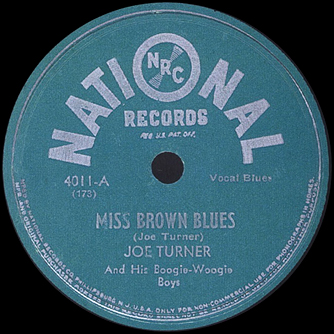
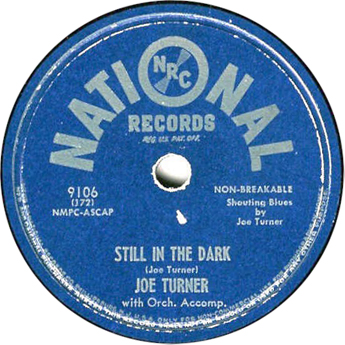
Joe Turner (voc) accompanied by Red Saunders (d, ldr); Sonny Cohn (tp); Porter Kilbert (as); Leon Washington (ts); Albert Ammons (p); Ike Perkins (eg); Mickey Simms (b).
New York City, October 11, 1946
| NSC172 | Still in the Dark (Turner) # | National 9106, Savoy MG14012, Realm [Br] RM 229, Savoy SJL2223, Savoy SJC 405, Savoy Jazz SV-0265 [CD], Classics 1034 [CD] | |
| NSC173 | Miss Brown Blues (Turner)^ | National 4011-A, Savoy MG14012, Realm [Br] RM 229, Savoy SJL2223, Savoy SJC 405, Savoy Jazz SV-0265 [CD], Classics 1034 [CD] | |
| NSC174 | Sally Zu-Zaz (Turner) | National 4016-B, Savoy MG14012, Realm [Br] RM 229, Savoy SJL2223, Savoy SJC 405, Savoy Jazz SV-0265 [CD], Rhino / Atlantic 71550 [CD], Classics 1034 [CD] | |
| NSC175 | Rock o' Gibralter (Turner) | National 4016-A, Savoy SJL2223, Savoy Jazz SV-0265 [CD], Classics 1034 [CD] | |
| NSC175 [alt.] | Rock o' Gibraltar Blues (Turner) | Savoy MG14012, Realm [Br] RM 229, Savoy SJC 405, Document DOCD-1008 |
Red Saunders had previously worked with Albert Ammons, as we know. National 4011 and 4016 were 78-rpm singles released in 1947; National 9106, which is pressed on vinyl, followed around 1950. The titles and band credits have been variously rendered in secondary sources. We show them as the appeared on the original 78s, misspellings and all; our thanks to Michel Chaigne for the label information. (We take the word "Blues," appended to some of the titles with a dash, as a generic designation rather than part of the title proper.)
On the Rhino/Atlantic Joe Turner package, the title goes "Sally Zu-Zazz-Blues"; elsewhere, "Sally Zu Zazz" has prevailed. "I'm Still in the Dark" has been the usual reissue title.
Reissues of this material did not begin until Savoy surfaced with most of the National masters in 1957 (where they had been for six years, we do not know; National went out of business, very quietly, in June 1951).
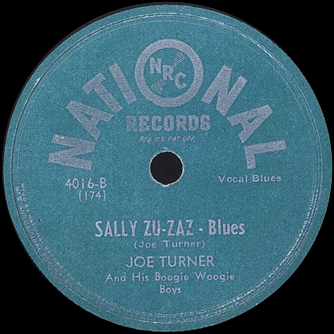
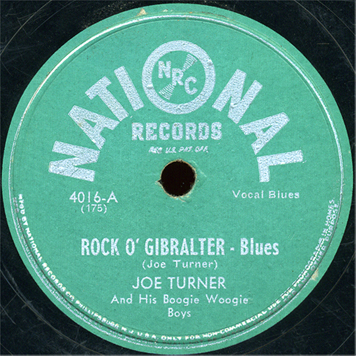
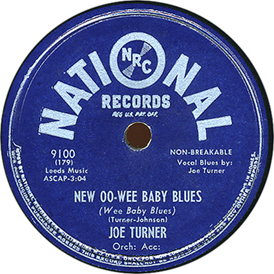
Thanks to Daniel Gugolz for alerting us to the alternate take of "Rock o' Gibraltar Blues." Apparently this take was used on Savoy MG14012. Document DOCD-1008 was released in 1994 as Albert Ammons (1936-1946): Alternate Takes, Radio Recordings, Ammons' Unissued Home Recordings. Classics 1034 was released in 1999 as The Chronlogical Joe Turner, 1946-1947.
Joe Turner (voc) with same accompaniment, except Rudy Martin (p) replaces Albert Ammons.
New York City, October 12, 1946
| NSC176 | Milk and Butter Blues | Savoy MG14012, Realm [Br] RM 229, Savoy SJL2223, Savoy SJC 405, Savoy Jazz SV-0265 [CD], Classics 1034 [CD] | |
| NSC177 | That's What Really Hurts (Turner) ^ | National 4017, Savoy MG14012, Realm [Br] RM 229, Savoy SJC 405, Savoy SJL2223, Savoy Jazz SV-0265 [CD], Classics 1034 [CD] | |
| NSC178 | I'm Sharp when I Hit the Coast ^ | National 4011-B, Savoy MG14012, Realm [Br] RM 229, Savoy SJC 405, Savoy SJL2223, Savoy Jazz SV-0265 [CD], Classics 1034 [CD] | |
| NSC179 | New Oo-Wee Baby Blues (Wee Baby Blues)* (Turner-Johnson) | National 9100, Savoy MG14012, Realm [Br] RM 229, Savoy SJL2223, Savoy SJC 405, Savoy Jazz SV-0265 [CD], Rhino / Atlantic 71550 [CD], Classics 1034 [CD] |
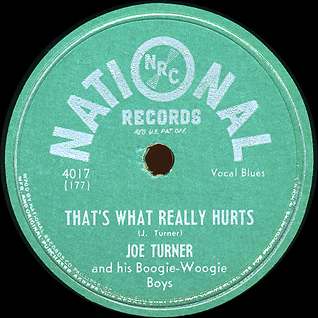
Our basic information comes from Michel Ruppli, The Savoy Label. Ruppli gives the title of the last track as "Ooh Wee Baby Blues" but the Savoy 2-LP set gives it as "New Wee Baby Blues." The Rhino Joe Turner box actually follows the original label to National 9100: "New Oo-Wee Baby Blues (Wee Baby Blues)." The Savoy LP label rendered it as "Ooowee Baby." Ruppli gives "That's When It Really Hurts," but the label to National 4017 has it as "That's What Really Hurts."
National 4011, 4016, and 4017 were 78-rpm singles released in 1947; National 9100 and 9106 were pressed on vinyl and released around 1950. On the B-side of 4011, the title is "I'm Sharp when I Hit the Coast"; the Savoy LP and all subsequent listings have misrendered the title as "I'm in Sharp...". The band identification on 4011 is courtesy of Michel Chaigne.
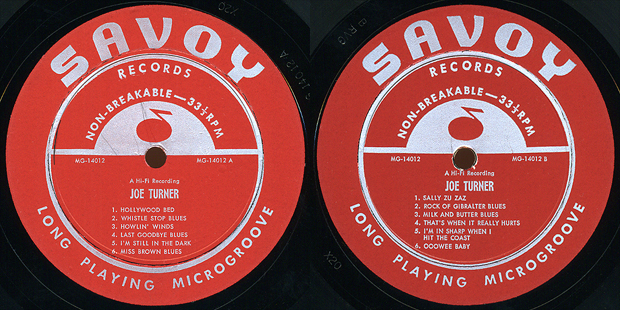
After Savoy acquired most of the National masters in 1957, all 8 sides from the two sessions were released on LP as Savoy MG14012, and the Blues'll make you happy too. This LP was in the Savoy Religious Series (!) and came out in 1960. MG14012 was given a straight reissue in 1965 by Savoy's British licensee as Realm RM 229, Joe Turner Sings the Blues Volume 2, and in 1985, under the original title, on Savoy Jazz Classics SJC 405. All titles from MG14012 were also reissued on Savoy SJL2223, a 2-LP set titled Have No Fear, Big Joe Turner Is Here, in the late 1970s. All titles from that 2-LP set, except 5 tracks recorded in late 1947, were reissued in turn in 1995 on Denon/Savoy Jazz SV-0265 [CD], with the same title. Two titles from these sessions were included in the 3-CD box on Rhino 71550, titled Big, Bad, and Blue: The Big Joe Turner Anthology. Classics 1034, a CD titled Joe Turner 1945-1947, was issued in 1999.
Only Ammons and Saunders are identified in Ruppli, or in the liners to the Savoy 2-LP set (which were written by Pete Welding but not credited to him). The Savoy liners correctly note that Ammons was only present on the first date. They suggest Perkins' presence, which seems correct. Leon Washington and Sonny Cohn were identified by ear; the bassist is old-fashioned and rather plunky, as Simms was on the 1945 session. While the pianist does sound rather like Porter Derrico on his known recordings, it is much more likely that Rudy Martin traveled to New York with the Saunders band.
Pete Welding was the first to suggest, in the liners to the Savoy 2-LP set, that the Hodges-like altoist was Tab Smith (1909-1971). This is is a tempting identification, and not just for the above-mentioned reasons. When Tab began his popular series of recordings for United in 1951, he wasn't carrying other horn players in his working bad, so in the studio his front-line partners were... Sonny Cohn and Leon Washington! They appeared on his first 4 sessions, through June 11, 1952. However, Porter Kilbert sounded a lot like Tab in 1946, and he joined Red during the run on 52nd Streeet.
Red's combo did not return immediately to Chicago. Though the door was open, he was not yet at the Band Box on November 18, 1946, when Down Beat ran a small story titled "Band Box Sticks to Sepia Orks for Draw." The gist was that the club "which has done badly with such bands as [Ina Ray] Hutton and [Freddie] Slack, may stick to a Negro band policy. Seems like there are practically no white bands that draw more than flies." The Chicago Herald-American for November 27, 1946 reported that Joe Sanders had opened at the Band Box the previous week.
In the meantime, Red and his combo made a stop in Detroit, where the Michigan Chronicle advertised them for 3 straight weeks, December 14, 21, and 28, at Club Zombie, 8825 Oakland. The ads promoted "Red Saunders and his great entertainment band" with "the original 'Hey-Bob-a-Le-bop' Girl, D's own, Tina (Push 'em-Up) Dixon" for "2 shows nitely, 11-1, Sun 3 shows" and "Beginnning Fri Dec 13, held over by popular demand, The Willie Anderson Trio." (Our thanks to Lars Bjorn for the references. Sonny Cohn recalled in his 1963 interview [Vacher, p. 5] that the band "worked in Detroit for about three or four weeks" but placed this trip after the engagement at the Band Box.) Club Zombie had opened on November 29.
Red and band returned to Chicago at the beginning of January 1947 (his contract with the Band Box had already been signed and included in Local 208's list of contracts accepted and filed on December 19, 1946). The January 15, 1947 issue of Down Beat mentioned that he was now at the club. "Randolph Street, usually the mecca for music hot, is almost barren." The only exceptions the writer noted were the Saunders combo and two little units next door at the Brass Rail.
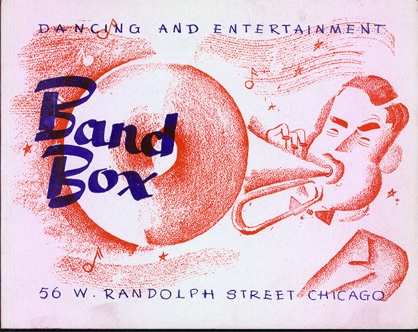
An advertisement from the Chicago Defender of February 22, 1947 refers to the club as "Red Saunders Band Box," suggesting a substantial investment on his part. As of this date, the lineup included "Red Saunders and his Drum Band," Lonnie Simmons and his recording band, Viola Kemp, and a jam session led by Leon Washington. A photo that appeared in the newspaper on April 4 (in which Red is among the judges in a beauty contest!) also gives Red's affiliation as the Band Box. On April 9, 1947, the first Chicago Band Briefs column that Down Beat had bothered to run since October declared that in the meantime Chicago had turned into a "square town" mired in jazz apathy. Saunders, however, was mentioned still playing at the Band Box. Sonny Cohn recalled that "We stayed at the Band Box for about four months" (Vacher, p. 5). On April 19, the Band Box quit being a "swing palace": "The last holdout in the swing vs. sweet fracas capitulated this week when the Band Box, Loop nitery, dropped Red Saunders' jazz group in favor of Correy Lynn's six-piecer." The intermission music was also now in the hands of a pop combo ("Swing Loses Out to Sweet at Loop Band Box in Chi," Billboard, April 26, 1947, p. 36). When Red was set to return to the Club DeLisa, the Defender of May 17, 1947 proclaimed that he had been "scoring at the Loop Band Box cafe."
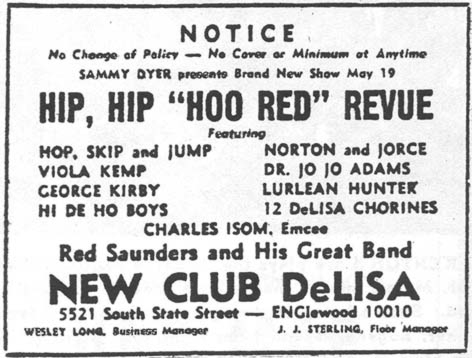
So after an unanticipated vacation, Red resumed at the Club DeLisa on Monday, May 19, 1947, where he was welcomed with a "Hip, Hip 'Hoo Red' Revue." According to Cohn, Red bulked up to big band status (12 pieces) immediately. In 1963 Cohn recalled the personnel as five brass, four saxes, and 3 rhythm. The trumpets were himself, Nick Cooper ("fine trumpeter and arranger, used to write a lot for the band, dead now"), and Charles Gray ("a very good first trumpet player, whose son [Cohn should have said father!] is President of Local 208"). Trombones were Harlan "Booby" Floyd and Joe McLewis. The sax section now consisted of Porter Kilbert on 1st alto, Leon Washington on tenor, Everett Gaines, who doubled alto and tenor, and a "3rd alto" that Cohn couldn't remember (this was Mac Easton, who played a lot of alto as well as baritone). Earl Washington and Jimmy Richardson rounded out the rhythm section.
The band's new lead trumpeter, Charles Gray, was born on September 7, 1918 (we don't have a place of birth for him, but his father was originally from Tennessee and did not join Local 208 until 1928). The previous year, Gray had recorded two sessions with Buster Bennett; Rhumboogie had made him the nominal leader on one of them, since Buster was under contract to Columbia.
Skilled as he was at business and public relations, Red Saunders was rarely called on the carpet by Local 208 of the Musicians Union. However, on October 26, 1947, he found himself in the middle of a turf battle between Harry Gray, President of Local 208, and both the segregated White local in Chicago (Local 10) and the national office of the American Federation of Musicians. Down Beat magazine had organized a jazz concert at the Civic Opera House in Chicago, to include some of the more prominent musicians working on the South Side: Jesse Miller (trumpet), Johnny Board (alto sax), Gene Ammons (tenor sax), Rozelle Gayle (piano), Floyd Smith (electric guitar), Gene Wright (bass), and Red Saunders (drums). Problem was, there were plans to include pianist and arranger John Malachi, and he had shown up in Chicago to play a gig at Club Silhouette without reporting to Local 208 or depositing a contract. Hence Gray had ordered members of Local 208 not to work with Malachi. But Gray had been overruled. All of this came out at the next meeting of the Local 208 Board on November 6.
Red Saunders, speaking for the group, stated that he had not intended to report [for the concert]. He received a telephone call, as did the others, to the effect that they should appear, and that if they were not able to contact President Gray for clearance, they would not have to play. When they all arrived, Vice-President Baumann of Local 10 told them that the Civic Opera House had been removed from the Unfair List, and they could play, as he would assume all responsibility. They still refused. Another call was made to President Petrillo [in New York City] and he told them to perform, which they did.
The members were severely reprimanded by President Gray and excused.
Gray may not have liked it one bit, but the conflict had been escalated all the way to James Caesar Petrillo, President of the AFM. Petrillo had ruled against him—and there wasn't a whole lot he could do about that.
The first Saunders recording session to use the big band (November 1947) featured an outfit of less than Kentonesque proportions: 2 (sometimes 3) trumpets, 2 trombones, and 4 saxes. As Saunders told Hodes, "The band varied. At its lowest I had eight men [actually 7]. Tops was 13—four reeds, five brass, three rhythm [not counting himself]." But on most recording sessions the forces were reduced. Red's next session was the first to feature baritonist McKinley Easton, who was born in Mississippi on April 6, 1914. Easton was already a veteran by this time; he had been elected to membership in Musicians Union Local 208 on March 31, 1932. There was turnover in the rhythm section as well. Earl Washington (not related to Leon, as it turns out; Earl Washington was born in Chicago on April 3, 1921) had taken over the piano bench. Earl's sister Ella married a brother of Red's. Veteran bassist Micky Simms, who must have sounded plunky and dated by this time, was replaced by Jimmy Richardson (who was born on January 4, 1914, according to the Musicians Union Local 208 card file). And trombonist Joe McLewis seems to have been quickly replaced by Johnny Avant.

Edward "Bunky" Redding (voc) with Red Saunders and his All Stars: Red Saunders (d, ldr); Sonny Cohn (tp); Porter Kilbert (as); Leon Washington (ts); McKinley Easton (bars); Earl Washington (p); Ike Perkins (eg); Jimmy Richardson (b).
Toogood Studios, Chicago, November 1947
| 475-2 | Bunk's Blues | Aladdin 210 | |
| 476-1 | My Gal Lil | Aladdin 210 | |
| 477-3 | Freight Train Blues (Redding) | Score 4001B | |
| 478-4 | Card Playing Blues | Score 4001A |
This session is listed in Michel Ruppli, The Aladdin and Imperial Labels. Aladdin 210 was a 78-rpm single released most likely in the early months of 1948. Aladdin, formerly Philo, had started with a 100 series, which was now winding down; only 211 and 212 were to follow. Aladdin 210 is much scarcer than Score 4001. Score 4001 was a 78-rpm single released in May 1948 (it was listed in Billboard for May 8, 1948, p. 126, and reviewed on May 29, p. 138; reviewed in Cash Box on May 15, 1948). No reissues of either are known. Ruppli leaves out Ike Perkins, but his guitar is audible on both sides of Score 4001. We still have not heard Aladdin 210.
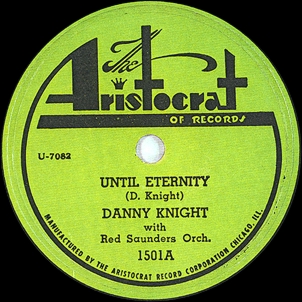
Danny Knight (voc) with Red Saunders Orchestra: Red Saunders (d, ldr); Charles Gray (tp); George "Sonny" Cohn (tp); Nick Cooper (tp); Johnny Avant (tb); Harlan "Booby" Floyd (tb); Porter Kilbert (as); Everett Gaines (as, ts); Leon Washington (ts); McKinley Easton (bars); Earl Washington (p); Jimmy Richardson (b).
Universal Recording, Chicago, November 1947
| U-7082 | Until Eternity (Knight) | Aristocrat 1501A | |
| U-7083 | Say You Love Me Baby | Aristocrat 1502 [?] | |
| U-7084 | It Happened a Year Ago Today (Knight) | Aristocrat 1501B | |
| U-7085 | Time to Part | Arisocrat 1502 [?] |
Thanks to Tom Kelly for confirming the existence of this previously legendary session, and providing some splendid documentation along with a dub. Danny Knight was mentioned in the Chicago Defender during 1945, as a blues singer with the King Kolax Orchestra of the period. By 1947 he had gone the Mr. B route. Some authorities believe that he sang with Howard McGhee and Charlie Parker at the Hi-De-Ho Club in Los Angeles during March 1947, appearing fragmentarily on the Dean Benedetti recordings. Both sides of Aristocrat 1501 are ripe ballads in the Mr. B manner.
For the approximate date of this session, see our Aristocrat page. The Chicago Defender's ad for the Club DeLisa on November 8, 1947 had Knight performing there along with the comedy ensemble the 3 Chocolateers, Bessie Jackson, and others.
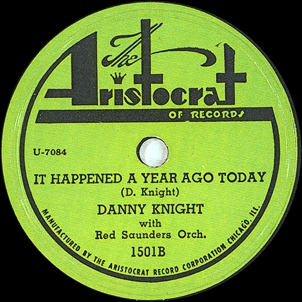
The release date of Aristocrat 1501 is not known; the 78 looks to have been held off till the second half of 1948, as the copy we have seen shows the light green art-deco label that Aristocrat employed for its later releases. The Red Saunders Orchestra is identified on the label. The musicians were identified by ear. Red seems to have brought everyone he had at the Club DeLisa to this session; it is the first one that he made with a big band (in fact, it includes four saxes where his later DeLisa bands usually carried three). There are lush arrangements with no instrumental solos, and Red is restricted to ballad drumming. Each side has a strong trumpet lead. Porter Kilbert, Mac Easton, and Johnny Avant are salient in spots.
Aristocrat 1502 is not known to have been released, but would fill a gap in the series. And even after 22 years at RSRF we are not sure that every Aristocrat release has been catalogued.
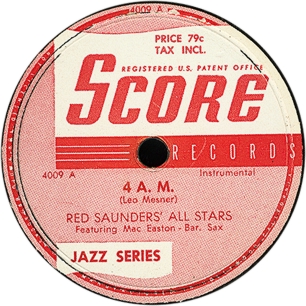
Edward "Bunky" Redding (voc) with Red Saunders and his All Stars: Red Saunders (d, ldr); Sonny Cohn (tp); Everett Gaines (as); Leon Washington (ts); McKinley Easton (bars); Earl Washington (p); Ike Perkins (eg -1); Jimmy Richardson (b).
United Broadcasting Studios, Chicago, December 26, 1947
| 25-1005-1 | Strange Man Blues | Aladdin / Score (unissued) | |
| 25-1006-1 | Young Man Blues | — | |
| 25-1007-1 | Take It Upstairs -1 (Redding) | Score 4009 B | |
| 25-1008-1 | Undecided Blues | Aladddin / Score (unissued) | |
| 25-1009-1 | Walking Card Playing Blues | — | |
| 25-1010-1 | Evil Woman | — | |
| 25-1011-2 | 4 A. M. [Red Saunders Baritone Blues]^ ("Mesner") | Score 4009 A |
This session is also listed in Michel Ruppli, The Aladdin and Imperial Labels. The Score release gives only SC 4009 A and B as matrix numbers; the 25-1000 series numbers, which look like a mutation of UB 2000 series from United Broadcasting but may be of independent origin, were kept in the company files only. In the main United Broadcasting Stuido matrix series, items recorded on December 26, 1947 would have carried numbers in the UB 22400s.
Score 4009 was a 78-rpm single released in December 1949 (it was pressed on vinyl). It was mentioned in Aladdin advertisements in Billboard on December 10 (p. 30), December 24 (p. 31), and December 31 (p. 26). No reissues are known. Ruppli indicates that "Red Saunders Baritone Blues" was the title in the company files, whereas "4 A. M." was the title on the issued 78. The composer credit on this number, to Aladdin impresario Leo Mesner, is, of course, not to be taken seriously. "4 A. M." is the same piece that Red recorded for OKeh on April 20, 1951; that recording also features Mac Easton's baritone sax.
Our personnel are as in Ruppli, except that he omits Ike Perkins. The guitarist is prominent on "Take It Upstairs" and may be present on other tracks from this session (which remain unavailable; we hope they are still extant).
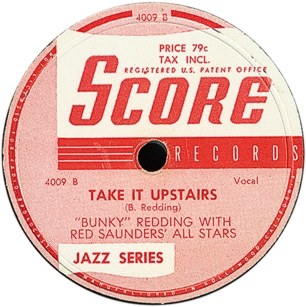
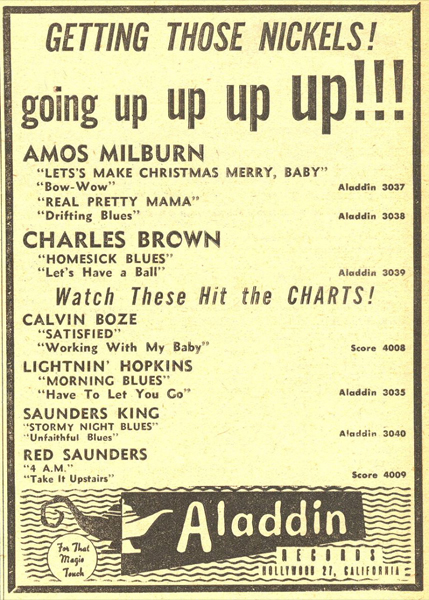
R&B singer Clarence Samuels recorded four tracks for Aristocrat in December 1947 with the "Porter Kilmer" Orchestra. Samuels and alto saxophonist Porter Kilbert were both from Baton Rouge, Louisiana; they almost certainly had worked together before this session. He had previously recorded for the company in early September with a band led by tenor saxophonist Dave Young. Two sides from the December session were released on Aristocrat 1003. A 78 in Dan Kochakian's collection indicates that the session was indeed led by Porter Kilbert. The drums are not well recorded on Aristocrat 1003, but the sax section sounds like the one Red was using at the time, so the possibility that this was an incognito Saunders appearance has to be taken seriously.
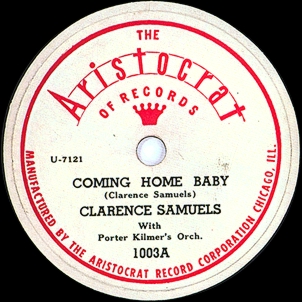
Clarence Samuels (voc); Porter Kilbert (as, ldr); prob. McKinley Easton (as); prob. Everett Gaines (ts); Leon Washington (ts); prob. Earl Washington (p); prob. Jimmy Richardson (b); prob. Red Saunders (d).
Universal Recording, Chicago, late December 1947
| U-7120 | Get Hep to Yourself | Aristocrat 1002 [?] | |
| U-7121 | Coming Home Baby (Samuels) | Aristocrat 1003A | |
| U-7122 | Baseball Blues (Fenner) | Aristocrat 1003B | |
| U-7123 | Juana | Aristocrat 1002 [?] |
Our information about this recording comes from Dan Kochakian, George R. White, and Tom Kelly. See our Aristocrat discography, http://campber.people.clemson.edu/aristocrat.html, for more about the recording and release dates.
The lineup was identified by ear. Kilbert solos on "Baseball Blues"; there are tenor saxophone solos on both sides ("Coming Home Baby" doesn't sound like Leon Washington, whereas "Baseball Blues" could be his work). The four-man sax section sounds like the one Red Saunders was using at the time; the only thing missing is some baritone from Mac Easton. Aristocrat 1003 was a single released in February 1948; no Aristocrat 1002 has turned up, but a release containing "Get Hep to Yourself" and "Juana" would fill a gap in the releases and remains a mild possibility.
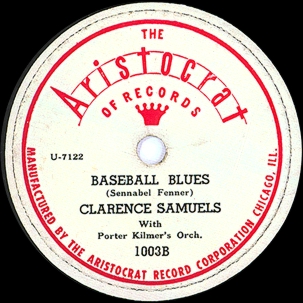
By this point, Red's band had attained its peak size and he was well used to the routine at the Club DeLisa: "You know we'd have a line of gals—10, 12. Six or seven acts, variety show, dance, song, comedy, etc. Names? Billy Eckstine, Baby Laurence, George Kirby, Lurlean Hunter, Joe Williams, Chippie Hill, Joe Turner. Breakfast show Sunday night (really Monday morning)—6:30 a.m., close at 8:30. But the Sunday matinee would start at 5 p.m. So you'd go from 5 p.m. Sunday to 8:30 the next day. And then you'd hang out till noon or go to another joint" (Hodes article, p. 19).
Charles Gray didn't make the recording sessions that called for a smaller unit, so we aren't quite sure when he left. But on the next session Fip Ricard (see below for a capsule bio) had definitely moved in.
Theodore "Red" Saunders (d, ldr); Nick Cooper (tp); Fortunatus Paul "Fip" Ricard (tp); Sonny Cohn (tp); Harlan "Booby" Floyd (tb); John Avant (tb); Porter Kilbert (as); Everett Gaines (ts, as); Leon Washington (ts); McKinley Easton (bars); Earl Washington (p); Jimmy Richardson (b); George Floyd (voc); George Kirby (voc); Sonny Blount (arr -1).
Chicago, December 15, 1948
| SU-180 | Trust in Me (Wever-Schwartz-Ager) [GF voc] -1 | Supreme 1523-B | |
| SU-181 | Synthesis (Ventura) [ens voc] -1 | Supreme 1523-A | |
| SU-? | unidentified title ["Synthesis"] -1 | Night Train International CD 7027 | |
| SU-? | Legs Gettin' Bigger and Bigger [GK, ens voc] | Night Train International CD 7013 |
We previously estimated December 1948 for the recording date, based on when George Floyd was working the DeLisa. Some sources give December 15, 1948 as the date, which would be a decent approximation in any event.
Supreme 1523 was a 78 rpm single, released in April 1949; it was listed in Billboard on April 30, 1949 (p. 37) and reviewed there on May 7, 1949 (p. 122). Our basic information comes from Leadbitter, Fancourt, and Pelletier, Blues Records 1943-1970, Vol. 2 (1994 edition). Thanks to Anthony Barnett for pointing out this listing, which doesn't mention the vocalist on "Trust in Me" or the band scatting on "Synthesis."
The Supreme labels give George Floyd's name. Floyd was a member of Fletcher Henderson band in residence at the Club DeLisa from Feburary 1946 through May 1947; he is advertised in the Chicago Defender of December 18, 1948 on the bill for a DeLisa show that included Red Saunders' band. Balladeer George Floyd (born in Pelham, Georgia, on July 17, 1912) came to Chicago from Los Angeles with Fletcher Henderson in 1946. Floyd implied in an interview with Charles Walton that all of his sides for Supreme were made in LA; however, there is no evidence that the Red Saunders band ever traveled to the West Coast—and such a trip in 1948 would have required a replacement band for at least a week at the DeLisa. Floyd did travel to the West Coast later when he recorded four more sides for Supreme (matrix numbers SU-210 through SU-213) with a small group led by Henderson; Lord gives February to April 1949 as the date and LA as the location, which make sense because all of the other musicians were regulars on the LA scene. When his style of ballad singing went out of fashion in the early 1950s, George Floyd took a job with a Cadillac dealership. He died in Chicago on April 16, 2000.
George Kirby was born in Chicago in June 8, 1923. A comedian known for his skill at impressions—including singing impressions—he was regularly included in Club DeLisa shows during the late 1940s. His recording debut was actually as a blues singer ("Ice Man Blues" with Tom Archia). According to his obituary in the Seattle Times, "He was best known for impressions of stars such as Jerry Lewis, John Wayne, and Walter Brennan, and for his dead-on takes of women, notably Pearl Bailey, Ella Fitzgerald and Sarah Vaughan." Kirby was a local performer until 1952, when he arrived in Las Vegas with a Count Basie show. Kirby became a headliner in Vegas, and in the 1960s and 1970s made many appearances in widely watched TV venues such as the Ed Sullivan Show and the Tonight Show. For one season, in 1972, he got his own show, Half the George Kirby Comedy Hour. He would be reunited with Red Saunders on a 1974 TV special. In 1977, Kirby sold cocaine and heroin to an undercover policeman and ended up serving 3 1/2 years in prison. Suffering from Parkinson's disease, he died in a Las Vegas nursing home on September 30, 1995. See his Wikipedia entry and "George Kirby, Comedian Who Was 'Copycat' of Yesterday's Stars," The Seattle Times, October 2, 1995 (http://community.seattletimes.nwsource.com/archive/?date=19951002&slug=2144591).
Leadbitter et al.'s listings for Red Saunders, like other mainstream discographies, do not give arranger credits. They also make some noticeable mistakes. Fip Ricard is called "Flip Richard" and John Avant goes as "Joe Avant" throughout the Leadbitter entries. Ricard is often referred to as "Flip" in discographies, though he was actually known as Fip, according to his interview in Jazz Monthly, February 1964.
Fortunatus Paul Ricard, was born in Chicago on April 4, 1923, the son of Albion and Thelma Ricard. He benefited from the band instruction at Doolittle Elementary School and Wendell Phillips High School, and attended Roosevelt University (see "'Fip' Ricard," Los Angeles Sentinel, July 11, 1996, p. A18). Fip was in Buster Bennett's band in the early part of 1948, not long before he joined Red Saunders.
Chris Trent believes that "Trust in Me" was arranged by Sonny Blount, and rlc concurs. The arrangement is very much like the arrangements for "Hour of Parting" and other ballads from Sun Ra's Sound Sun Pleasure!! session.
"Synthesis" is an orthodox bebop number, written by Charlie Ventura during his "bop for the people" phase. The evidence for Sonny Blount's involvement lies in the meticulous arch form: vocal ensemble-alto sax solo-trumpet solo-contrasting instrumental ensemble-tenor sax solo-baritone sax solo-vocal ensemble. Compare "Super Blonde," which was recorded by Sun Ra's 1956 Arkestra.
The piece called "Synthesis" on 1995 on Night Train International CD 7027, Music from and Inspired by Devil in a Blue Dress, is an entirely different performance—of a different piece! (The Night Train CD is a various-artists collection, issued in 1995; the other tracks are by Jimmy Witherspoon, Lowell Fulson, Johnny Otis, Charles Brown, Lloyd Glenn, Frantic Faye Thomas, etc.) The second "Synthesis" is also a bop instrumental, but here the opening is martial trumpets answered by the drums, then a chorus led by the tenor and baritone saxes, with dissonant flourishes from the piano on the bridge. The second chorus is mostly call and response between muted trumpets and the saxes. The third chorus features a baritone sax solo by Mac Easton. The fourth is a trumpet-dominated ensemble with more dissonant piano sprinkles; the final eight bars are a sax-led ensemble (that more than slightly resembles 1956 Sun Ra Arkestral scoring!), then a brief muted trumpet solo (probably by Fip Ricard), then a pretty typical bebop tag.
"Legs Gettin' Bigger and Bigger" was included in Night Train International CD 7013, Swing Time Jive, a various artists collection derived from the Down Beat, Swing Time, Exclusive, and Superior labels. Other artists include Ray Charles, Joe Liggins, Mabel Scott, and the Basin Street Boys. The CD was released in 1995.
The Night Train notes claim that "Legs" was recorded in Los Angeles, but they also claim that the dates with Bunky Redding were cut in LA, so none of this ought to be taken too seriously. Presumably "Legs" is from the same session as the others. There is no evidence that it was released at the time. The lead vocalist on this jivey number is not credited in any surviving documentation, but it sounds as though it was made for George Kirby. "Legs" includes a trombone solo (probably by Johnny Avant) and an alto sax solo by Porter Kilbert. It has a typical smooth Saunders arrangement, no obvious signs of Sonny Blount.
For a couple of months in 1949, Red was absent from the Club De Lisa. Pat Harris' "Chicago Band Briefs" column had "Billie Holiday and Red Saunders, hopefully set to open March 8 for two weeks" at the Music Bowl, a Loop club that had taken over from the Latin Quarter (Down Beat, March 25, 1949, p. 4). But the Music Bowl, one of whose owners had just bailed out, wasn't doing so well, and we doubt the gig took place as planned (ambitiously scheduled future acts, like Charlie Parker, Louis Jordan, and Count Basie, did not play there). Chicago Defender advertisements have Red backing Illinois Jacquet, Savannah Churchill, King Odom, and others at the Regal Theater on May 6, 1949, while Tiny Bradshaw's band was doing the "Easter Varieties" show at the DeLisa on April 30.
It is not clear exactly when the adjustment took place, because Red often did not use all of his horns in the recording studio. But at some point in 1949, the band settled on a trimmer alignment: 2 trumpets, 2 trombones, 3 saxes, and rhythm. When Everett Gaines left the sax section, he apparently wasn't replaced. Red would keep this distribution for a number of years at the DeLisa (and when he put together big bands after 1968, it remained his preferred lineup).
The next session has been listed in Bruyninckx (and successor publications, such as Tom Lord's Jazz Discography) for many years, but we overlooked it because we had no reason to suspect Red's involvement. (Our thanks to Dani Gugolz for alerting us to it.) Bruyninckx puts the session in New York City, but we lack evidence of Red taking an extended hiatus from the Club DeLisa in late January 1950. Billboard briefly noted that Capitol "rhythm and blues head Dave Dexter is in Detroit to wax 'Sugar Chile" Robinson ..." (February 4, 1950, p. 18). Detroit was a shorter train ride away. Also worthy of note is Sugar Chile's subsequent 2-week gig at the Oriental Theatre in Chicago (contract posted with Local 208 on March 2; the engagement ran from March 9 through 22, and even got a mention in Cash Box, March 25, 1950, p. 11). In April 1950 another Billboard item on Robinson referred to "Bouncing Ball Boogie" as "the ditty penned especially for this mighty mite of dynamite by Sharon A. Pease, Chicago pianist and reporter for Down Beat magazine, who created numbers for disks by Julia Lee, Nellie Lutcher, and Two-Ton Baker." Pease, who wrote frequently about Chicago-based musicians, may have had something to do with getting Red Saunders and Jimmy Richardson on the session.

Red was between recording contracts at the time. But so far as we know he got no further calls from Capitol, which was not doing a lot of recording in Chicago.
Frankie "Sugar Chile" Robinson (p, voc); James Richardson (b); Red Saunders (d).
Detroit, January 24, 1950
| 5502 | Say, Little Girl (V. White) | Capitol 897, Capitol C80171, Capitol T-589 [LP], Alabama EPAL335, Duo [Nl] DR3101, Oldie Blues [Nl] OL 2828, Charly CRB 1126, Classics CD 5052 | |
| 5503 | Bouncing Ball Boogie (S. Pease) | Capitol 897, Capitol C80171, Capitol T-589 [LP], Capitol CL13562, Oldie Blues [Nl] OL 2828, Duo [Nl] DR3101, Charly CRB 1126, Classics CD 5052 | |
| 5504-D5 | Rudolph, the Red Nosed Reindeer | Capitol C1259, Capitol 3393, Capitol CAS-3085, Classics CD 5052 | |
| 5505-2D-2 | Christmas Boogie | Capitol C1259, Capitol 3393, Capitol CAS-3085, Oldie Blues [Nl] OL 2828, Duo [Nl] DR3101, Charly CRB 1126, Classics CD 5052 | |
| 5506-1D-2 | Sticks and Stones | Capitol 1060, Capitol LC-6586, Charly CRB 1126, Classics CD 5052 | |
| 5507-2D-6 | The Bases Were Loaded | Capitol 1060, Charly CRB 1126, Classics CD 5052 | |
| 5508 | Broken Down Piano | Capitol 1386, Capitol LC-6586, Oldie Blues [Nl] OL 2828, Duo [Nl] DR3101, Classics CD 5052 | |
| 5509 | I'll Eat My Spinach | Capitol 1386, Oldie Blues [Nl] OL 2828, Duo [Nl] DR3101, Charly CRB 1126, Classics CD 5052 |
The Capitol issues, on 78 and 45 rpm singles, are the originals. Capitol 897 was released in March 1950 (it was included in a Capitol display ad in Billboard, March 18, 1950, p. 21). Capitol 1060 followed in June 1950 (reviewed in Cash Box, July 1, 1950, p. 15). Capitol C1259, obviously, was out in time for Christmas 1950. The last in the batch, Capitol 1386, was released in February 1951. Capitol CAS-1385 was a 1952 single reissue in the company's series of children's records (note Bozo the Clown on the labels). Five tracks were reissued on Oldie Blues OL 2828, "Go, Boy, Go": Blues & Boogie Woogie by Sugar Chile Robinson, an LP released in the Netherlands around 1984. It incorrectly places this session in July 1949 with Leonard Bibbs and Zutty Singleton, and puts Jimmy Richardson and Red Saunders on a 1951 session on which they did not play. Charly CRB 1126 was an LP titled Junior Jump. Classics CD 5052 is a Sugar Chile Robinson reissue package from 2003.
The Classics notes correct a mislisting in Bruyninckx, who has 5504 as another version of "Say, Little Girl." Bruyninckx and Lord both misspell 5507 as "The Basses Were Loaded." Lord is our source for the later Capitol issues, the Alabama, and the Duo.

Frankie "Sugar Chile" Robinson (born December 28, 1938) was a child prodigy who began playing the piano when he was 2 years old, supposedly announcing his interest by attempting to perform "Tuxedo Junction" on the instrument. He won several talent shows and appeared twice on AFRS broadcasts in 1945, when he was 6 years old; on one of them he performed in a trio with Lionel Hampton and on the other he did a piano duet with Harry "the Hipster" Gibson. He played before President Harry S Truman in 1947. Capitol signed him in 1949, cutting four tracks in July of that year with Leonard Bibbs on bass and Zutty Singleton on drums. After the session listed here, he recorded two sides in July 1950 and an extended session in July 1952 with an unidentified rhythm section (many of the tracks from his last session appeared only on an LP, Capitol T-859). Robinson then quit recording, because he wanted to concentrate on going to school (he eventually became a psychologist). He made occasional appearances on piano (as Frank Robinson) through 1956, but after that he did not resume playing in public until 2002.

A few months later, Red Saunders signed a contract with Columbia. With renewals, it would last for three years and bring him the only hit record of his career.
Dorothy Donegan (p) with Red Saunders (d; ldr); Harlan "Booby" Floyd (tb); John Avant (tb); Porter Kilbert (as); Leon Washington (ts); McKinley Easton (bars); Jimmy Richardson (b); prob. Sonny Blount (arr).
Columbia Studio, Chicago, May or early June 1950
| CCO 5156 | D. D. D. (Dorothy Donegan's Doghouse) (Saunders-R. Alan) | Columbia 30223 | |
| CCO 5158 | Ridin' Boogie (Donegan-J. Todd) | Columbia 30223 |
Here is a session never previously mentioned in a jazz discography. Dan Kochakian owns a copy of Columbia 30223, a 78-rpm single. Obviously, the recording date was slightly earlier than the next Saunders session, but the single was released in September. Columbia 30223 was announced in Billboard on September 9, 1950 (p. 49), and reviewed on September 23 (p. 38; the reviewer thought much more highly of "D. D. D."). It was reviewed in Cash Box, whose reviewer liked both sides, on September 16, 1950 (p. 14)
Dorothy Donegan was born in Chicago on April 6, 1922. She was the daugher of Donazell Donegan, originally from Huntsville, Alabama, who worked as a chef for the Chicago, Burlington, and Quincy railroad, and Ella Day, originally from Newton, Mississippi, a part-time maid. She started on the piano at the age of eight, studying under Alfred Simms and Rudolph Ganz, and graduated from DuSable High School, where she came under the wing of Captain Walter Dyett ("His ear," she told Whitney Balliett, "was so sensitive he could hear a mosquito pee on a bale of cotton").
Dorothy Donegan began performing in clubs when she was underage, so her behavior on the gig was closely monitored by Musicians Union Local 208. She made her first recording session, playing solo piano, for Bluebird on January 23, 1942; a slow blues and a boogie were released, while pieces by Chopin and Rachmaninoff were left in the vault. Her idols were Vladimir Horowitz and Art Tatum; Rozelle Gayle brought Tatum to her house. As she described her early work in the clubs to Balliett:
By this time [1942], I was working around the clubs in Chicago, first at Costello's Grill, on North Dearborn. My mother would pick me and my paycheck up, which was a great big thirty-five dollars. Then I was at Elmer's Cocktail Lounge, and after that, for two hundred a week, which was big money, at the Garrick Stage Bar. Red Allen had the band and Alberta Hunter sang. […] My first manager was Joe Sherman. […] I was at the Garrick eight months. Then I went across the street to the Latin Quarter. There were chorus girls, and dancers like the DeMarcos, and comedians like Jerry Lester and Benny Fields and Lou Holtz. (p. 235)
Billboard noted (in its "Off the Cuff" column, December 5, 1942, p. 18) that Donegan was being held over at Elmer's through January 16, 1943. The same column (January 2, 1943, p. 95) announced that she had turned down $200 a week to make a picture for Irving Mills. She was replaced at Elmer's by Martha Davis (with Robert Crum as the "afternoon pianist"; "Off the Cuff," January 30, 1943, p. 19). On February 20, 1943, Billboard announced that she had signed a contract with the Garrick, starting on February 12, that guaranteed her 15 weeks and $3,500 ("Donegan's Chi Deal Has 31/2G Guarantee," Billboard, February 20, 1943, p. 18). While she as at the Garrick, Joe Sherman arranged for her to appear at Orchestra Hall. She was the first Black artist to play a recital there; it was reviewed on the front page of the Chicago Tribune. Her first appearance at the Oriental Theater, where she was featured along with the Duncan Sisters, was a financial success ("Sammy Kaye KO's Chi, 51G; Vaude Bill Pulls Big," Billboard, June 12, 1943, p. 18; ). By the middle of June, she was at the Latin Quarter (for $600 a week, and getting a further opportunity to double at the Regal Theater; "Acts-Units-Attractions-Routes," Billboard, June 19, 1943, p. 20; "Open Field for Graduates: Films, Cafes, Theaters Hunt for Bright Combo "Students," July 17, 1943, p. 20); an item under "In Short" (Billboard, July 31, 1943, p. 36), had her being held over till September. In fact, she ended up working at the Latin Quarter for four months ("Acts-Units-Attractions-Routes," Billboard, November 6, 1943, p. 21). Her agent placed a full-page ad for her in the 1943 Billboard Music Year Book..
In November 1943, Donegan accepted an offer to appear in a film that was relased (around mid-year, after its title slipped by a year) as Sensations of 1945 ("Donegan in 3G Week Film Deal," Billboard, November 13, 1943, p. 19; an arrangement had been made for her to play the Florentine Gardens while working on the movie). She headed out to Los Angeles, taking a gig at the Orpheum Theater starting on January 12 ("Pianists No. 1 in Chi Sector," Billboard, January 8, 1944, p. 28; the start of the Orpheum gig was delayed, because when Donegan and Tiny Bradshaw's band showed up for work on the 12th, the theater's pit band was on strike; "Tiny Bradshaw Stuck when Orp. Pit Ork Strikes," January 22, 1944, p. 13). On March 14 she appeared as part of a show at the Orpheum in Los Angeles, with Andy Kirk's big band, singer June Richmond, and the Golden Gate Quartet (reviewed by Sam Abbott, Billboard, March 25, 1944, p. 26). She was in New York City by the Fourth of July, appearing in a show at the Loew's State Theater that incuded the brand-new film ("Music Hall near Record: Cossacks and '90s Acts High," Billboard, July 15, 1944, p. 26). In the fall, she performed at the new club Zanzibar, which opened on October 6. She was part of an elaborate show featuring Ella Fitzgerald, Peg Leg Bates, the Ink Spots, and the Claude Hopkins band (reviewed by Paul Ross, Billboard, October 14, 1944, pp. 24, 26). In a little while, Donegan was on Broadway, in "Star Time" at the Majestic Theater ("Dorothy Donegan, who stepped in for ailing Berry Brothers for a two-day fill-in, has taken their spot permanently"; "Broadway Showlog," Billboard, November 4, 1944, p. 23). However, she had trouble doing the musical and the show at the Zanzibar; "saloon dinner shows are apt to overlap an 8:40 theater curtain" ("Broadway Showlog," November 11, 1944, p. 29). The show closed on December 9, amid plans to go on the road, with a Boston opening on December 25 ("Broadway Showlog," December 9, 1944, p. 31).
On February 8, 1945, she began an engagement at the Three Deuces on 52nd Street; she was brought in to counter the Downbeat's latest move—it was where Art Tatum was playing ("First 52d St. Booking for Dot Donegan," Billboard, February 3, 1945, p. 23). In March 1945, she was back at both the Regal Theater and the Latin Quarter in Chicago for a spell, with comedian Lou Holtz headlining at the club (reviewed at the Latin Quarter by John Sippel, Billboard, March 24, 1945, pp. 26, 28). In April, she was performing at Orsatti's in Philadelphia ("Off the Cuff," Billboard, April 14, 1945, p. 24). In August, she was at the Oriental Theater in Chicago, adding some singing to her segment. "Her excellent mimicking of Ella Fitzgerald and Lena Horne's vocalizing are [sic] a sleeper item which could grab top hands if she worked the intro slower and the staging were improved" (August 10 show reviewed by Johnny Sippel, Billboard, August 18, 1945, p. 27). In late October, she was back at the Loew's State in New York City ("Music Hall 130G Tops Bow, Roxy Does 96G, Capitol 76G," Billboard, October 27, 1945, p. 38). In the Spring of 1946, she was booked on a concert tour with a trio: 24 dates in a month, including 12 in Canada. "None in the South" ("Donegan Sets Concert Tour," Billboard, March 2, 1946, p. 36).
In 1946, Donegan recorded—it was just her second opportunity—for Continental, a New York-based company. She used a Chicago-based trio with Rail Wilson, bass, and Oliver Coleman, drums. The first two releases, on Continental 6033 and 6034, took place in October (announced in Billboard, October 19, 1946, pp. 30, 31, 101). In 1947, she followed with a solo piano session for the same company; Continental 6051 was announced for released in May 1947 (Billboard, May 3, 1947, p. 33; reviewed in Billboard, May 17, 1947, p. 128). That same month she was again at Loew's State Theater, with Charles Trenet and Milton Douglas (show reviewed by Billboard, May 24, 1947, p. 38; "Benny's 150G and MH's 130 Lift Stem from Doldrums," Billboard, June 7, 1947, p. 39). In October 1947 she was at the Lookout House in Covington, Kentucky, in a show headlined by Cab Calloway and Dusty Fletcher (October 27 performance reviewed by Bob Doepker, Billboard, November 8, 1947, p. 40).
She cut one single (with "Bill, Tiny, Webb") for the Los Angeles-based Miltone label. Perhaps this was done when she was working at Tom Breneman's Hollywood (June 8 show reviewed by Lee Zhito, Billboard, July 3, 1948, pp. 39, 41; as late as 1951, a Billboard reviewer was referring to "her rare Coast appearances"; Joe Bleeden, reviewing an August 13 appearance at the Tiffany Club in Los Angeles, August 25, 1951, p. 36). Or perhaps it was done later. In any event, Miltone 5269 was released in the summer of 1949. Starting on December 24, 1948, she was back in town for the opening of the Music Bowl, in the premises that had housed the Latin Quarter ("Jack Peretz Relights Old LQ as Music Bowl," Billboard, January 8, 1949, p. 14). The Music Bowl would fail within six months; by the end of March Donegan was in New York, at Cafe Society ('In Short," Billboard, March 26, 1949, p. 49; April 3 show reviewed by Bill Smith, Billboard, April 16, 1949, p. 56). Cafe Society brought her back in August with a different show (which included Coleman Hawkins and singer Martha Lou Harp; August 17 performance reviewed by Bill Simon, Billboard, September 3, 1949, p. 38). She was back in Chicago again for a while when she made this isolated session for Columbia.
Personnel on the session were identified by ear; there is a baritone sax solo (definitely Mac Easton) on "D.D.D."; "Ridin' Boogie" includes a tenor solo (Leon Washington) and a muted trombone solo (Booby Floyd). The arrangement is consistent with Sonny Blount's work at the time, and Sun Ra later said in interviews that he admired Dorothy Donegan's playing. Were additional unissued titles were recorded at this session? That missing matrix number (CCO 5157) is tempting.
Donegan next made 10-inch LPs for MGM (1954) and Jubilee (1955). Then she struck a record deal with Capitol, for which she did two 12-inch LPs with a trio in 1958 and 1959. In 1960 and 1962, she made trio LPs for Roulette, and in 1963 for a label called Regina, which at the time was employing a former Chicago label entrepreneur, Mort Hillman. But neither her concert appearances nor her regular mentions in the gossip columns translated into record sales. Nor did they bring her much positive attention from the jazz critics.
In 1962, as tensions were growing at Local 208, Dorothy Donegan brought more negative publicity to Harry Gray's operation. Booked into a new North Side club called the Quid, on a contract that she said was for four weeks at $2500 a week, she got into an immediate dispute with the club's owner. She asked for her entire first week's salary in advance, didn't get it, and the owner allegedly "'told me to wiggle my fanny and sing dirty songs'" (Chicago Defender, August 20, 1962, p. 16). So she quit. Donegan complained that Local 208 lacked the clout of Local 10. She said 208 would require black-owned clubs to post a significant bond before she appeared, but not white-owned establishments like the Quid. "Local 208 exists only to keep a few Negro organizers on their jobs" ("Donegan Charges Musicians Union Is 'Uncle Tom Local'," Chicago Defender, ibid.).
She did not make another commercial recording till 1975, but was subsequently active on a variety of European and New York-based jazz labels, generally in the piano trio format. Only in the 1980s did jazz critics start treating her as a significant contributor to the music. For instance:
Consider what Donegan did with "Green Dolphin Street"—which, as she played it, ought to have been retitled "Green Dolphin Strut."
Beginning with a galvanic Latin vamp, Donegan swerved through any number of quotes from closely and distantly related tunes while her stalwart accompanists, bassist Larry Grey and drummer Joel Spencer, alternately grinned with glee and scrambled to keep up.
But if Donegan has more tricks up her sleeve than Mandrake the Magician, they are very musical ones. Her chief model is Art Tatum, and while she puts Tatum's trap-door harmonic shifts to broad use, the ability to even attempt such stuff is beyond the range of most pianists. (Larry Kart, "Pianist Donegan Still as Sharp as Her Wit," Chicago Tribune, February 24, 1988)
She made her last LP, for Audiophile, in 1995. Dorothy Donegan died of cancer on May 19, 1998, in Los Angeles.
Donegan was one of a handful of musicians covered on this site to get the Whitney Balliett treatment: "Wonder Woman," in American Musicians II: Seventy-One Portraits in Jazz (2nd ed., Jackson: University Press of Mississippi, 1996, pp. 232-238). See also: Clarence Waldron, "Dorothy Donegan: Bouncy as Ever at Age 61," Ebony, December 1983, pp. 87-88, 90, http://books.google.com/books?id=0tgDAAAAMBAJ&pg=PA87#v=onepage&q&f=false; Larry Kart, "Pianist Donegan Still as Sharp as Her Wit," Chicago Tribune, February 24, 1988, http://articles.chicagotribune.com/1988-02-24/news/8804020045_1_dorothy-donegan-jazz-notes-pianists.
Adding a little interest to the next session is the presence of Oran "Hot Lips" Page (1908-1954), the great Swing soloist and blues singer. Lips was in Chicago in March 1950, when his band headlined at the Regal Theater (1 week contract posted with Local 208 on March 2). On April 6, he posted a four-week contract with the Brass Rail (a major jazz establishment in the Loop.) We're not sure what he was doing in town in June, when he sat in for Fip Ricard. He was under contract to Columbia at the time, so it could have been the record company's idea. Unfortunately, Lips got no solos or vocal features.
Red Saunders (d, ldr); Oran "Hot Lips" Page (tp); Sonny Cohn (tp); Harlan "Booby" Floyd (tb); John Avant (tb); Porter Kilbert (as); Leon Washington (ts); McKinley Easton (bars); Earl Washington (p); Jimmy Richardson (b); Jumpin' Joe Williams (voc); Little Miss Sharecropper [LaVern Baker] (voc); Sonny Blount (arr -1).
Columbia Studio, Chicago, June 15, 1950
| CCO 5170 | Blow, "Mr. Low-Blow" [JW, ens voc] -1 (Saunders-D. Williams) | Columbia 30218 | |
| CCO 5171 | Sharecropper Boogie [LB voc] | Columbia [unissued] | |
| CCO 5172 | CHI [Chicago] [JW voc] -1 | Epic E3K 48912 [CD] | |
| CCO 5173 | Lyin' Girl Blues [JW voc] (Saunders-L. Washington-J. Williams) -1 | Columbia 30218, Epic E3K 48912 [CD] |
Columbia 30218 was a 78 rpm single released in August 1950. It was reviewed in Cash Box on September 2 (p. 13). Little Miss Sharecropper was working the Club DeLisa with Red in June 1950, and there was a mention of the session in Billboard (unfortunately, a mention that confused Miss Sharecropper with Miss Cornshucks) on July 15, 1950 (p. 14). Epic E3K 48912 was a collection on 3 CDs released in 1993 and titled The OKeh Rhythm & Blues Story 1949-1957. Session information from Leadbitter, Fancourt, and Pelletier with some help from the Epic booklet. Leadbitter et al. give the matrix numbers as 5120-5123 but on the original labels of Columbia 30218, the matrices are given as 5170 and 5173. Lord lists this session (with the correct matrix numbers) as though it was led by Hot Lips Page!
According to Chris Trent, the voicings on "CHI" and "Lyin' Girl Blues" (especially in the saxes) indicate that Sonny Blount arranged them. In rlc's opinion, "Blow Mr. Low-Blow," though more basic R&B with a long featured solo by Mac Easton, could also be Sonny's handiwork. "Sharecropper Boogie" remains unissued and is unavailable for examination.
Columbia would use singer "Jumpin'" Joe Williams on many of Red's sessions for Columbia and OKeh. Born Joseph Goreed in Cordele, Georgia, on December 12, 1918, Joe came to Chicago with his family as a teenager. After gaining experience in a gospel singing group, he changed his name to Joe Williams and used his smooth baritone primarily in ballad singing. Williams made a single for the short-lived Cincinnati label (in 1944), and three sides in 1948 or 1949 for Melvin Moore's short-lived Glo Tone label. He sang for a while with Jay Burkhart's experimental band, which got good reviews in the jazz press but was too big and too experimental to land a record deal. In a questionnaire for one of Leonard Feather's jazz encyclopedias (the material is now at the Institute for Jazz Studies in Newark, NJ; our thanks to John Szwed for checking the files there), Red Saunders took credit for encouraging Joe Williams to sing the blues. Williams had worked many a night at the Club DeLisa with Red's backing before Columbia saw fit to include him on a Red Saunders recording session. Though Columbia and OKeh did not reap significant commercial success from the combination, not even after his first recording of "Every Day I Have the Blues" (cut for Al Benson in July 1952) sold well for Checker, the decision made perfect sense artistically. Joe Williams became a national star at the end of 1954, when he went on the road with Count Basie.
Miss Sharecropper [LaVern Baker] (voc) with Red Saunders (d, ldr); Porter Kilbert (as); Leon Washington (ts); McKinley Easton (as -1; bars -2); Earl Washington (p); Jimmy Richardson (b); Sonny Blount (arr).
Chicago, December 1950 or January 1951
| NSC668 | Take out Some Time -1 | National 9153, Savoy SJL2256 | |
| NSC669 | I've Tried -1 | National 9151, Savoy SJL2256 | |
| NSC670 | How Long -2 | National 9151 | |
| NSC671 | I Want to Rock -2 | National 9153, Savoy SJL2256 |
LaVern Baker was born Delores LaVern Baker on December 11, 1929 in Chicago. When she began to draw attention as a performer, she was married to Eugene Williams and was going under the name Delores Williams. She was first mentioned in Chicago Defender advertisements on September 28 and October 19, 1946, for the Timber Tap Lounge (217 East 31st), proprietor George Woods, with the Timber Tap Two as featured artists; the undercard consisted of a shake dancer and "Little Miss Sharecropper." LaVern Baker said that she signed a contract with the Club DeLisa in November 1946, and there is no reason to doubt this. The first mention of her name in an advertisement for that club was on February 8, 1947, when she was playing in the Favorites of 1947 show, under the name of "Midget LaVern" (actually spelled "Laverine," but that is well within the confidence limits for nightclub ads of the era). She was backed by the Fletcher Henderson band, with H. Sonne Blount at the piano.
In a Brookmont Lounge ad for August 7, 1948, she was listed as "Sharecropper, Queen of the Blues." On February 25, 1949, she cut her first recordings; she sang "Easy Baby" and "I Wonder Baby" on a session led by Eddie "Sugarman" Penigar. She was listed on the label as Little Miss Sharecropper and in the company files as "D. L. McMurley" (see our Sax Mallard discography for details). On April 23, 1949, she was referred to as "Little Miss Share Cropper, Song Stylist" (the handle was blatantly patterned after Little Miss Cornshucks) in a Blue Dahlia ad. Chicago Defender ads place her at Joe's Rendezvous Lounge in February 1951. There were adverts for her in the Chicago Defender, all as Little Miss Sharecropper, pretty regularly thereafter up to the Fall of 1951: for instance, a breakfast dance at the Miramar Ballroom, December 24, 1949 (with Wardell Gray's Sextet); at the Club DeLisa on August 12, 1950, at Ralph's Club on October 21, 1950, at the Indiana Theatre on September 15, 1951 (a midnight "Battle of Blues" with Memphis Minnie), and at the Crown Propeller Lounge, where she was the "new headliner" on September 22.
Some sources incorrectly give Detroit as the location for the National session and ca. 1950 as the date. Lord says ca. late 1950 and specifies no location. Lord renders "I've Tried" as "I'll Try."
The personnel were identified by ear. This is clearly the Red Saunders unit of the period. Porter Kilbert is featured on "Take out Some Time." Mac Easton solos on "I Want to Rock" and "How Long." Earl Washington does the Roosevelt Sykes thing on "I've Tried" and boogies on "I Want to Rock." The sax section writing on "Take out Some Time" (almost evanescent) and "I've Tried" suggests Sonny's involvement. "How Long" has been neglected—never reissed on Savoy, dubbed off a less than mint 78 for Classics—which is uncalled for, as it has prominent drumming from Red and concludes with a drum solo.
Bob Porter, in his notes to the Savoy LP release, opined that the band was led by Todd Rhodes. Baker would record with Rhodes—on two sessions in 1952, after she had moved to Detroit, where Rhodes was based, and signed with his long-time label, King. By this point, she was performing as LaVern Baker.
National 9151 and 9153 were 78-rpm singles. Miss Sharecropper's signing to the label was announced in "Rhythm and Blues Notes," Billboard, April 7, 1951, p. 36—but like many such announcements, it was after the fact. National had begun taking out small display ads in March. National 9151 was advertised in Cash Box on April 7, 1951 (p. 17; Cash Box reviewed it on April 21, 1951, p. 18) and in Billboard on April 28, 1951 (p. 42). The Cash Box review accurately noted "some exciting drums" on "How Long."
The company was faltering at the time. By the end of 1950, the 9000 series had reached 9142 (a Dusty Fletcher single). The only known release after 9153 was 9158, but some new items carried numbers below 9142, so there were maybe 15 new Nationals in 1951. National closed down on an undisclosed date in June 1951. The last National display ad (a small one, not mentioning any artists or titles) ran in Billboard on May 19, and the last in Cash Box appeared on June 9 (p. 15). The company's last ad was was for two older items; up to that point, it had been trying to push 9152 by its hitmaker, Eileen Barton (this was probably the only National to be issued on 45 rpm). National 9153 never got an ad or a review in the trades.
Supposedly Al Green, the owner, sold National to Mercury, where Irving Green, his son, was one of the principals. Whatever the transaction consisted of exactly, it got no mention in the press; the label was there one day and gone the next.
But six years later, Herman Lubinsky announced that Savoy had bought National's entire back catalog. There was no mention of who had owned any of it between 1951 and 1957. Savoy SJL2256 was an LP released in the early 1980s, a various artists collection titled Ladies Sing the Blues, Volume 2, in the Roots of Rock'n'Roll Series, #12. Our thanks to James Wolf for information about the Savoy LP.
All National matrix numbers were in chronological sequence: NSC650 and 651 came from a Kate Smith date on November 27, 1950.
LaVern Baker didn't exactly wait around for her Nationals to be released. Before 9151 hit the stores, her manager had landed her a record deal with Columbia (which, of course, had heard of her because of the session in June 1950). She recorded on two sessions in New York City (or so we are told) with Maurice King and his Wolverines (a Detroit-based band) in March and April 1951; by the time they were released, she was going as Bea Baker. With the name change, she might have been able to record for another company before her National contract had expired—if there ever was a National contract. Columbia 39330, with her vocal on "Good Daddy," was released before National shut down (it was reviewed in Cash Box on May 26, 1951, p. 14). Along with Maurice King she then transferred to the revived OKeh subsidiary; OKeh launched its R&B series in July 1951 with 6800, which featured her number "I Want a Lavender Cadillac."
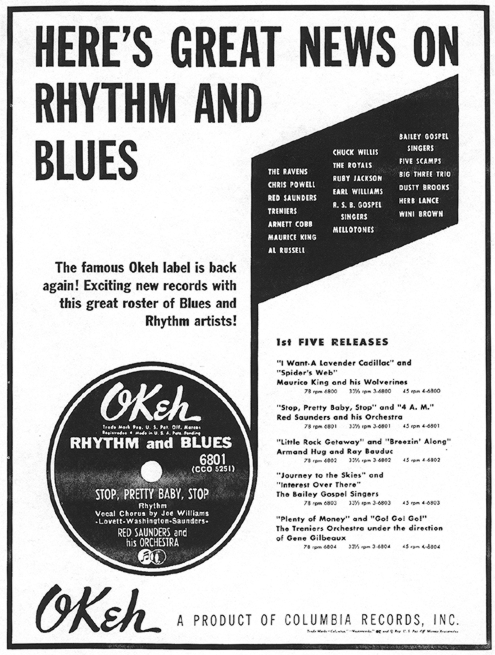
After her sojourn at King in 1952, LaVern Baker finally hit the big time in 1953, when Atlantic signed her. From 1955 ("Tweedle Dee") through 1963 ("See See Rider") she reeled off chart hits for the company.
In 1969, LaVern Baker took a job at Subic Bay Naval Base in the Philippines, as entertainment director for the Marine Corps Staff NCO club. She remained there till 1988, when by agreement with the Philippine government the base was closed. Returning to the American scene, she recorded and performed regularly from 1988 through the mid-1990s, including a Broadway turn in which she replaced Ruth Brown in the musical Black and Blue. She was inducted into the Rock and Roll Hall of Fame. Suffering severely from diabetes, LaVern Baker died in Queens, New York City on March 10, 1997.
Red's first session for OKeh was quite productive, turning out three effective vocal numbers for Joe Williams, and a remake of Mac Easton's instrumental feature, "4 A. M. Blues."
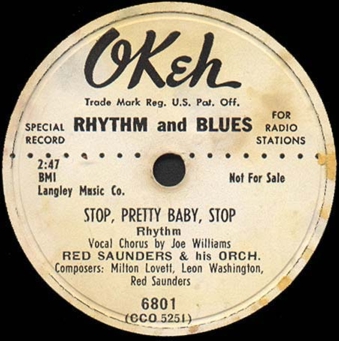
Red Saunders (d, ldr); Fip Ricard (tp); Sonny Cohn (tp); Harlan "Booby" Floyd (tb); John Avant (tb); Porter Kilbert (as); Leon Washington (ts); McKinley Easton (bars); Earl Washington (p); Jimmy Richardson (b); Jumpin' Joe Williams (voc); Sonny Blount (arr -1).
Columbia Studios, Chicago, April 20, 1951
| CCO 5251 | Stop Pretty Baby Stop (Lovett-L. Washington-Saunders) [JW, ens voc] -1 | OKeh 6801 | |
| CCO 5252 | Mistreatin' Woman Blues (Saunders-Washington) ^ [JW voc] -1 | OKeh 7061, Moonshine LP 114 | |
| CCO 5253 | Week Day Blues [JW voc] (J. Woods-Saunders) -1 | OKeh 6834, Moonshine LP 114, Epic E3K 48912 [CD] | |
| CCO 5254 | 4 A.M. (L. Washington-M. Easton-Saunders) -1 | OKeh 6801 |
OKeh 6801 was a single, released on 45, 78, and 33(!) rpm. (An advert in Cash Box, July 21, 1951, which kicked off the revived OKeh label, indicates that OKeh 6800-6804 were all released on 33 1/3 rpm singles. This experiment was presumably terminated in a hurry...) OKeh 6801 was originally scheduled for release on June 4, 1951 and was reviewed in Billboard on July 14, 1951 (p. 65; it was one of the 5 leadoff singles for the newly revived imprint). "Stop" was the A side, "4 A. M." the B side. (The title on the label was just "4 A.M.," not "4 A.M. Blues" as previous discographies had it.) OKeh 6834 was a single, released on 45 and 78 rpm, in November 1951 (it was listed in Billboard on November 3, 1951, p. 43). OKeh 7061 was a 45 rpm single, reviewed in Billboard on September 10, 1955 (p. 48); "Mistreatin' Woman" was the B side.
Moonshine 114 was a Dutch various artists LP titled Leapin' on Lenox. Epic E3K 48912 was a collection of 3 CDs released in 1993 and entitled The OKeh Rhythm & Blues Story 1949-1957. Session information from Leadbitter, Fancourt, and Pelletier, 1994 edition, and the Epic booklet.
According to Chris Trent, the chord voicings and treatment of rhythm on "Week Day Blues" indicate Sonny Blount's involvement. "Stop Pretty Baby Stop" and "4 A. M. Blues" have comparable touches, as does "Mistreatin' Woman Blues." "Mistreatin'" has no horn solos but it does include some drum breaks for Red.
The company was apparently pleased with the yield from Red's first session. OKeh brought him back in August to cut a total of 8 sides over a two-day period. Only one of these ("Boot 'em Up") was an instrumental; three featured "Jumpin' Joe" Williams, two featured June Davis, and two more were meant to showcase Ray Orlando.
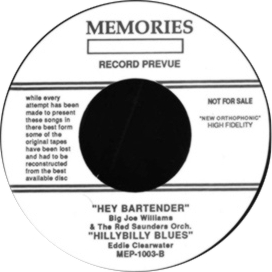
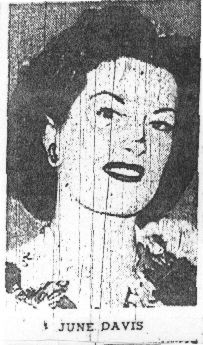
Red Saunders (d, ldr); Sonny Cohn (tp); Harlan "Booby" Floyd (tb); John Avant (tb); Porter Kilbert (as); Leon Washington (ts); McKinley Easton (bars); Earl Washington (p); Jimmy Richardson (b); Jumpin' Joe Williams (voc ^); June Davis (voc *); Sonny Blount (arr).
Columbia Studio, Chicago, August 24, 1951
| CCO 5278 | Last Night's Party^ (Toombs-Sweet) [JW voc] | OKeh 6914 | |
| CCO 5279 | Hey Bartender^ [JW voc] (R. Hall-Saunders) | OKeh 7061, Moonshine LP 114, Memories Record Prevue MEP-1003, Epic E3K 48912 [CD], Columbia CK40799 [CD] | |
| CCO 5280 | Boot 'em Up (Saunders-L. Washington) | OKeh 6862, Columbia [Can] C-1926 | |
| CCO 5281 | Sugar Bounce (Toombs-Sweet) [JW, ens voc] | OKeh 6834, Moonshine LP 114 | |
| CCO 5282 | Gentle Lover* (Jay-Mann) [JD voc] | OKeh 6856 | |
| CCO 5283 | J.D. Blues* (June Davis) [JD voc] | OKeh 6856 |
Sides from this session were used on five OKeh singles. OKeh 6834 was released on 78 and 45 rpm, in November 1951 (it was listed in Billboard on November 3, 1951, p. 43).
OKeh 6856 was a single released around April 5, 1952, on both 78 and 45 rpm. "Gentle Lover" was the A side. The single was announced in Billboard on March 29, 1952 (p. 36). It was reviewed in Cash Box on April 5.
OKeh 6862 was a single released in February 1952 on both 78 and 45 rpm; "Boot 'em Up" was the B side. (On the strength of "Hambone," the A-side that was Red's only hit record, there was also a Canadian release.) Billboard for March 8, 1952 gave "Boot 'Em Up" ratings in the low 70s: "A strong, riff-built instrumental rocker with an old flavored jump beat is done up slickly by the ork with lots of drive." That was a fair description of the number, which was clearly inspired by late 1930s Count Basie. On March 8, 1952, OKeh 6862 was also reviewed in Cash Box, whose writer expected "Hambone" to "break fast."
OKeh 6914 was a single released on 45 and 78 rpm, in October 1952. It was not reviewed in Billboard, but Cash Box, gave it a "Jazz 'n Blues Sleeper of the Week," on October 18, 1952. Red worked hard to promote the single, in part because Joe Williams' Checker 762, "Every Day I Have the Blues" had been released the previous month. Williams now had a signature tune, and his Checker was hitting. According to Cash Box (November 8, 1952, p. 21), Red sent out a mailing to more than 400 deejays, talking up "Last Night's Party." Meanwhile Joe Williams was working at the Paris Club on West Madison.
OKeh 7061 was a 45 rpm single (we aren't sure whether it had a counterpart on 78) reviewed in Billboard on September 10, 1955 (p. 48).

Although the booklet to the Epic box set claims to include an alternate take of "Hey Bartender," all releases have used the same take. The Epic reissues give the title as "Hey Bartender Buy That Man a Drink" but the short form is what appeared on the original OKeh release.
Surely the weirdest reissue of the title was on the B side of a red vinyl EP, Memories Record Prevue MEP-1003. It was incorrectly credited there to "Big Joe Williams & The Red Saunders Orch."; its sidemate was "Hillybilly Blues" by Eddie Clearwater. The A side contained the Mercury and Watch versions of "Bald Head" by Roy Byrd (better known as Professor Longhair).
Epic E3K 48912 was a collection of 3 CDs released in 1993 and titled The OKeh Rhythm & Blues Story 1949-1957. According to the Epic booklet, the version of "Hey Bartender" released on CD is an alternate take. Columbia CK40799 is a various-artists CD released in 1996 under the title Columbia Jazz Masterpieces—The 1950s: The Singers; other performers include Hot Lips Page, Dolores Hawkins, Babs Gonzalez, and Louis Armstrong (information from the online All-Music Guide).
Other sources of information on this session: Leadbitter et al., 1994 edition, a doowop "repro" catalog provided by Anthony Barnett, and the Epic booklet.
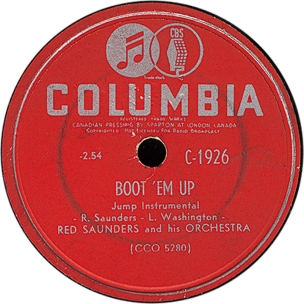
Leadbitter left out the last two items from this session, both of which featured June Davis. Jepsen did include her sides, and our session information about them is from that source. To our knowledge, June Davis never worked the Club DeLisa. Our first evidence of her comes from 1940, when she worked with a rehearsal band led by pianist Frank Melrose. Three privately recorded sides survive with her vocals on them; they were not commercially relased until 2006. Of these, "Bluesiana" and "Have You Ever Felt That Way" are obvious imitations of Billie Holiday. "If You'se a Viper," a duet with Melrose, is in a lighter, more pop-oriented style much closer to her recorded work with Red Saunders. June Davis was singing at El Grotto (64th and Cottage Grove) in December 1946. She did not record again until this Red Saunders session.
"Last Night's Party" is early rock and roll with minimal writing, but according to Chris Trent "the bottom-heavy sound of the band" suggests it may be Sonny Blount's work; rlc concurs. The piece shows distinct and early New Orleanian influence and somewhat resembles Sun Ra's 1958 composition "Great Balls of Fire." "Hey Bartender" incorporates a favorite Ra riff drawn from "Saint Louis Blues" and the rhythm bears Ra fingerprints as well. "Boot 'em Up" is a fluent but obvious imitation of the Basie band, circa 1938; but note the blatting trombone pedal under the ensemble, just before the false ending. Sonny could have lifted this feature from the Red Allen jump band of the 1940s with Don Stovall, whom he is known to have admired. "Sugar Bounce" mixes in some bop licks, and commits outright thievery from "Jumpin' with Symphony Sid"; note the sax ensemble as the piece fades. Sonny's involvement in "Gentle Lover" seems clear; "J. D. Blues" is an informal blues, and there his contributions, if any, would be harder to trace.
Red Saunders (d, ldr); Sonny Cohn (tp); Harlan "Booby" Floyd (tb); John Avant (tb); Porter Kilbert (as); Leon Washington (ts); McKinley Easton (bars); Earl Washington (p); Jimmy Richardson (b); Ray Orlando (voc).
Columbia Studio, Chicago, August 25, 1951
| CCO 5284 | It's Just What You Think | OKeh (unissued) | |
| CCO 5285 | Lonely | — |
All information from Leadbitter, Fancourt, and Pelletier, Blues Records 1943-1970, Vol. 2, 1994 edition. These unissued sides are unavailable for checking, so nothing more can be said about Sonny Blount's possible participation. Robert Pruter, in Doowop: The Chicago Scene, describes Orlando as a ballad singer. Orlando never sang at the Club DeLisa either. He presumably recorded with Red Saunders at the urging of OKeh's management.

Kitty O'Day (voc); Grant Jones (voc); acc. by Red Saunders (d, ldr); Porter Kilbert (as); Leon Washington (ts); McKinley Easton (as -1; bars -2, 3, 4); Lonnie Simmons (p -4; Hammond org); Ike Perkins (eg); Jimmy Richardson (b); unidentified females (voc -3).
Universal Recording, Chicago, December 1, 1951
| 1039 | Young Man's Fool [KO'D voc] | unissued | |
| 1040 | I Want to Ride or Fall [KO'D voc] | — | |
| 1041 | Heartache Blues [GJ voc] -4 | States 114, RST 1580 [CD] | |
| 1042-1 | Strange Man (Jones) [GJ voc] -1 | United 112, P-Vine Special [J] PLP 9045, RST 1580 [CD] | |
| 1043-3 | Let's Get High (Jones) [GJ, ens voc] -2 | United 112, P-Vine Special [J] PLP 9045, RST 1580 [CD] | |
| 1044-3 | Hi Yo Silver [GJ, females voc] -3 | P-Vine Special [J] PLP 9045, RST 1580 [CD] |
Thanks to Gilbert Hsiao for providing a copy of P-Vine Special PLP 9045, a Japanese LP issued in 1982 under the title Black Music in the 50's, Volume 13: Standup and Sing the Blues. All four Grant Jones titles were reissued in 1994 on RST 1580, an Austrian CD titled Grant "Mr. Blues" Jones: In the Dark (1949-58). Thanks to Daniel Gugolz for making a copy available.
The basic session information comes from the back liners of the P-Vine LP (this Grant Jones session was not listed in Lord) and from Jepsen. Jepsen gives no personnel and dates the session to 1952; Robert Koester, in his article "The United/States Masters," Blues Unlimited, January / February 1977, gives the correct date but no personnel, though he does mention that Ike Perkins' name was in the log or on the tapes for 1043 and 1044. P-Vine Special lists only Saunders and Perkins; RST hazards the guess that Tab Smith was on the alto sax.
The misidentification of Porter Kilbert is understandable, but Porter (besides being one of Red's regulars) had a somewhat less incisive attack than Tab Smith during this period. The rest of the band was identified by ear. Kilbert solos on "Strange Man," and Leon Washington solos on "Let's Get High" and "Hi Yo Silver."
United 112 was a single issued in March 1952. It was listed under "R&B Records to Watch" in Billboard, March 22, 1952 (p. 39; as has occasionally happened through the years with United and States releases, Billboard listed the record as "United 1043"). States 114 was issued in March 1953.
Lonnie Simmons maintained a residency at the Club DeLisa from 1950 to 1956 (he filed a contract for 12 weeks there with Local 208 on July 6, 1950; his departure was recorded in a photo in the Chicago Defender from April 1956), so he is the obvious candidate for organist. The organist is definitely not Sonny Blount (soon to become Sun Ra), and the elementary arranging for this date is not the sort that would have required his services. Lonnie also switches to piano for a while during "Heartache Blues."
Grant "Mr. Blues" Jones had past associations with Red and band. Jones was included on the bill for a New Year's Eve production at the Club DeLisa, along with "Vi" Kemp and Red Saunders & Band (Chicago Defender, December 31, 1949); he was previously part of the advertised show on October 9, 1948 and February 12, 1949.

Kitty O'Day (who was advertised in the Chicago Defender of the period as a blues singer) recorded earlier in the same session, according to Koester. Unless she brought her own band with her, she was accompanied by Red's outfit (and she may have stuck around to contribute to the backing vocals on "Hi Yo Silver"). Interestingly, Lord does list the Kitty O'Day numbers.
Koester says that versions of "Hi Yo Silver" (1037) and "Heartache Blues" (1038) were attempted in a session at Universal Recording on November 27, 1951. This was the tail-end of session with Tiny Grimes and Jimmy Forrest; it is not known whether Grant Jones was accompanied by Red's Band or by someone else. In any case, both tracks had to be remade on December 1.
Around the beginning of 1952, Porter Kilbert left the Saunders band and was replaced by Riley Hampton in the three-piece sax section. (Kilbert got himself launched with a 4-week gig at the Strand Show Lounge, which was accepted and filed by Local 208 on January 17, 1952; he moved on to Joe's High Hat, where his contract for 3 nights posted on March 20.).
Born in Little Rock, Arkansas around 1918, Riley C. Hampton, who played alto sax and clarinet, left town with a Detroit-based band and ended up in Pittsburgh, where he worked with the Jimmy Murray band (1940-1942). In March 1942, the Jimmy Murray band was taken over in its entirety by Fletcher Henderson; Hampton remained with Henderson till July 1943, when he was drafted into the Army. On completing his military service he returned to the Henderson band at the Club DeLisa, probably in the fall of 1946. He worked with Horace Henderson and other leaders in Chicago before taking his place in the Saunders band.
It was the new edition of the band with Riley Hampton that got to make Red's only hit record.
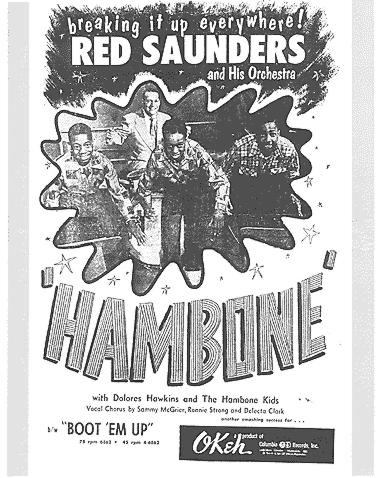

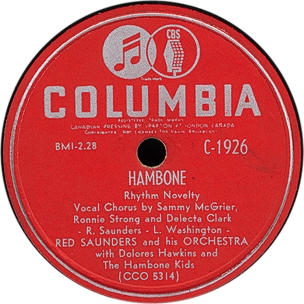
Red Saunders (d, ldr); Fip Ricard (tp); Sonny Cohn (tp); Harlan "Booby" Floyd (tb); John Avant (tb); Riley Hampton (as); Leon Washington (ts); McKinley Easton (bars); Earl Washington (p); unidentified (g -1) Jimmy Richardson (b); Dolores Hawkins (voc, whistling -1); The Hambone Kids: Delecta "Dee" Clark, Sammy McGrier, Ronny Strong (voc, hamboning -1); Sonny Blount (arr -1).
Columbia Studio, Chicago, January 18, 1952
| CCO 5314 | Hambone* (Saunders-L. Washington-H. McGrier) -1 | OKeh 6862, Columbia [Can] C-1926 | |
| CCO 5314 [alt.], JZSP 59257 | Hambone* (Saunders-Washington-McGrier) -1 | OKeh 7166, OKeh 7282, Epic LP 22125, Epic EG 37649, Edsel ED 149, Edsel ED CD 149, Century CD # | |
| CCO 5315-2B | La Raspa (trad.) | OKeh 6884 |
OKeh 6862 was a single issued on 45 rpm and 78 rpm in February 1952 (large display ads in Billboard and Cash Box showed the Kids performing in front of Red and his drums; Billboard's release listing didn't catch up till March 1, 1952, p. 31, but the trade paper also flogged it as a "Billboard Pick" on p. 38). "Hambone" was the A side. The originally issued take of "Hambone" included Dolores Hawkins' whistling but lacked her vocal interjections; it also included a brief passage for the full band and a tenor sax solo. The Kids' rhythmic practice is "hamboning" or "patting juba": slapping various body parts as a substitute for drumming. Dee Clark, as Sammy McGrier pointed out in Pruter's book, also stamped with his heel on the 2nd and 4th beats. Horace McGrier Sr. wrote two verses for the song, though he is not credited on the label (shame, shame).
OKeh definitely figured that it had something—not only was "Hambone" given a much bigger publicity push than Red's other releases, it jumped the queue and came out ahead of the previously scheduled OKeh 6856 featuring June Davis. The March 8, 1952 issue of Billboard smelled sales. "Hambone" was given marks of 88 to 90 by the four reviewers: "This, the original 'Hambone' etching, is a powerful wax item. Tremendous spirit and drive based on the chanting and hand-clapping of a bunch of kids should make this a strong contender in the pop market." Note the reference to Red's being the "original" recording; in the early 1950s, any number with sales potential in the pop market was promptly covered by other artists. So, as we learn from the very same issue of Billboard, the OKeh release was almost immediately followed by a version on Columbia (hmm, same company...) by Jo Stafford and Frankie Laine, and a version on RCA Victor by Phil Harris and the Bell Sisters. "Deejays will have a field day with these records." The reviewers weren't totally dazzled by the prospective dollar signs; they credited the original performance with having "the most drive and spirit."
"Hambone" was went to #20 on the R&B charts for one week, and according to an October 1952 article in Billboard, "OKeh Records hit the 80,000 figure with the Red Saunders waxing." Red's comment to Art Hodes was succinct: "It got us this house—the down payment." The single sold well enough to justify a Canadian release (we're pretty sure this was the only one that Saunders would ever get); on the Canadian 78 the matrix number for "Hambone" carries suffix -2A.
What purported to be a straight reissue of "Hambone" appeared as the A side of OKeh 7166 (in 1963) and again on OKeh 7282 (in 1967); both were 45-rpm singles. The occasion for the reissue is made clear on the label to 7166: "As Featured by Sandy Becker on His TV show 'Sandy's Hour'." The JZSP number is the contemporary Columbia master number that appears on the label of 7166. In fact the reissues used an alternate take of "Hambone," running 2:13, in which the Hambone Kids and Dolores Hawkins are accompanied throughout by guitar, bass, and drums only; the rest of the band contributes nothing, except shouts of "Hambone!" at the beginning and end of the piece. Thanks to Dan Ferone for providing label scans of OKeh 7166. Thanks to John McCarthy for pointing out that the reissue of "Hambone" was on OKeh 7282as well as OKeh 7166 as reported in Leadbitter, Fancourt, and Pelletier's blues discography, and for providing a dub of OKeh 7282.
The flip side of both reissue singles was "Rumble Mambo" by Link Wray and the Wraymen, obviously not a Red Saunders number (as erroneously stated in Leadbitter). Our thanks to the online Link Wray discography (http://pages.prodigy.com/cyclops/linkwray.html) for the release dates (Robert Pruter mentions the 1963 reissue of "Hambone" in Doowop: The Chicago Scene).
The coupling of "Hambone" and "Rumble Mambo" (it would be interesting to know the record-company logic behind this...) has caused confusion in the Link Wray camp as well. Jeff Hall points out that a collection of what were supposed to be 16 of Link Wray's late-1950s recordings was issued on in England on Edsel ED 149 [LP] and ED CD 149 in 1989. The collection was titled Link Wray & The Raymen. It included the alternate take of "Hambone" as a Link Wray performance! A subsequent CD collection of Wray material from this period on the Sony label avoided this blunder.
The alternate take was probably used on Epic LP 22125 (a 2-LP set of OKeh Rhythm and Blues released in 1982) and definitely on Epic EG 37649, Okeh Rhythm & Blues (apparently a reissue of this 2-LP set). On a recent bootleg doo-wop "repro" single, "Hambone" appears as the A side (the B side is "Zeke'l Zeke'l" from the next session); the "repro" is billed as derived from OKeh 6862. A 1990s compilation CD, Pop Fifties Vol. 7, includes "Hambone" (in the company of "Cry" by Johnny Ray, "The Twelfth of Never" by Johnny Mathis, and other distinctly non-R&B material); it was issued by Century Records in Canada for use by radio stations. That version of "Hambone" is said to have been taken from OKeh 6862; we have not been able to check the CD.
OKeh 6884 was a single issued on 45 and 78 rpm in May 1952; it was advertised in Billboard on June 7, 1952 (p. 35), and listed on June 14, 1952 (p. 108). "La Raspa" was the B side. Chris Trent is sure that Sonny Blount did not arrange "La Raspa," which he describes as "a medley of European and Latin American tunes for which [Sonny] could never have been responsible." Clearly true. "La Raspa" is clumsy march music without swing or convincing Latin rhythm, and the sectional writing is incompetent. "Hambone," on the other hand, is the historical intermediary between the "band vocals" of the Swing era and such numbers as "It's Christmas Time," which Sunny recorded with a group called the Qualities—as well as Sunny's ubiquitous space chants.
Browley Guy (voc); two other Guy brothers (voc -1); Red Saunders (d, dir); Fortunatus "Fip" Ricard (tp); Harlan "Booby" Floyd (tb); Riley Hampton (as); Leon Washington (ts); McKinley Easton (bars); Earl Washingon (p); Jimmy Richardson (b).
Universal Recording, Chicago, between February 18 and 25, 1952
| 1068 | Wrong Wrong | States (unissued) | |
| 1069 | Marie (Berlin)* | States 101 | |
| 1070 | Cool Cool Road | States (unissued) | |
| 1071 | I Like Barbecue (Guy) -1 | States 101 |
Leonard Allen and Lew Simpkins launched the States label in June 1952 with this obscure single by baritone crooner Browley Guy, who got some vocal help from two of his brothers. States 101 has never been reissued, and the other two sides have never seen the light of day. The unnamed orchestra turns out to be a Red Saunders unit; Red's drumming is well recorded and unmistakable. Leon Washington gets a tenor sax solo on the jump number "I Like Barbecue." Fip Ricard and Booby Floyd solo with their mutes in on "Marie," which Browley Guy had previously recorded for Miracle in an unreleased 1949 session. This version swings a lot harder.
Browley Guy recorded once more for States, in August 1952. This time he brought his entire vocal group, the Skyscrapers, and accompaniment was provided by Paul Bascomb's band. Guy and the Skyscrapers would make their final recording sesson for Al Benson in June 1953; one single was released on Checker.
Red Saunders (d, ldr); Fip Ricard (tp); Sonny Cohn (tp); Harlan "Booby" Floyd (tb); John Avant (tb); Riley Hampton (as); Leon Washington (ts); McKinley Easton (bars); Earl Washington (p); Jimmy Richardson (b); June Davis (voc); Barbara Reeves (voc).
Columbia Studio, Chicago, March 24, 1952
| CCO 5326 | Chicken Today and Feathers Tomorrow [JD voc] | OKeh (unissued) | |
| CCO 5327 | I Played the Fool [JD voc] | — | |
| CCO 5328 | A Long Dark Hallway (with a Low Ceiling) [BR voc] | — | |
| CCO 5329 | Don't Go [BR voc] | — |
All information from Leadbitter, Fancourt, and Pelletier, Blues Records 1943-1970, Vol. 2, 1994 edition. These tracks are not available for checking, so nothing can be said about arrangers at this time.
June Davis had previously recorded with Red on the session of August 24, 1951. These two unrelased sides were her last for OKeh. When her contract expired, she signed with Atlas ("Rhythm and Blues Notes," Billboard, February 21, 1953, p. 53). About Barbara Reeves (who from the titles we infer was a ballad or torch singer) we have no further information.
In another 10 days, however, more material was ready for the Hambone Kids, so OKeh rushed them back into the studio.
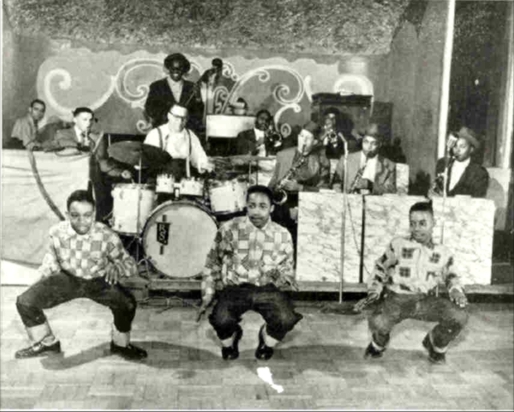

Red Saunders (d, ldr); Fip Ricard (tp); Sonny Cohn (tp); Harlan "Booby" Floyd (tb); John Avant (tb); Riley Hampton (as); Leon Washington (ts); McKinley Easton (bars); Earl Washington (p); unidentified (eg -2); Jimmy Richardson (b); The Hambone Kids: Delecta "Dee" Clark, Sammy McGrier, Ronny Strong (voc, hamboning -1); prob. Sonny Blount (arr -1).
Columbia Studio, Chicago, April 3, 1952
| CCO 5330-1B | Zeke'l Zeke'l (Saunders-Dahl) [HK voc] -1, 2 | OKeh 6884 | |
| CCO 5331 | Piece A-Puddin' (Toombs) ^ [HK voc] -1 | OKeh 6914 | |
| CCO 5332 | Portrait of Vintage P. McWorm | OKeh (unissued) |
OKeh 6884 was a single, issued on 45 and 78 rpm in May 1952; it was advertised in Billboard on June 7, 1952 (p. 35), and listed on June 14, 1952 (p. 108). "Zeke'l Zeke'l" was the A side. "Zeke'l Zeke'l" was reissued on the B side of a bootleg "repro" single with "Hambone" as the A side. Credited to Saunders and Dahl, "Zeke'l" was published by Premium Music, Lee Egalnick's toehold on the music business after the Premium record label went broke in the early fall of 1951.
OKeh 6914 was a single released in October 1952 on 78 and 45 rpm. OKeh 6914 was neither advertised nor reviewed in Billboard (maybe because of disappointing sales on "Zeke'l Zeke'l"), but BMI put in a plug for "Piece A-Puddin'" (which had been covered by other artists) on October 18, 1952 (p. 46). By contrast, Cash Box reviewed 6914 and gave it a "Jazz 'n Blues Sleeper of the Week." Track and personnel information are from Leadbitter et al., who give no vocal credits. An uncredited electric guitar is prominent on "Zeke'l Zeke'l." The hamboning on "Piece-A-Puddin'" occurs only at the beginning.
"Piece A-Puddin'" was probably arranged by Sonny Blount, according to Chris Trent. The writing resembles Ra's arrangement for "The Sun Man Speaks," a number that he would record with the eccentric blues singer Yochanan in 1961. rlc concurs, citing the "heavy bottom" to the arrangement. Sonny's involvement in "Zeke'l Zeke'l" is also likely. The unissued track has obviously not been checked.
"Portrait of Vintage P. McWorm" is an intriguing title, but we can say no more. It has reposed in the vaults for 65 years.
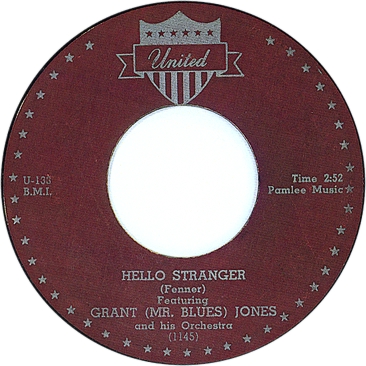
Grant Jones (voc) with Red Saunders (d, ldr); Sonny Cohn (tp -1); Riley Hampton (as); Leon Washington (ts -1); McKinley Easton (bars -1); Earl Washington (p); Jimmy Richardson (b).
Universal Recording, Chicago, October 7, 1952
| 1145 | Hello Stranger (Fenner) -1 | United 133, RST 1580 [CD] | |
| 1146 | Thunder (Fenner) | unissued | |
| 1147-2 | In the Dark (Broonzy) | United 133, RST 1580 [CD], Delmark DD-775 | |
| 1148-2 | Stormy Monday (Walker) | States 114, RST 1580 [CD] |
United 133 and States 114 were 78 and 45 rpm singles; United 133 came out in December 1952, and States 114 followed in March 1953. The previously issued titles were reissued in 1994 on RST 1580, an Austrian CD titled Grant "Mr. Blues" Jones: In the Dark (1949-58). Delmark DD-775 is a CD compilation from 2004 titled The United Records Story.
Jepsen's Jazz Records appends three of these items (minus "Thunder") to the 1951 Grant Jones session. However, Leadbitter and Slaven's Blues Records 1943 to 1970 A to K (1987 edition), following Koester's discography of the United States labels, gives the recording date and includes the unissued item.
RST attributes these sides to a Red Saunders band, which does seem to be the case. On "Hello Stranger," a trumpet and three saxes are present, though they are recessed and only the trumpet gets a brief statement. We of course have not heard "Thunder," but we suspect the more arranged approach might have extended to it as well.
"In the Dark" and "Stormy Monday" were both standards by this time, and could have been decided on at the session. Jones sticks so close to Lil Green's Victor original that he imitates her pronunciation: "It's faun to be kissed." The accompaniment on these is just the alto saxophonist and rhythm. The dark tone is characteristic of Riley Hampton when he got one of his few solo opportunities; compare his appearance on Albert Ammons' last session, which was done for Mercury, probably in January 1949. All musicians on this session were identified by ear; Earl Washington's piano is an obvious presence (he gets the only solo on "Hello Stranger").
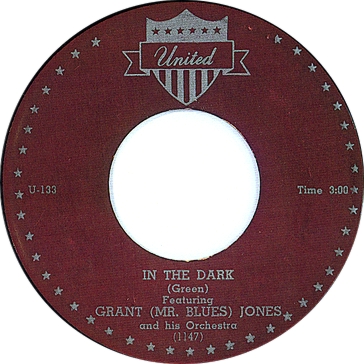
The Chicago Defender of February 23, 1952 identified "Thunder" and "Hello Stranger" as an upcoming debut release by Senabelle Richie Fenner, who was identified as a "writer, poet, and song-stylist, whose compositions have been recorded by numerous artists." (She did get around a little; we know of three 1947 compositions by her.) The Defender for August 23, 1952 referred to "Thunder" as a "Red Saunders recording." We don't know what happened to the versions of "Thunder" and "Hello Stranger" with Fenner's vocals—which label they were recorded for, even whether the recordings ever materialized. But obviously at some point United took an interest in the tunes.
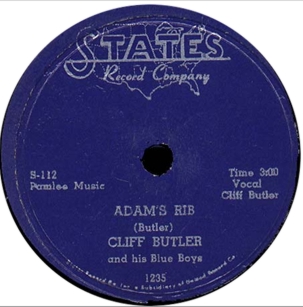
Cliff Butler (voc except -1); The Doves (male vocal quartet -2); prob. Red Saunders (d, ldr); Leon Washington (ts); Benny Holton (p); unidentified (eg except -1); prob. Jimmy Richardson (b except -1).
Universal Recording, Chicago, November 17, 1952
| 1233 | (You're My Honey but the) Bees Don't Know It -2 | States 148 | |
| 1234 | Got Me on My Mind, Love Me [?] | unissued | |
| 1235-2 | Adam's Rib | States 112, Pearl PL-17, Delmark DE-717 [CD] | |
| 1236 | Benny's Blues -1 | States 112 | |
| 1237 | Boogie | unissued | |
| 1238 | Butler's Rock | — |
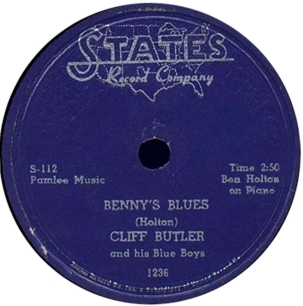
Session information from Koester's discography. States 112 and 148 were 78 and 45 rpm singles. States 112 was released in January 1953, and 148 around May 1955. Pearl PL-17 was a 1989 LP release of United/States material by Cliff Butler, Edward "Gates" White, and Dennis "Long Man" Binder titled Long Man Blues. Delmark DE-717, also known as Long Man Blues, adds material by other artists to the original lineup of the Pearl LP; it was released in 2000.
The notes to the Pearl album suggest that Red Saunders and other members of the Club DeLisa band accompanied the earlier sessions included therein, and listening backs this judgment. Benny Holton, a blind pianist who worked with Butler, is mentioned in the notes to the Pearl LP and cited in the title "Benny's Blues." The notes mention two tenor saxophonists, but only one can be heard on "Adam's Rib"; judging from his Hawkish solo, he is Leon Washington. "Benny's Blues" (which can be heard on the Web at http://forsaken.warehouse.net/nugrape/benny.ram) is a feature for Benny Holton, accompanied by Red Saunders. Leon Washington has a subdued solo; the rest of the band lays out. A vocal group from Louisville, The Doves, appeared on "Bees Don't Know." The unissued numbers have not been checked.
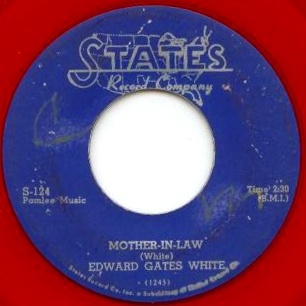
Edward "Gates" White (voc); prob. Fortunatus Paul "Fip" Ricard (tp); prob. Eddie Williams (ts); Tom Archia (ts); prob. Louis Carpenter (p); Ike Perkins (eg); Jimmy Richardson (b); Theodore "Red" Saunders (d).
Universal Recording, Chicago, November 26, 1952
| 1243-5 | Tired of Being Mistreated | Pearl PL-17, Delmark DE-717 [CD] | |
| 1244-7 | Love Is a Mistake* | Pearl PL-17, Delmark DE-717 [CD] | |
| 1245-4 | Mother-in-Law (White) | States 124, Pearl PL-17, Delmark DE-717 [CD] | |
| 1246-9 | Rockabye Baby (White)* | States 124, Pearl PL-17, Delmark DE-717 [CD] |
States 124 was a 78 and 45 rpm single released in July 1953.
The session information comes from Bob Koester's discography of the United/States labels. The liners to Pearl PL-17, Long Man Blues, an LP collection issued in 1989, indicate Red Saunders as a "possible" on this session. (The Pearl LP is also the source for the take numbers.) Delmark DE-717, also titled Long Man Blues, is a compilation from 2000 that subsumes all of the cuts from the Pearl LP and adds numbers by Eddie Boyd, L. C. McKinley, Ernest Cotton, Jack Cooley, and Harold Burrage.
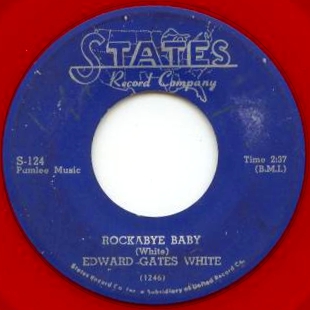
Listening upgrades Red to a "definite," and Jimmy Richardson seems to have come along with him. Pearl's identification of Ike Perkins as the guitarist seems correct. But this is not a typical Saunders ensemble. The pianist is not Earl Washington; whoever it is sounds like a less forceful Willie Jones. His disciple Louis Carpenter (who recorded with Red Holloway behind doo-wop groups for Chance in 1953; see the Appendix to our Al Smith listing) seems likely. The tenor player who solos on "Love Is a Mistake" and solos second on "Rockabye Baby" is obviously Tom Archia (captured in splendid fidelity, too). The obbligato on "Tired of Being Mistreated" and the first solo on "Rockabye" appear to be the work of Eddie Williams (who can also be heard on the Horace Henderson recordings from July 1954, recently issued on IAJRC). No trumpet is credited by Pearl (or by the Delmark CD, which replicates the Pearl credits), but there is one in the ensemble, and he steps out for a few notes during the tag to "Rockabye." If it's a member of Red's band, Fip Ricard is the obvious choice.
On January 13, 1953, Red Saunders received a 15th anniversary salute from the Club DeLisa. It got some advance publicity: Cash Box declared (December 27, 1952) that a "comittee of one hundred" was planning the event. Red's tenure at one venue was said to be rivaled only by Guy Lombardo's. 1000 people attended, Duke Ellington (whose band worked the Regal Theater from January 9 through 15) was the honorary chairman, and Mike DeLisa came through with a check for $1000. (See also in Billboard, February 1953.)
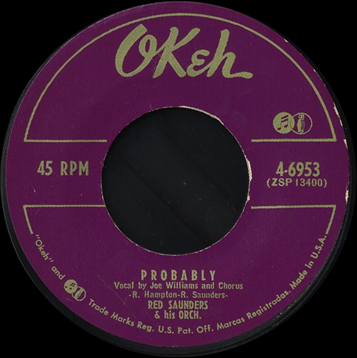
Red Saunders (d, ldr); Fip Ricard (tp); Sonny Cohn (tp); Harlan "Booby" Floyd (tb); John Avant (tb); Riley Hampton (as; cl -1); Leon Washington (ts; cl -1); McKinley Easton (bars, as; cl -1); Earl Washington (p); Jimmy Richardson (b); Joe Williams (voc); unidentified vocal group (backing voc); Sun Ra (arr).
Columbia Studio, Chicago, January 21, 1953
| CCO 5400, ZSP 13401 | Mambo in Trumpet (Salamanca) [ens grunts] | OKeh 6953 | |
| CCO 5401 | Honky Tonk Train Blues (Meade Lux Lewis) -1 | Columbia/Legacy CK64988 [CD] | |
| CCO 5402, ZSP 13400 | Probably (Hampton-Saunders) [JW, ? voc] | OKeh 6953 | |
| CCO 5403 | Voodoo Blues (Saunders-P. Williams) [JW, ? voc] | Epic E3K 48912 [CD] |
OKeh 6953 was a single released in April 1953, in both 78 and 45 rpm versions. The single was reviewed in Billboard on April 11, 1953, p. 41; "Probably" was identified as a pop tune. By this time, Columbia had started its ZSP series for items that the company mastered and pressed; both sides of 6953 carry ZSP numbers in place of the CCO numbers. Epic E3K 48912 was a collection of 3 CDs released in 1993 and titled The OKeh Rhythm & Blues Story 1949-1957. Columbia/Legacy CK-64988 is a CD titled Juke Joint Jump: A Boogie Woogie Celebration; it was released in October 1996. Our basic information about these tracks draws from Leadbitter, Fancourt, and Pelletier, Blues Records 1943-1970 L-Z, Vol. 2, 1994 edition. Leadbitter et al. miss the vocal group (apparently 4 singers) on "Voodoo Blues" (they do get cited for "Probably," where the original label merely refers to them as "Chorus").
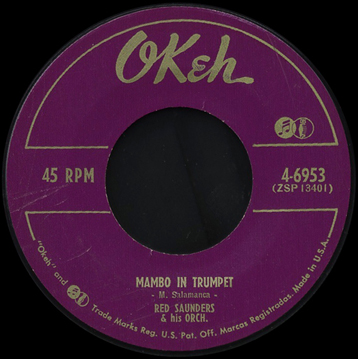
According to Chris Trent, "Mambo in Trumpet" and "Probably" are "definitely Sun Ra arrangements." "Mambo in Trumpet" uses the heavy Latin rhythm that Sunny was fond of in the late 1950s. "Probably" has a post-Ellingtonian sax ensemble with a heavy bottom; since Riley Hampton, who would became a prolific recording session arranger after he left Saunders, co-composed the number, we suspect that Ra retouched what Hampton had written. Trent says that "Voodoo Blues" is a musical "Rosetta stone" that combines R&B with Ra's "heavy rhythm exotica." There are particularly noticeable Ra touches in the instrumental interlude for piano and percussion and the tenor sax solo with baritone obbligato. "Honky Tonk Train Blues" is a feature for Earl Washington's piano; the horns are restricted to an accompaniment role, full of train-whistle emulations. The handling of the saxes is characteristically deft, however, and the train whistling makes a good excuse for some dissonant writing. Indeed, Hampton, Washington, and Easton shift from a clarinet trio, through two clarinets and a tenor sax [a violation of orthodox jazz arranging rules], to their usual instruments.
Leadbitter et al. mistakenly listed "Rumble Mambo" as another title from this session(!). John McCarthy points out that it was actually a track by Link Wray and his Wraymen that was used as the B side for the 1963 and 1967 issues of an alternate take of "Hambone" (on OKeh 7166 and 7282, both 45-rpm singles). See Jeff Hall's Link Wray discography at http://pages.prodigy.com/cyclops/linkwray.html).
At the end of February, Red and his band took a very rare road trip. A poster advertising upcoming acts at the Apollo Theater in New York City has Red Saunders and Band down for February 27 through March 5, 1953. Also on the bill: Wynonie Harris, Larry Darnell, and the Harlem Nocturne Dancers. See a description of the poster at http://www.posterpad.com/black.html.
Shortly after the January 1953 session, Columbia decided to close down its entire recording operation in Chicago. Among the artists cut from the OKeh roster were Red Saunders and Ahmad Jamal.
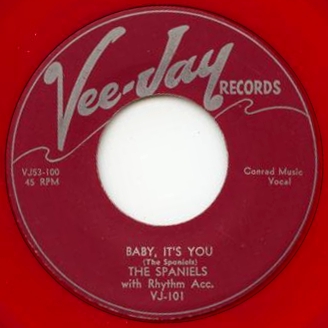
The Spaniels: James "Pookie" Hudson (lead tenor); Ernest Warren (1st tenor); Willie C. Jackson (2nd tenor, baritone); Opal Courtney, Jr. (baritone); Gerald Gregory (bass); accompanied by Earl Washington (p); Ike Perkins (eg); prob. Jimmy Richardson (b); Red Saunders (d).
Universal Recording, May 4, 1953
| VJ53-100 | Baby It's You (Spaniels) | Vee-Jay 101, Chance 1141, Vee-Jay LP 1002, Charly CD 222, Collectables CD 7204, Collectables CD 7243 | |
| 53-101 | Sloppy Drunk | unissued | |
| 53-102 | Since I Fell for You | Vee-Jay 202, Collectables CD 7243 | |
| VJ53-103 | Bounce (Spaniels) | Vee-Jay 101, Chance 1141, Vee-Jay LP 1002, Charly CD 222, Collectables CD 7243 |
Our basic information about this session comes from Robert D. Ferlingere, A Discography of Rhythm & Blues and Rock 'n Roll Vocal Groups 1945 to 1965 (2nd ed., 1992). Vee-Jay 101 was a single released in May 1953. Because of distribution difficulties, the brand-new Vee-Jay operation dealt the single to Chance, which reissued it as Chance 1141 in July 1953 (Bill Daniels points out that the Chance release was metioned in Billboard in July). Ferlingere notes that both the Vee-Jay and the Chance singles were pressed on colored plastic, and that such copies are much rarer than those pressed on black vinyl. There are also West Coast "repros" of Chance 1141 on red or black plastic. Vee-Jay 202 was a single released in July 1956.
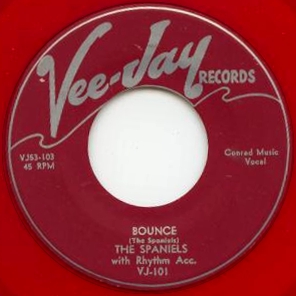
Vee-Jay LP 1002 was titled Goodnite, It's Time to Go. It initially appeared in 1959 with a maroon label, then in 1961 with a black label. Charly CD 222 is a 1990s collection of Spaniels material. Collectables CD 7204, Vee-Jay Rhythm & Blues: The Early Years Part One and Collectables CD 7243, The Very Best of the Spaniels Volume One, are 2000 releases.
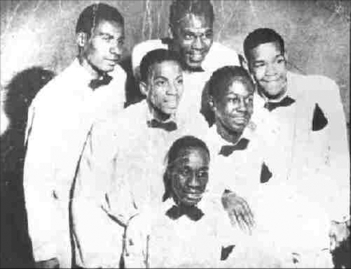
The Spaniels' line-up is from Ferlingere and Pruter's books. Pookie Hudson sang the lead on "Baby It's You" and "Since I Fell for You." Gerald Gregory was responsible for the lead on "Bounce." The instrumental personnel and recording date are from the liners to the Charly CD. However, the Charly notes fail to mention the guitarist; compare Ike Perkins' work on the Spaniels' July 1954. Charly does mention a tenor saxophonist, but none is heard on this session. This was the very first session recorded by Vee-Jay, then a Mom and Pop operation run out of a music store in Gary, Indiana.
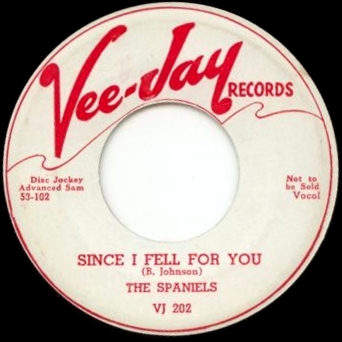
Existing sources do not list the accompaniment for the Spaniels' next session of September 23, 1953, which produced 53-110 "The Bells Ring Out," 53-111 "House Cleaning," and 53-112 "Goodnite Sweetheart, Goodnite." These three items are backed by tenor sax, piano, guitar, bass, and drums. Part of the problem here is that the same band most likely backed blues shouter Pro McClam on two sides, and (with an added violinist on one of them), could have done the same for blues-pop singer Wellington Blakey. But different personnel have been given for McClam (not the full band that accompanied him, either) and no one seems to have bothered for Blakey.
According to the Charly notes, the band on the Spaniels' third session, 53-124 through 53-126 (December 20, 1953) was led by tenor saxophonist Al Pitts. However, there is that one instrumental track by "Count" Morris that sure looks like something hastily called to fill out the session.
A session around July 24, 1954 that produced 54-172, 54-173, and 54-174 was accompanied by Morris Wilkerson (p); Ike Perkins (eg); George Green (b); and Frank Collins (d), according to the Mohr-Flückiger-Demeusy files; Charly incorrectly has Jerome Henderson on guitar, and no other personnel. The Spaniels split a session with the Dells on Feb. 19, 1955 (the Spaniels sang on 55-240, while 55-241 by the Dells appeared as the flip to the Count Morris number, and 55-242 by the same group was left in the can); the band was led by Red Holloway but was not an Al Smith unit. The accompaniment on the Spaniels' session from July 1955 (including 55-298) is unknown, but could be the Pitts band; it is not a Saunders unit. From January 1956 onwards the Spaniels recorded regularly with units led by Al Smith or Lefty Bates.
Although Red Saunders got in on the ground floor at Vee-Jay (the Count Morris track is known, and he almost certainly accompanied the Rhythm Aces on their second session), it was Al Smith and company who would become the house band.
At the time, the loss of the OKeh contract probably looked like a temporary setback. Red Saunders hooked up with Al Benson's new labels, Parrot and Blue Lake. Red's band accompanied Mabel Scott and the Chocolateers on the first session for Parrot (they made a covert appearance on Chess a little later). Later in the same year, Red made two further appearances on Parrot, playing brilliant Sun Ra arrangements behind blues singer Jo Jo Adams, and backing a doowop group called the Rockettes. The Saunders band also recorded twice for Benson's Blue Lake subsidiary, backing Joe Williams and doing instrumentals. And they made one last covert appearance on Chess, behind Valaida Snow. In 1954, Saunders groups backed singer Ann Carter on one session for Blue Lake and worked behind singers Lou Mac and Walter Spriggs on another. Toward the end of the company's history, in December 1955 Red returned for a session hosted by Al Benson and trumpter Louis Ogletree. And Red Saunders units accompanied St. Louis Jimmy and Lou Mac on the final two sessions for Parrot/Blue Lake, after John "Lawyer" Burton had purchased the outfit in 1956.
At some point in early 1953 Johnny Avant left the Red Saunders band. He was in demand as a session trombonist and presumably felt that he could get adequate work (and shorter hours) that way. His replacement was Cy Touff, who played valve trombone and bass trumpet (eventually becoming known for his work on the later instrument). Touff was a white musician (the first to become a regular in the Saunders band). He had already worked in the Regal Theater Orchestra in 1950 and 1951, and in the ensemble that Sax Mallard led on Al Benson's TV show (April through July 1950). He had also worked in the bands of Jimmy Dale and Jay Burkhart; the Burkhart aggregation, in which Touff participated in 1949, was a bebop big band that consisted mostly of white musicians but also included Gail Brockman and Hobart Dotson in the trumpet section and Joe Williams as its vocalist.
Touff does not recall making any recordings with the Saunders band. Most of the studio appearances that Red made during the year after the last OKeh session called for small combos without a trombone; the larger ensembles that backed Mabel Scott and The Chocolateers included just "Booby" Floyd. The only session that called for two trombones was done on December 31, 1953, and our sources identify Marty Martinez as the second trombonist. It could be that Touff had left the band by then. He recalls being in the band for about a year, then leaving to join Woody Herman. The first Herman recording session with Touff took place on March 30, 1954.
Even though we miss being able to hear Cy Touff's unique approach on Red's recordings from the period, his description of life in the Saunders band is worth repeating. The following is quoted from Charles Walton's interview with Cy Touff, which regrettably is no longer available online:
In 1953, Red Saunders needed a replacement in the DeLisa Show Club for John Avant, and Joe Williams [who had sung with the Burkhart band as well as Red Saunders] recommended me. This was steady work and I needed a job, but it was hard and demanding, with outrageous hours. On Sunday, you played the fashion show in the afternoon, stage shows at night and the breakfast show Monday morning at seven. Then, we went to the Monday morning jam sessions at various places around the city. Since these lasted all day and night on Mondays I didn't get home until early Tuesday morning.
Musicians who had been working until 4 a.m. would either meet after work at a favorite restaurant like The Dailey's, on 63rd and Cottage Grove, the Evans Hotel Restaurant, on 61st and Evans, or the little cafeteria style counter in the bar of the Club DeLisa. No liquor was sold, just food. Everyone would eat and stay where they were until 7 a.m. when the Monday morning breakfast show began.
That show ended about 8:30 a.m., then people would enter the morning light to head to the jam sessions. These included one at the Flame Lounge, at Oakwood at Cottage Grove, in the Morocco Hotel, 9 a.m.-2 p.m.; one directed by Lefty Bates in a hotel on 47th and Indiana which started around the same time and would go all day with different groups; one at the Cotton Club, on 62nd and Cottage Grove Avenue, which ran all day and night, ending at closing time—4 a.m. on Tuesday; one at Nob-Hill on 55th and Lake Park which started around 9 p.m. and ended at 4 a.m.
In the Red Saunders band were Fip Ricard, Sonny Cohn, trumpets, Booby Floyd, me, trombones, Leon Washington tenor sax, Riley Hampton alto sax, Mac Easton, baritone sax, the bass player's name I can't remember [Jimmy Richardson] and Earl Washington, piano. Earl and I hung out, especially during the long intermissions on Sundays. In the nice weather we would go over to Kyah's Restaurant on 54th and Prairie Avenue where we would get some barbecue and hot links which we would eat in Washington Park.
I was with Red for a year at the DeLisa when I got a chance to audition for Woody Herman's Band, where I replaced Frank Rehak. Red was very good to let me leave without giving him two weeks' notice.
Red had played with Woody Herman himself (in 1944; see above) and that may have disposed him more favorably toward letting Touff take this opportunity.
Singer, dancer, and actress Mabel Scott was normally based in Los Angeles during the early 1950s. However, Leadbitter, Fancourt, and Pelletier had her coming to Chicago for this Parrot session. LFP identified King Kolax's band (see the King Kolax Discography) as the accompanists, but give no further information. It turned out that they were partly right: King K does appear to be on the record, but Mabel Scott was in town to perform at the Club DeLisa, and (on numbers that we assume she performed in the show there) she was backed by the house band.
Mabel Bernice Scott was born in Richmond, Virginia, on April 30, 1915. Her family moved to New York City when she was 6; soon was taking piano lessons and singing at the Metropolitan Baptist Church. In 1936 she moved to Cleveland and in 1937 made her first tour of Europe. She made her first records in England in 1938. In 1942, she relocated to Los Angeles. In 1943 she headined the revue at Club Alabam (Wynonie Harris was the MC). She recorded for Hub in 1946 and for Exclusive in 1947 and 1948, scoring two R&B hits with "Elevator Boogie" and "Boogie Woogie Santa Claus." From 1949 to 1951, she was married to singer/pianist Charles Brown. Her recordings for King in 1950 and Coral in 1951 and 1952 produced no hits, despite the strength and verve of her singing.

Mabel Scott (voc) with King Kolax (tp); Sonny Cohn (tp except -1); Fip Ricard (tp except -1); Harlan "Booby" Floyd (tb except -1); Porter Kilbert (as except -1); Leon Washington (ts except -1); McKinley Easton (bars except -1); Earl Washington (p); prob. Jimmy Richardson (b); Red Saunders (Latin perc -1; d).
Universal Recording, Chicago, prob. May 1953
| U-2550 | Mr. Fine (Scott) | Parrot 780, Relic LP 8020, Relic CD 7027, Jukebox Lil [Swe] JB606, Classics 5107 [CD] | |
| U-2551 | Mable [sic] Blues (Scott) | Parrot 780, Jukebox Lil [Swe] JB606, Classics 5107 [CD] | |
| U 53173 | Fool Burro (D. Williams, Jr.) -1 | Parrot 794, Classics 5107 [CD] | |
| U 53174 | Do the Thing (D. Williams, Jr.) | Parrot 794, Classics 5107 [CD] |
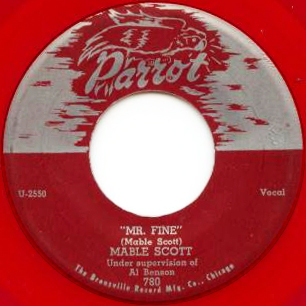
Parrot 780 was released in July 1953. Parrot 780 was the very first release on the label; an advertisement in Cash Box for Parrot 780 and 781 proclaimed "NEW LABEL" in big letters. Parrot 794 appeared in December 1953 or January 1954. Jukebox Lil JB606 was a Swedish LP, released in the 1970s and titled simply Mabel Scott. Relic 7027, Rockin' at Midnight at the Parrot Club, was a CD issued in 1990, consisting of R&B from the Parrot label: artists included Lou Mac, the Five Thrills, Browley Guy, and the Maples, among others. Classics 5107, Mabel Scott 1951-1955, was released in 2004.
What we have on U2550 and U2551 (which immediately precede U2552 and U2553 by The Chocolateers, done on the same date) is the Red Saunders band with King Kolax as a guest soloist. Kolax is obviously the somewhat coarse, muted trumpet soloist on "Mr. Fine," an ironic ode to an abusive cad. The band is way too large to be the Kolax combo of the period, and it sounds like the same Red Saunders ensemble that backed the Chocolateers. Mac Easton has a brief tag near the beginning of "Mr. Fine" and a longer solo in the middle, both unmistakable; the impeccably recorded drummer is definitely Red. There is no electric guitar on the session, contrary to LFP. Booby Floyd, Leon Washington, and Porter Kilbert are each briefly heard on the minatory "Mabel Blues," where Red continues to be prominently recorded. "Fool Burro," as the title suggests, is a Latin number; it employs just King K and the rhythm section. The peppy "Do the Thing," which undoubtedly gave the DeLisa chorines a workout, brings back the entire band but the vocal patter leaves no room for solos.
Before release, "Fool Burro" and "Do the Thing" were given different matrix numbers from the series that Parrot adopted in August 1953. But Donn Fileti of Relic Records (which owns most of the remains of the Parrot and Blue Lake labels) says that all four Mabel Scott titles were done at the same session, and a list of Parrot tapes that were dealt to Chess in 1958 or 1959 tells the same story. According to Fileti, the date on the original tape box is June 10, 1953. However, several other sessions that were made as Al Benson prepared an independent launch for his Parrot operation are also dated June 10 (including a session by blues guitarist L. C. McKinley that other sources have placed on May 19). We suspect that tapes of several sessions from April and May 1953 were consolidated on June 10.
Further support for a Saunders connection (and for a May date) derives from the fact that Mabel Scott was the star attraction at the Club DeLisa for the week of May 16, 1953; the revue was called "A May-Hey Day." In "Fool Burro," Mabel Scott sings about wanting to travel "from Mexico to Chicago."
Despite first-rate performances—of superior material in the case of "Mr. Fine" and "Mabel Blues"—Scott's Parrot sides didn't sell well either, and her session for Al Benson was the last that Mabel Scott would make in the United States. She laid down four sides for the Festival label while on tour in Australia in 1955. In the late 1950s, after the breakup of her second marriage, she underwent a religious conversion and for the rest of her life performed only in church. Mabel Scott died in Los Angeles on July 19, 2000.
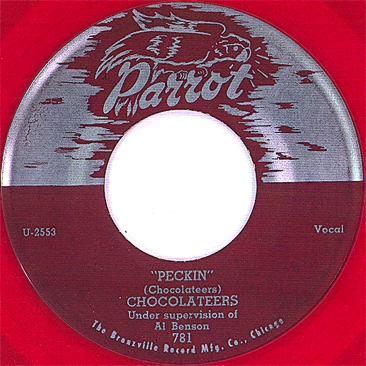
Chocolateers (comedy ensemble) accompanied by the Red Saunders Orchestra: Red Saunders (d, ldr); Sonny Cohn (tp); Fip Ricard (tp); Harlan "Booby" Floyd (tb); Porter Kilbert (as); Leon Washington (ts); McKinley Easton (bars); Earl Washington (p); prob. Jimmy Richardson (b).
Universal Recording, Chicago, prob. May 1953
| U2552 | Bartender Blues (Chocolateers) | Parrot 781B, Relic LP 7027, Relic 7027 [CD] | |
| U2553 | Peckin' (Chocolateers) | Parrot 781A, Relic LP 7027, Relic 7027 [CD] | |
| Waitin' for Jane | unissued | ||
| Little Willie | — |
Thanks to Robert Pruter for information on this session. The original tape box says June 10, 1953, but the matrix numbers in the U2500 series precede those assigned to the Curtis Jones sides on Parrot 782, which we have reason to believe were recorded on May 19. So the actual recording date was a little earlier than the date on the box.
Parrot 781 was the original single, released in July 1953. Relic 7027 is an LP and CD release from 1990 (at least in the CD configuration) titled Rockin' at Midnight at the Parrot Club.
Personnel were identified by ear. The Chocolateers were a three-man comedy group (billed as "The Three Chocolateers" in Club DeLisa ads), and they chant, talk, shout, or screech more often than they sing. There's a bit more music on "Peckin'" than on the flip side. Porter Kilbert is prominently leading the ensemble on "Peckin'"; Booby Floyd has a short solo on the same number; and Mac Easton's baritone can be heard at the end of "Bartender Blues," a slapstick sketch that features loud drum rolls from Red whenever the characters go upside each other's heads. The piece has been titled "Bartenders' Blues" or even "Bartenders' Blues 'Ball'" but the inaugural Parrot advertisement in Cash Box(reproduced in the Relic CD leaflet) calls it "Bartenders Ball"—and that's the only title that makes sense. But "Bartender Blues" is on the label.
The MFD Files mention two more unissued numbers by the Chocolateers, presumably from this same session.
We have no information about the personnel of the Chocolateers in 1953. However, an article in the Defender of July 7, 1956 mentions the Chocolateers' tour of France, where they worked in Paris and on the Riviera (before Princess Grace and Prince Rainier, among others). The Chocolateers also made it to Spain, Italy, Belgium, and Switzerland, and played on the BBC. A photo shows three gentlemen, somewhat long of tooth, with one member in a comic pose.
The Defender described the group as an acrobatic, song, and dance combination. The members in 1956 were "Half Pint" (Eddie West), "Fat Man" (Paul Black), and "String Bean" (Charlie Walker). Charlie Walker also played the vibraphone. There is no vibraphone on the 1953 sides, and at least one other Chocolateer was replaced between 1953 and 1956: "Half Pint" took the place of "Little Willie," a prominent character on the 1953 session.
One thing any new Chocolateer had to be able to do was peck. Here's a description of the Chocolateers in Spring 1957, from Ted Fox's book, Showtime at the Apollo: "The show featured a variety of entertainers like pianist Buck Washington, singer Jackie Starr, and the Three Chocolateers, who created pandemonium by running through the audience bobbing their heads, craning their necks, and singing the 'Pecking' song."

Cliff Butler (voc); poss. Dick Davis (ts); Benny Holton (p); unidentified (eg); Jimmy Richardson (b); Red Saunders (d); The Doves (male vocal quartet -1).
Universal Recording, Chicago, June 29, 1953
| 1343 | People Will Talk^ (Butler) -1 | States 123, United U-163 [CD] | |
| 1344 | TB | unissued | |
| 1345-2 | Jealous Hearted Woman -1 | States 148, P-Vine Special [J] PLP 9045, Pearl PL-17, United U-163 [CD], Delmark DE-717 [CD] | |
| 1346 | When You Love (Butler-Glover)^ -1 | States 123, United U-163 [CD] |
Our session information (minus personnel) comes from Bob Koester's 1977 discography of the United and States labels. States 123 was a 78 and 45 rpm single released in July 1953. It was promoted by Dave Clark, in his "Rhythm and Blues Tattler" column in Billboard, August 8, 1953, p. 36, and reviewed in the August 29 issue, p. 44. States 148 was probably released in May 1955.
For his second session for States, Butler again brough The Doves with him; their lineup is not known. The instrumental lineup on "Jealous Hearted," as it is called on PL-17, appears consist of Richardson and Saunders along with Butler's buddy Holton. Again, there is just one horn (not two tenors as stated in the Pearl notes); this time around the tenor saxophonist sounds like Dick Davis (to rlc). On "People Will Talk" there is a tenor sax solo by whoever it is (ab is not sure that that it is Davis). There are no solos on "When You Love" and the guitarist has either switched to an acoustic instrument or turned his amplifier way down.

P-Vine Special PLP 9045 was a Japanese LP issued in 1982 under the title Black Music in the 50's Volume 13: Standup and Sing the Blues. The other titles were mostly derived from the United and States labels. Pearl PL-17 was a 1989 LP of United and States material titled Long Man Blues; Long Man Blues on Delmark DE-717 is a CD reissue from 2000 that includes the entire Pearl LP but adds material by other artists. The Pearl and Delmark notes give the session date incorrectly as 1952. United U-163 is a bootleg CD issued in 1999 under the title Rare Windy City R&B Vocal Groups From the street-corners of Chicago Volume One.
This band was definitely not a Red Saunders unit; Red does appear to have been on drums, however.

Alberta Adams (voc); Red Saunders (d, dir); Sonny Cohn or Fip Ricard (tp); Leon Washington (ts); McKinley Easton (bars); Earl Washington (p); Jimmy Richardson (b).
United Sound Studios, Detroit, July 16, 1953
| 7535 | Messin' around with the Blues (Nelson) | Chess 1551, Chess CHD-9330 [CD], MCA MCAD2-11788 [CD] | |
| 7536 | This Morning (C. Adams) | Chess 1551 | |
| 7537 | Remember | Chess CHD4-9340 [CD] | |
| 7538 | No Good Man | unissued |
The signing of Alberta Adams, who had recently completed a run at the Flame Club in Detroit, was announced in Billboard, "Rhythm and Blues Notes," July 4, 1953, p. 47. How often was Alberta referred to as a "thrush"? Meanwhile, in July 1953 Alberta Adams was frequently appearing in public as part of a duo, The Bluzettes, with Chubby Newsom (neither singer was actually chubby, but that's a long story). Chess was apparently not interested in her duet partner, who had recorded most recently for Chance. Newsom had had records out previously on DeLuxe and Regal. Adams had previously done one side with T. J. Fowler's band, in 1952, but the record was not released at the time.
We are crediting this session to Red's band strictly by ear, but no one else was playing like this for recording sessions on Chicago-area labels. The uncredited backing on "Messin'" and "Remember" is more typical of Aristocrat in 1947 than of Chess in 1953, though there is more tonal suavity here than on most Aristocrat R&B recordings. The rambunctious riffing on "This Morning" is dominated by Mac Easton's baritone sax. Of course we have not heard "No Good Man," a title preserved in Michel Ruppli's Chess discography and unmentioned in other discographies that we have consulted.
The prominent baritone sax obbligato on "Messin'" (a number that Memphis Slim recorded for Miracle in 1947 and would re-record for Vee-Jay) seems to be by Mac Easton, and there can be no doubt about the booting baritone sax solo on "This Morning." The "crying" muted trumpet on "Remember" is reminiscent of the Basie band behind Jimmy Rushing and was pretty archaic for an R&B recording by this time. Sonny Cohn plays a similar obbligato on "Time for Moving" from the session with Joe Williams, but here the obbligato is delivered with such Eldridgean fervor that it might be Fip Ricard instead. Interestingly, there are no tenor sax solos on the sides that we have heard from this session.
Chess 1551 was a single probably released in October 1953; thanks to Tom Kelly for label copy and a dub of "This Morning." The single was duly flogged in Dave Clark's "Rhythm and Blues Tattler," Billboard, November 28, 1953, p. 51. Chess CHD-9330 is a various-artists CD compilation from 1991 titled The Blues, Volume 6: '50s Rarities. Chess CHD-9340, Chess Blues, is a 4-CD collection released in 1992; the liners do not give matrix numbers, and the composer is listed as unknown. MCAD2-11788, Women Blues Singers 1928-1969, is a various-artists CD released in February 1999; thanks to R. J. Spangler for alerting us to this one.
Lord gives 1954 as the recording date (which is simply not consistent with the matrix numbers) while the Chess Blues booklet gives the more plausible estimate of June to July 1953.
Alberta Adams was born Roberta Louise Osborn, in Indianapolis on July 26, 1917. According to Lars Bjorn and Jim Gallert's book Before Motown (University of Michigan Press, 2001), her family moved to Detroit while she was a child. Her long resumé begins in the late 1930s and includes turns as a shake dancer, tap dancer, comedian, and MC as well as singer. In 1947 she was popular enough on the Detroit scene to win one of the annual awards offered by a Detroit entertainment weekly. She got onto a recording session, with T. J. Fowler's band, on July 25, 1952. Fowler was then under contract to Savoy; unfortunately, the one number she sang on, "Say Baby Say" went unreleased until the 1970s, when it was included in an LP. She performed on two different occasions with Duke Ellington, toured with Louis Jordan, Roy Eldridge, and Cleanhead Vinson, and from 1953 to 1955 was frequently partnered with Chubby Newsom in a vocal duo called the Bluzettes. Alberta Adams headlined at the 1994 Montreux/Detroit Jazz Festival and finally retired from performing in the Detroit area at the age of 95. In 1999 she put out a CD on the Cannonball label, with a band that included Johnnie Bassett on guitar and R. J. Spangler on drums. A second CD on the same label followed in 2000; one on Eastlawn was released in 2004; her last CD was completed in 2008. Many thanks to her agent, R. J. Spangler, for intially alerting us to Alberta Adams's continued activity; an archived Web page on her can be seen at http://web.archive.org/web/20070828052018/http://www.spanglerbluesproductions.com/rjalberta.html.
According to Spangler, Alberta Adams recollected that the session took place at United Sound Studios in Detroit, and that the band traveled from Chicago to back her. She would have preferred Maurice King's band, a solid unit with which she was working regularly (and which recorded for King and OKeh), but the sides we've heard indicate a successful session.

Jo Jo Adams (voc) with Sonny Cohn (tp); Leon Washington (ts); McKinley Easton (bars); Floyd Smith (eg); Earl Washington (p); prob. Jimmy Richardson (b); Red Saunders (d); Sun Ra (arr).
Universal Recording, Chicago, September 1953
| P 53117 | It's Been So Long | unissued | |
| P 53118 | Corrine | rejected | |
| E-53119 | Call My Baby (Adams) | Parrot 788, Relic 7016 [CD], Classics 5083 [CD] | |
| E-53120 | Rebecca (Adams) | Parrot 788, Relic 7016 [CD], Classics 5083 [CD] |
Parrot 788 was released in November 1953; it was reviewed in Billboard on November 21, p. 56. The reviewer didn't appear to notice anything unusual about the accompaniment.
In all previous discographies the personnel of Parrot 788 was given as unknown.
It is obvious to the ear that this is a Red Saunders ensemble, and that Red is on drums. Sonny Cohn is the lead trumpeter. There is no alto saxophone. Leon Washington solos on both sides, a little more grittily than usual. The feature for guitar in "Call My Baby" is the work of player with a heavy attack, like Charlie Christian or T-Bone Walker; the guitarist accompanies four to the bar throughout both tracks in a Freddie Green style. The same guitarist appears to have been on Adams' 1947 session with Tom Archia for Aristocrat. Whoever it is, it isn't Ike Perkins.
The pieces may both be midtempo blues in the same key, but the band is clearly reading from charts. The arrangements definitely are by Sun Ra; especially on "Call My Baby," they keep threatening to turn into early Arkestra numbers, then veer temporarily back to the usual formulae. The arrangements are not just remarkable in their own right; they show Sun Ra's "far out" style emerging from its chrysalis. Thanks to the late Otto Flückiger for careful listening to these sides.

Parrot did not credit a composer on either released side; however, Relic gives Jo Jo Adams as the composer.
By interpolation in the Parrot matrix series (see our Parrot Discography), a date in September 1953 is indicated. The E- prefix indicates that this record was originally slated for release on a subsidiary called Eagle, which Al Benson ended up deciding not to open. In the list of Parrot/Blue Lake tapes that were leased to Chess in 1958 or 1959, four Jo Jo Adams tracks were included in tape box 2027 along with six tracks by the Crume Brothers, a gospel group. The Chess tape list is our source for the titles of the two unreleased sides. "Corrine," which according to Donn Fileti was rejected, was an attempted remake of a number from Jo Jo's first session for Melody Lane/Hy-Tone.
Relic 7016, Cool Playing Blues: Chicago Style, is a CD of Blues material recorded for Parrot Records. The other featured artists are "Little Papa Joe" [Jody Williams], L.C. McKinley, Curtis Jones, St. Louis Jimmy (see the 1956 entry below) and J.T. "Nature Boy" Brown. Classics 5083, Jo-Jo Adams 1946-1953, was released in 2004.
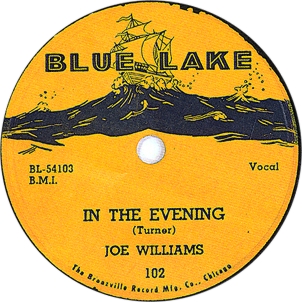
Joe Williams Sings Everyday
Joe Williams (voc) with the Red Saunders Band: Red Saunders (d, dir); Sonny Cohn (tp); Riley Hampton (as); Leon Washington (ts); McKinley [Mac] Easton (bars); Earl Washington (p); Ike Perkins (eg); Walt Champion (b); Sun Ra (arr).
Universal Recording, Chicago, September 28, 1953
| 53126? | It's Raining Again (Ra) | Regent 6002, Savoy MG 12216, Savoy SJL 1140, Denon/Savoy SV-0199 [CD] | |
| 53127? | Always on the Blue Side (Ra) | Regent 6002, Savoy MG 12216, Savoy SJL 1140, Denon/Savoy SV-0199 [CD] |
Joe Williams (voc) with the same ensemble.
Universal Recording, Chicago, September 28 or December 31, 1953
| Detour Ahead (J. Frigo-Carter-H. Ellis) | Regent 6002, Savoy MG 12216, Savoy SJL 1140, Denon/Savoy SV-0199 [CD] | ||
| Blow Mr. Low (Saunders-D. Williams) | Savoy 1165-A, Regent 6002, Savoy MG 12216, Savoy SJL 1140, Denon/Savoy SV-0199 [CD] | ||
| BL-54104 | Tired of Moving (Williams) Time for Moving* |
Blue Lake 102, Savoy 1165-B*, Regent 6002*, Savoy MG 12216*, Savoy SJL 1140, Denon/Savoy SV-0199 [CD], Empire Musicwerks CD N-1 | |
| BL-54103 | In the Evening (L. Carr) | Blue Lake 102, Regent 6002, Savoy MG 12216, Savoy SJL 1140, Denon/Savoy SV-0199 [CD], Empire Musicwerks CD N-1 |
Blue Lake 102 was a 78 and 45 rpm single released in January 1954 (which is when Parrot opened its Blue Lake subsidiary). "In the Evening" is credited to Joe Turner on the original label. "Tired of Moving" (retitled "Time for Moving" on some reissues) and "Blow Mr. Low" first appeared on Savoy 1165, a 45-rpm single released in August 1955 (it was advertised and reviewed in Cash Box on August 6, pp. 24 and 28). In previous discographies, Savoy 1165 was misidentified as Savoy 116; we didn't recognize the error until we found the publicity for 1165 in the trades.
We have grouped together the two items known to have been recorded on September 28, but have otherwise followed the order of the tracks on the Regent and Savoy LPs, as we do not know the original matrix numbers—or even the precise recording date for four of the six tracks.
Parrot / Blue Lake was sold in March 1956 and became inactive in the fall of that year. While some of the remnants were licensed to Chess later, and others ended up in the hands of Relic Records, a batch of Joe Williams masters was sold to Regent/Savoy (which also bought a Coleman Hawkins session from the defunct label). All 6 tracks from this session were released in August 1956 on the LP Regent 6002, titled Joe Williams Sings (it was reviewed in Billboard on August 25, 1956, p. 29). They later appeared on LP as Savoy MG 12216 as Joe Williams Sings Everyday and were reissued (in 1984) on Savoy SJL 1140 under the title Everyday I Have the Blues.
We'd thought the Regent LP was Savoy's first use of the material from these sessions, but it turns out that Savoy 1165 was released in August 1955 (Joe Williams was enjoying a big R&B hit with the version of "Everyday" he'd made with Count Basie. To take advantage of the big sales that Clef 89149 was pulling in, Chess re-advertised his 1952 recording on Checker 762 (which could fairly be identified as "the original").
Savoy wanted a piece of the action, and apparently Al Benson wasn't convinced he could capitalize on it. At least "Tired of Moving" and "Blow Mr. Low" were dealt to Savoy in July 1955, while Parrot and Blue Lake were still going concerns. The Savoy single was credited to "Joe (Everyday) Williams with Orchestra." Savoy didn't have the 1952 master for the first version of "Every Day," and wouldn't get it until well into the next year. Meanwhile, we don't know whether Benson had dealt other sides to Savoy. But if "In the Evening" was in Herman Lubinsky's hands in the summer of 1955, he would have had to hold it back, as "(In the Evening) When the Sun Goes Down" was the B-side on Williams' second single with Count Basie, Clef 89152 (see the ad in Cash Box for September 3, 1955, p. 7).
The Savoy album was reissued in its entirety on CD as Denon/Savoy SV-0199; issued in 1993, this reverted to the title Sings Everyday. All of these releases contained four other tracks recorded by Williams with a King Kolax unit (see the King Kolax Discography for these). In addition, the two sides that appeared on Joe Williams' Blue Lake single reappeared (in excellent sound) on Empire Musicwerks CD-N1, a collection of Parrot/Blue Lake jazz sides titled Jukebox Jazz! From the Southside of Chicago and released in December 2002.
The personnel are as listed in various sources, including Leslie Gourse's book, Every Day: The Story of Joe Williams (Quartet Books, 1985); Leadbitter et al. agree. Gourse says Williams gave 1950 as the date, but this is flatly unreliable (Blue Lake/Parrot did not exist in 1950!). And judging from Red's other recordings, there's no way he would have been performing so "modern" an arrangement as "It's Raining Again" in 1950. Walt Champion was also known as Walter Cole; he became Red's regular bassist later in the 1950s.
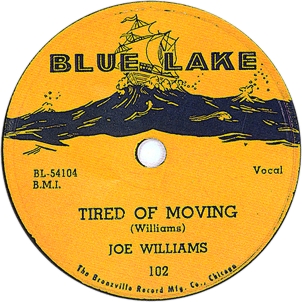
Leadbitter et al., reading more into the matrix numbers on the Blue Lake labels than is appropriate, give December 31, 1953 as the date, but the band on these vocal sides is smaller and includes a guitarist. In earlier versions of this discography, we gave early 1954 as the date. However, Bob Porter in his liner notes to SJL 1140 says that "It's Raining Again" and "Always on the Blue Side" were done on September 28, 1953 and the other four sides were cut "during that period." (The September 28 date is from the outside of a tape box, as was the custom at Parrot/Blue Lake.) A magazine article promoting the label appeared in December 1953 (now reproduced on our Parrot page); Joe Williams was one of the artists mentioned, so obviously some recording had already been done by then. Nothing would have prevented the sides from all being done at one session, but the only vacant Parrot matrix numbers around September 28, 1953 are 53125 and 53126, while a block of 6 matrix numbers (53179 through 53184) opens up around the December 31 session. As many as four of the items we have listed here could actually be from the later session.
These were Joe Williams' last recordings in Chicago; he left town to join Count Basie around Christmas 1954.
Sun Ra discographer Julian Vein believes that all but "Blow Mr. Low" and "In the Evening" were arranged by Sun Ra; he publicized his opinion as early as 1967. Ra's involvement with "It's Raining Again" and "Always on the Blue Side" is particularly obvious; in fact, the lack of listed composer credits for these items is most intriguing. Sunny was not copyrighting any of his pieces during this period and "Raining" and "Blue Side" sound like Ra compositions! "Tired of Moving" is a straightahead blues that Sunny is less likely to have composed; the original Blue Lake label attributes it to Joe Williams. Given Sunny's involvement with Saunders when the original "Blow Mr. Low-Blow" was cut in 1950, he probably at least retouched this piece and "In the Evening."
According to the c. 1959 list of Parrot/Blue Lake tapes in the Chess vaults, four tunes by the doowop group the Pelicans were included in tape box 2059, along with Joe Williams tracks no longer there after the sale to Savoy. The Pelicans, however, were accompanied by tenor saxophonist Paul Bascomb and his rhythm section (see our Parrot page for detaila).

Joe Turner (voc); Sonny Cohn (tp); Grady Jackson (ts); McKinley [Mac] Easton (bars); Johnny Jones (p); Elmore James (eg; slide-eg on -1); Jimmy Richardson (b); Red Saunders (d).
Chicago, October 7, 1953
| A-1125 | Love to Spare | unissued | |
| A-1126-1 | Ti-ri-lee (Turner-"Nugetre"-"Gerald") | Atlantic 1053, Quality [Can] 1358, Atlantic LP 8033 [?], LP 8081 [?], Atlantic 81663 [LP and CD], Charly 1070, Blues Encore CD 52008, Rhino/Atlantic 71550 [CD] | |
| A-1127 | Oke-she-moke-she-pop (L. W. Turner) | Atlantic 1016, Atco SD33-376, Charly 1070, Atlantic LP 81696 | |
| A-1128 | TV Mama (L. W. Turner) -1 | Atlantic 1016, Atlantic EP536, Atlantic LP 8023, Atco SD33-376, Atlantic 81663 [LP and CD], Atlantic 81695 [LP and CD], Charly 1070, Blues Encore CD 52008, Rhino/Atlantic 71550 [CD], Rhino 71190 [CD] |

There has been a truly amazing amount of confusion about this session. The date is the mildest source of trouble—some sources give October 8 instead of October 7. Personnel listings have always been confused, in large part because "Ti-ri-lee" from this session has been mistaken for the "Ti-ri-lee" that was purportedly cut at the January 28, 1955 session, and because "Oke-she-moke-she-pop" from this session has been confused with "Oke-she-moke-she-pop" that was definitely cut at the previous Joe Turner session, in New Orleans on May 12, 1953.
At least there is no doubt about Elmore James being on the session (he had recently settled in at Sylvio's for a 6-month residency; his contract was accepted and filed by Musicians Union Local 208 on September 3, 1953). Michel Ruppli in his Atlantic Records discography lists Cohn, Jackson, Easton, James, and Richardson on this session—with "Odell" Payne as the drummer. Ruppli leaves off the A- prefix in the matrix numbers, probably because he got tired of writing it... Hugues Panassié, in his Discographie Critique (1958) mentions James, Jones, and Odie Payne. Jepsen gives similar information but omits A-1125 and A-1126. (The take number on A-1126 is incised in the vinyl of Atlantic 1053.) The liners to Atlantic 81752 and Atlantic 81696 give the above lineup with Red Saunders on drums. The booklet to the boxed set, Rhino/Atlantic 71550, adds an "unknown trombone," but this (like previous listings of a trombonist for this session on this page) derives from a confusion of the Chicago version of "Oke-she-moke-she-pop" with version cut on May 12, which did include a trombone.
Ruppli's information about 1125 is incorrect; Ruppli says that "Love to Spare" was released on Atlantic 1125, but James Wolf points out that Atlantic 1125 was a Ruth Brown record. It appears that the track was never released. Ruppli renders "Oke-she-moke-she-pop" as "Oke-she-make-she-pop."
Atlantic 1016 and 1053 were 78 and 45-rpm singles released in the 1950s. Atlantic 1053 was advertised (p. 30) and reviewed (p. 32) in Cash Box for February 26, 1955. Atlantic 1053 contains the A-1126 version of "Ti-ri-lee" and Atlantic 1016 contains the A-1127 version of "Oke." Quality 1358 was a Canadian release (78, probably also 45 rpm) that corresponded to Atlantic 1053; we presume that the same version of "Ti-ri-lee" was used on it.
There is allegedly another "Ti-ri-lee" with matrix number A-1425 from a session on January 28, 1955 (see Spuriosity D below). We have yet to find evidence of it; every release that has been checked by James Wolf contains the same recording from October 7, 1953. Needless to say, the two versions of this tune have compounded the confusion caused by the two versions of "Oke." On recent Joe Turner collections, such as Atlantic 81663 and Rhino/Atlantic 71550, "Ti-ri-lee" has been grouped with tracks from the January 28, 1955 session. And the Rhino box repeats the October 7, 1953 personnel list for this session (except for allowing that Al Sears, from the 1955 session, may have played tenor sax!). Releases that have not been checked so far are marked with [?].

"Oke-she-moke-she-pop" (A-1072) was first attempted at a session in New Orleans on May 12, 1953. It is usually asserted that the first version was rejected, and all that all releases contain the versions from the October 7 session. This turns out to be wrong. The first "Oke-she-moke-she-pop" has been released several times (very likely not on purpose). The other items recorded at the May 12 session were supposedly A-1071, "This'll Make You Laugh" (never issued), and A-1073 "Honey Hush" along with A-1074 "Crawdad Hole"; A-1073 and 1074 were both issued on Atlantic 1001 and reissued many times. Rumors have mentioned an embryonic "TV Mama," too, but there is no confirmation of this—unless A-1071 is really "TV Mama" under a different title. To make things worse, the location of the May 12th session has been disputed; Ruppli and others say it was done in New Orleans, but Lord's Jazz Discography claims New York City as the location. Lord's interpretation is hard to buy, because for personnel he gives Pluma Davis (a trombonist and bandleader whose home base was Houston, Texas) and known New Orleanians Lee Allen (tenor sax), Red Taylor (baritone), and Antoine "Fats" Domino (piano), along with unidentified eg, b, and d. Here we get a sense of how tangled the Atlantic discography has become.
The original single, Atlantic 1016, lists A-1127 on the label and plays the October 7 version of "Oke-she-moke-she-pop." Charly 1070 and Atlantic 81696 contain A-1127 (confirmed by James Wolf); on Atlantic 81696, it is further identified as an "alternate master." Bob Porter says that Atco SD33-376 also used A-1127. According to Daniel Gugolz, the following issues of the tune all contain A-1072 (though most claim A-1127): Atlantic LP 8005, Atlantic 81695 [LP and CD], Atlantic 81752 [LP and CD] (confirmed by James Wolf and the authors), and Rhino/Atlantic 71550 [CD] (confirmed by James Wolf)!
The two versions are easily distinguishable. They have the nearly the same lyrics, but in the New Orleans version, Big Joe sings "Step into my Cadillac" in the last verse. In the Chicago version this has become the slightly lower-status "Step into my Roadmaster." The first version is moderately slow and the drumming plods, while the Chicago version is powered by Johnny Jones (who launches it with his piano intro) and Elmore James. The first version includes a prominent trombone, played by bandleader Pluma Davis, and solos by a fairly smooth tenor saxophonist (Lee Allen) and a baritonist (Red Taylor); the Chicago version has only a rather gritty tenor solo (Grady Jackson).
Atlantic 8005 was an LP titled simply Joe Turner; it was released in 1958. Atlantic 8023, another LP titled Rockin' the Blues was released in 1959, as was 8033, Big Joe Is Here. Atlantic 8081, The Best of Joe Turner, was a 1963 release (information on these items from the Goldmine Price Guide to Collectible Jazz Albums, 1949-1969, 2nd edition). Atco SD33-376 was a late 1960s release, title not yet identified.
Atlantic 81663 was a 1986 double album titled Big Joe Turner: Rhythm & Blues Years, (reissued on one CD in 1988) and Atlantic 81752 was an LP-CD release from 1989, Big Joe Turner's Greatest Hits. Both give the personnel above, with Red Saunders as the drummer. So does the 6-LP or 4-CD compilation Atlantic 81695, released in 1986 and denominated Atlantic Blues. Atlantic LP 81696 was a 1980s 2-LP compilation out of this larger set titled Atlantic Blues: Vocalists. Charly 1070 was an LP titled Joe Turner: Jumpin' with Joe.
Rhino/Atlantic 71550 is a 3-CD boxed set released in 1994 and titled Big, Bad & Blue: The Big Joe Turner Anthology. Rhino 71190 is a CD issued in 1993 under the title The Sky Is Crying: The History of Elmore James; the rest of the CD collects Elmore James' performances for other labels.
Final thoughts on the personnel: In the All Music Guide to the Blues, this session is said to have been made with Elmore James' band, which would argue in favor of Odie Payne Jr. on the traps. None of the tenor solos are by Leon Washington (Red's tenor player)—or J. T. Brown or Boyd Atkins (the tenor players in Elmore's band). The tenor soloist is said in multiple sources to have been Grady Jackson. The Chicago version of "Oke-she-moke-she-pop" has a very gritty tenor solo (the tenor solo on the New Orleans version is smoother). "Ti-ri-lee" has a gritty solo, probably by the same person. (There are no horn solos on "TV Mama.") Meanwhile, the baritonist does not solo on the three surviving numbers from this session, but he's obviously Mac Easton anyway. It appears that Ruppli had the horn section right. But what about the drummer?
The drummer on these tracks does not use the whomping backbeat for which Odie Payne was known, or the cowbell accents; there is nothing to rule out Red Saunders. On "TV Mama," the drummer is definitely not Payne; it is someone who is much less familiar (or comfortable) with Elmore's customary rhythmic manipulations. The same stodginess can be noted on "Ti-ri-lee," though on that one, at least, the drummer is allowed to conclude with a small flourish. Red Saunders, sticking to basics in an unfamiliar setting...

The Rockettes -1: unidentified female lead, with tenor, baritone, and bass vocalists; unidentified female vocalist -2; with Sonny Cohn (tp); Leon Washington (ts); Earl Washington (p); unidentified (eg); Jimmy Richardson (b); Red Saunders (d).
Universal Recording, October 11, 1953
| E-53135 | Love Nobody | Parrot 789, Relic 7027, Relic 7027 [CD], Relic 7053 [CD] | |
| E-53136 | I Can't Forget (A. Dixon) | Parrot 789, Relic 7053 [CD] | |
| E 53137 | Boogie Woogie Blues -2 | unissued | |
| E 53138 | Blues for My Baby | unissued |
Parrot 789 was a single released in November 1953; it was listed in Billboard on November 21, 1953 (p. 50).]. Relic 7027 is a various-artists CD, titled Rockin' at Midnight at the Parrot Club and released in 1992; there was also an LP version. Relic 7053 is a CD of Parrot doo-wops titled The Golden Era of Doo-wops: The Groups of Parrot Records Part One.
The group was called The Rockets on the session documentation, but the name was spelled "Rockettes" on the Parrot label. "Love Nobody" has a distinctive a trumpet lead by Sonny Cohn and a tenor solo by Leon Washington, while "I Can't Forget" makes much less use of the horns and features a guitar solo. According to Robert Pruter's book Doowop: The Chicago Scene, "the identity of the Rockettes... will probably forever remain a mystery." However, it is clear from "Love Nobody" that the Rockettes' lead singer was a woman, and the composer of "I Can't Forget" was one A. Dixon. We identified the instrumentalists by ear. On "I Can't Forget" the Rockettes use a male lead; the female singer is clearly audible singing harmony. We identified the instrumentalists by ear; the guitarist is the same Mr. Four to the Bar who appeared on the Jo Jo Adams session.
"Boogie Woogie Blues" has the notation "female solo" on it (maybe the Rockettes' lead?) and "Blues for My Baby" has no artist indicated. Our thanks to Donn Fileti, proprietor of Relic Records, for information about this session. Fileti indicates that E 53135 through 53138 were on a single tape reel, indicating that all were cut at the same session. (The E prefix stood for Eagle, a projected Parrot subsidiary that was never launched.) The sessions immediately before and after this one in the matrix series (and in the file number series used on the list of Parrot tapes leased to Chess) are dated October 11, 1953 on the tape boxes.
Sister Rosetta Tharpe (voc; eg -1); Marie Knight (voc); Annette Weber (org); James Roots (p); James D. Richardson (b); Theodore "Red" Saunders (d).
Chicago, October 17, 1953
| 85396-A | I'm So Glad | Decca 48324 | |
| 85397 | All the Good We Can Do | unissued | |
| 85398 | Sing and Shout [SRT, SRT voc] -1 | Decca 48324, MCA [F] LP 510.129 | |
| 85399 | Shadrack [SRT, MK voc] -1 | Decca 48309 | |
| 85400 | Nobody's Fault but Mine [SRT, MK voc] | Decca 48309 | |
| 85401 | God Spoke to Me [MK voc] | Decca 48308 | |
| 85402 | Calvary [MK voc] | Decca 48308 | |
| 85403-A | I Tell It Wherever I Go [MK voc] | Decca 48320 | |
| 85404-A | This Old Soul of Mine [MK voc] | Decca 48320 | |
| 85405 | Stand the Storm [SRT, MK voc] -1 | Decca 48332, MCA [F] LP 510.129 |
Thanks to Daniel Gugolz for bringing this session to our attention, and for providing dubs from his collection. Our session details came from Cedric Hayes and Robert Laughton, Gospel Records, 1943-69,published in 1992 by RIS. Hayes and Laughton neglect to mention Sister Rosetta's guitar, and they put the session in New York City, which is very unlikely. No replacement band was playing the DeLisa in October 1953, so far as we know.
Decca 48309 was reviewed in Billboard on December 5, 1953 (p. 26) and in Cash Box on the same date (p. 26). Decca 48308 was identified as a "New Record to Watch" in Billboard for January 2, 1954 (p. 20). Decca 48320 was reviewed in Billboard on July 3, 1954 (p. 24). Decca 48324 was reviewed in Cash Box on November 6, 1954 (p. 28) and in Billboard on November 13 (p. 72). The last in the series, Decca 48332, used one side from this session; it was reviewed in Cash Box on March 12, 1955 (p. 29) and in Billboard on March 19 (p. 46)
Marie Knight (1925-2009) worked regularly with Sister Rosetta Tharpe from 1947 through 1953. On "Sing and Shout," Sister Rosetta duets with herself via overdubbing. French MCA 510.129 is an LP titled Sister Rosetta Tharpe and Marie Knight 1951-56. At least some of this material has been available on cassette as Sister Rosetta Tharpe/Marie Knight, Great Gospel Music, MCA Special Products MCAC-20721. To be researched.
The Mohr-Flückiger-Demeusy files contain a cryptic reference to a Sister Rosetta Tharpe session with Sonny Cohn (tp); Porter Kilbert (as); Andrew "Goon" Gardner (as); Oett "Sax" Mallard (ts); Earl Washington (p); Jimmy Richardson (b); and Red Saunders (d). No date or titles. It is not known whether this is an incorrect reference to the above session, or Red was on another session with Sister Rosetta—but if this was the case, we haven't been able to identify it.

Valaida Snow (voc); with Harlan "Booby" Floyd (tb); Leon Washington (ts); McKinley Easton (bars); prob. Ike Perkins (eg); Earl Washington (b); Jimmy Richardson (b); Red Saunders (d).
Universal Recording, Chicago, November 1953
| U-4405 | I Ain't Gonna Tell (Toombs) | Chess 1555 | |
| U-4406 | L&N | unissued | |
| U-4407 | If You Don't Mean It (Singleton) | Chess 1555 | |
| U-4408 | Does You Do | unissued |
A hat tip to Yves François Smierciak for alerting us to the Red Saunders presence on this session. Trumpet player and singer Valaida Snow, born in Chattanooga, Tennessee, on June 2, 1904, first arrived in New York City in 1922. She became very popular in Europe during the 1930s, where she made most of her recordings. She was caught in Denmark during the Nazi occupation and suffered terribly after being sent to prison, probably on drug charges, before her return to the US was arranged in May 1942. She appeared at the Rhumboogie Café in the fall of 1943. Snow continued to record sporadically for small labels in the United States after World War II, incuding Bel-Tone (one of her Bel-Tones was reissued by Gold Seal). The Chess brothers filed the session at the tail end of their U4300 matrix series, instead of their main U7000 series, which makes it harder to date.
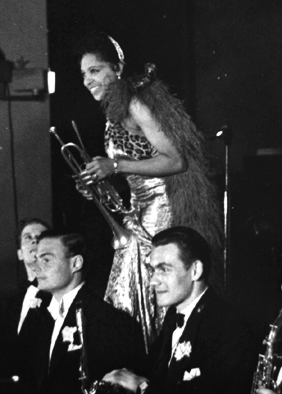
Chess 1555 was a 78 and 45-rpm single released in late November 1953. It was plugged in Dave Clark's "Rhythm and Blues Tattler" in Billboard, December 5, 1953, p. 38. The record was replugged two weeks later, December 19, 1953, p. 50. We used to think that the session was done shortly after the Alberta Adams session, which took place in Detroit in July. But unless it was done out of town, the only real window during which it could have been made was while Snow was headlining at the Crown Propeller Lounge: her contract for 2 weeks there was accepted and filed by Local 208 on November 19. And it would have made sense to rush the single out, while she was still in town. If that was the marketing strategy, however, it didn't pay off; by all accounts Chess 1555 is quite rare.
We identified the instrumentalists by ear. We assume Valaida brought her trumpet to the session, even though in those days she was under doctor's orders not to play it, but we don't hear it on either of the issued sides. This would explain why Red didn't bring Sonny Cohn or Fip Ricard, and why the horn section sounds bottom-heavy. Mac Easton gets a solo on "I Ain't Gonna Tell." The guitarist, who solos on "If You Don't Mean It," sounds more like Ike Perkins than the "Mr. Four to the Bar" who appears on the Jo Jo Adams and Rockettes sessions.
The Chess session was Valaida's very last. Although her style had become somewhat dated, and she would have benefited from a Swing number or two, she was still in good voice on this R&B outing. Her trademark flights and swoops work better on the ebullient "I Ain't Gonna Tell" than on the ballad "If You Don't Mean It." Valaida Snow died in New York City on May 30, 1956.

Count (prob. Floyd) Morris (p); Leon Washington (ts); prob. Jimmy Richardson (b); Red Saunders (d).
Universal Recording, Chicago, December 20, 1953
| 53-127 | Blues at Three | Vee-Jay 134, Lost Nite 264, Collectables 01431 |
Jørgen Jepsen's Jazz Records lists this session. But Jepsen credits Count Morris with vocals, and there aren't any! Any Count Morris would have had to be playing piano. Floyd Morris made his first record in early 1949 as a member of the Bob Perkins Trio (see our Planet page for details). Floyd Morris worked the clubs regularly during the 1950s, and played piano on a number of sessions in Chicago during the second half of the decade (he was a regular member of Johnny Pate's group—see our Eddie Johnson discography.) Leon Washington can be heard on tenor sax and Red is definitely on drums.
Vee-Jay 134 was a 45 and 78-rpm single, released in April 1955. The other side was "Tell the World" by the Dells, matrix 55-241, with a completely different band featuring Red Holloway (and not recorded till February 19, 1955, according to Flückiger's information). Lost Nite 264 was a 45-rpm single released in the 1960s, probably after the demise of Vee-Jay; Collectables 01431 is a 45-rpm reissue from the 1990s.
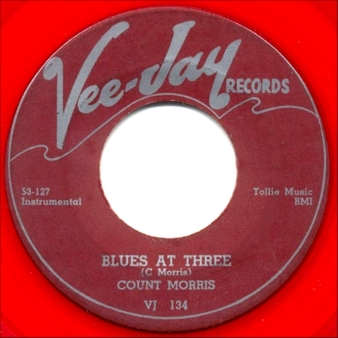
A single track like this from Vee-Jay would normally have been an instrumental cut during the remaining time on a vocal group session. The Spaniels cut 53-124 "Do-Wah," 53-125 "You Don't Move Me," and 53-126 "Gerald Blues" but they are said to have been accompanied by a band led by tenor saxophonist Al Pitts. However, there is the distinct possibility that Al Pitts led the band on the vocal group's previous session (September 23, 1953) and the three items aforementioned were done with the same Washington-Morris-Richardson-Saunders lineup. Stay tuned...
The next Vee-Jay entries are 53-128, "Schooldays on My Mind," and 53-129, "Ain't Times Hard," by bluesman Floyd Jones (they were released on Vee-Jay 111). Jones was backed on these, as well as 53-130 and 131, by Snooky Pryor, Sunnyland Slim, Eddie Taylor, and Alfred Wallace, and the session didn't take place until February 3, 1954 (obviously somebody at Vee-Jay was tardy in switching from the 53- prefix to the 54-).
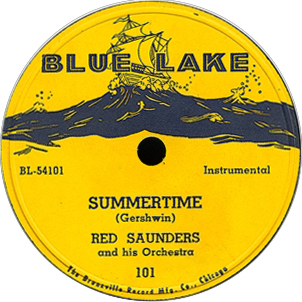
Red Saunders (d, ldr); Sonny Cohn (tp); Fip Ricard (tp); Marty Martinez (tb); Harlan "Booby" Floyd (tb); Porter Kilbert (as); Leon Washington (ts); Mac [McKinley] Easton (bars); Earl Washington (p); Jimmy Richardson (b); Sun Ra (arr).
Universal Recording, Chicago, December 31, 1953
| BL-54101 | Summertime (Gershwin) | Blue Lake 101, Chess CHV 415, Bellaphon [G] BJS4032, Empire Musicwerks CD-N1 | |
| BL-54102 | Riverboat (Clark Terry) | Blue Lake 101, Chess CHV 415, Bellaphon [G] BJS4032, Empire Musicwerks CD-N1 | |
| 53181? | Lawdy, Lucy [ens shouts] | Chess CHV 413, Bellaphon [G] BJS4031 |
Blue Lake 101 was a 78 and 45 rpm single released in January 1954. "Lawdy Miss Lucy" and perhaps another unknown title were intended for release on Blue Lake (they were assigned matrix numbers 53181 and 53182, according to Leadbitter, Fancourt, and Pelletier; LFP mistake these numbers from the main Parrot matrix series, which started at U53100 and skipped from a U53 prefix to a U55, for numbers in the Blue Lake series, which started at BL-54101).
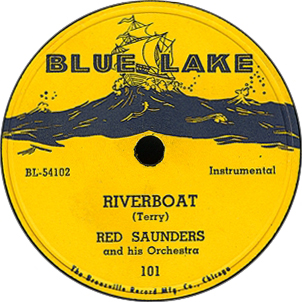
After Parrot / Blue Lake went belly-up in 1956, Chess acquired (probably leased) a big batch of \masters from the company's last owner, John "Lawyer" Burton, in 1958 or 1959. Chess LP CHV 415 (released 1972) was titled Southside Jazz and CHV 413 (also released 1972), a compilation including Leo Parker, Sahib Shihab, and Red Saunders, was titled The Late Great King of the Baritone Sax. (The band shouts "Lawdy Miss Lucy" but the LP gives the title as "Lawdy, Lucy." The track was included because of Mac Easton's prominent baritone sax solo, in a style influenced by Leo Parker.) The Bellaphon issues (which are mentioned in Tom Lord's Jazz Discography) were German reissues of Chess material; dates and album titles unknown.
The date and personnel are from Joe Segal's liner notes to the Chess LP, CHV 415. The lineup fits the instrumentation that can be heard on the tracks, and was probably provided by Red Saunders himself. Leadbitter et al. supply incomplete instrumentation and no personnel, give two unknown titles for December 31, 1953, and refer to "Riverboat" and "Summertime" as 1954 recordings.
Sun Ra is not mentioned as the arranger in those notes, but Julian Vein has concluded that these were his arrangements. The arrangements are much more aggressively "modern" than anything the Saunders band committed to record earlier (except the interlude in "Voodoo Blues," and the two Jo Jo Adams sides that were done for Parrot in September). They appear to be Sunny's work from start to finish. According to Segal, the trombone soloist on "Summertime" is Marty Martinez, whereas Booby Floyd can be heard on "Riverboat."
The Clark Terry composition first appeared on record as "River Boat" on Flame 1003. Issued on a subsidiary of Franklin Kort's Swing Time label, the 78-rpm single came out in March 1952, according to a mention in the "R. & B. Beat" column in Billboard. There it was performed, in a very different arrangement, by a group led by guitarist Ike Perkins. Clark Terry was featured on trumpet, and Lonnie Simmons, whose composition "Organism" was used for the B side, played organ. Either Simmons or Perkins could have brought "Riverboat" to Saunders' attention.
There was one more Red Saunders appearance on Blue Lake—a session with R&B singer Ann Carter, which produced the label's rarest release on Blue Lake 103. We used to think these were made at the December 31, 1953 session (although 3 of the instrumentalists on that session would have had to lay out for the Carter tracks, which use a smaller ensemble than the Joe Williams sides do). And in fact in the list of Parrot and Blue Lake master tapes leased to Chess in 1958 or 1959, "Summertime" and "Riverboat" are shown as being in the same tape box as the two Ann Carter numbers—but the Carter tracks are attributed to Joe Williams! Most likely there were Joe Williams tracks from December 31, 1953 that were taken out and sold to Savoy in 1956, and the instrumental tracks from December 31 were later put in the same box as the Carter items. The tape box number, 2453, is consistent with a recording date around May 1954; December 31, 1953 would have yielded a tape box number around 2250.
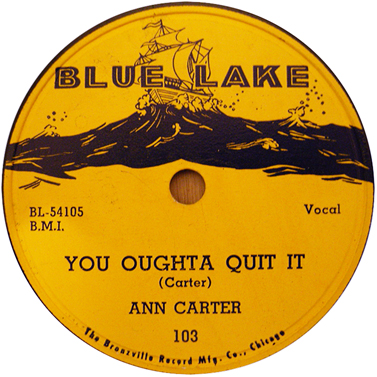
Ann Carter (voc) with Sonny Cohn (tp); Fip Ricard (tp); prob. Porter Kilbert (as); Leon Washington (ts); Earl Washington (p); prob. Jimmy Richardson (b); Red Saunders (d).
Universal Recording, Chicago, February 19, 1954
| BL-54105 | You Oughta Quit It (Carter) | Blue Lake 103, Krazy Kat LP KK 7448, TIM 220241/55 [CD] | |
| BL-54106 | Lovin Daddy Blues (Carter) | Blue Lake 103 |
Released around June 1954 on 78 rpm (collectors have not reported any 45s), Blue Lake 103 is a hard record to find today. Ann Carter (1915-1977) was the sister of Bob Carter, who played bass and recorded for Specialty, Sunbeam and Universal. She was a tough-sounding R&B singer with average vocal equipment; she wrote both songs that were used on this date. She signed a one-year contract with Al Benson, but made just one single for Blue Lake before was replaced in that role by Lou Mac. Benson gave her a release from her contract on November 10, 1954. Her agent was trying to get her a deal with Dootone, which apparently fell through; she continued to sing in clubs in the Midwest for another 15 years or so. We are indebted to Ann Carter's daughter, Barbara Berry (email communication, November 14, 2009) for everything we know about her. Documents preserved by Barbara Berry, including Ann Carter's contract with Parrot and the copyright forms for her two songs, enabled us to establish the recording date.
It's quite possible that Benson recorded just two tunes on this occasion; in 1955, Local 208 would tell him to stop doing "half-sessions."
The reissue of "You Oughta Quit It" on two anthologies—a LP from the 1970s, Krazy Kat KK 7448, Tough Mamas, and the 15-CD bootleg from 2001, The International Music Company 220241/55, Rhythm & Blues Goes Rock 'n' Roll Volume 1, where the track can be found on CD 4—enables us to conclude that Red's band was responsible for the accompaniment on this session. "Lovin [sic] Daddy Blues" has never been reissued. All instrumental personnel were identified by ear.
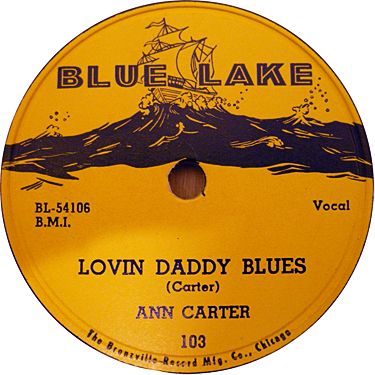
Not long after the Ann Carter session, the Red Saunders Band shed additional personnel. Sonny Cohn declared in his 1963 interview, "I stayed 11 years at the De Lisa with Red and for the last 7 years I was the only trumpet! We ended up as seven pieces" (Vacher, p. 5). This is not quite accurate, as it implies that the band cut back to one trumpet in 1951; the second trumpet player, Fip Ricard, actually left the band in 1954.

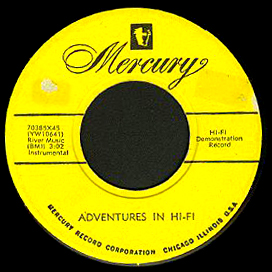
Mike Simpson (ts -1); Dick Marx (p); Chubby Jackson (b); Red Saunders (d).
Mercury Studios, Chicago, June 1954
| YB10641 | Adventures in Hi-Fi (Saunders) | Mercury 70385 | |
| YB10642 | I Got Rhythm (Gershwin-Gershwin) -1 | Mercury 70385 |
Discographies merely give 1954 as the date for this single; interpolation in the Mercury matrix number series indicates that the session took place in June of that year. (In the wax the prefix is YBU instead of YB; on the 45-rpm issue the prefix is YW.)
The band is identified as the Mercury All-Stars on the 78-rpm issue. Mike Simpson is credited on both sides of the 78-rpm issues but is heard only on "I Got Rhythm." The pianist's name was Dick Marx, but on this record, as well as on a Chance release from the previous year, it comes out as "Marks." At the time of the session, Marx had a steady gig at the Lei Aloha, with Johnny Frigo on bass; Lucy Reed was the featured vocalist.
On the 45s that we have seen, there are absolutely no band or musician credits, just the words "Hi-Fi Demonstration Record"! Our thanks to Hubert Stowitschek for providing label shots of the 45.

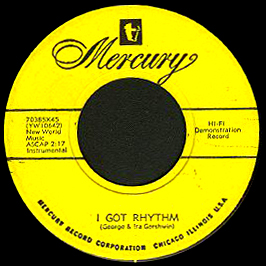
Both sides are showcases for Saunders' drumming; no arrangements here! Red told entertainment writers in Chicago that these sides were two of his "greatest hits."
For his next session, Red returned to work with members of his band. The matrix numbers on the earlier Blue Lake releases are in pretty strict correspondence with the release numbers, affording few clues to the date of recording. However, the Walter Spriggs items from the next session were included in the Parrot/Blue Lake master tapes leased to Chess in 1958 and 1959, and the tape list that has survived gives 2914 as the number on the tape box. Since 2646 was by the Victorettes (recorded August 12, 1954) and 3139 was by Little Willy Foster (recorded January 14, 1955), we can give a rough estimate of the recording date.


Walter Spriggs (voc) with The Five Echoes: Earl Lewis (first tenor); Johnnie Taylor (second tenor); Constant "Count" Sims (baritone); Herbert Lewis (baritone); Jimmy Marshall (bass); Lou Mac (voc); accompanied by Sonny Cohn (tp -2); Leon Washington (ts); McKinley Easton (bars); Earl Washington (p); Ike Perkins (eg -1); Jimmy Richardson (b); Red Saunders (d).
Universal Recording, Chicago, c. October 1954
| BL-54121 | Come Back Little Daddy (McClinton-Call) -1 [LM voc] | Blue Lake 108 | |
| BL-54122 | Hard to Get Along With (McClinton-Call) -1 [LM voc] | Blue Lake 108 | |
| BL-54123 | I'm Not Your Fool Anymore (Spriggs) -2 [WS, FE voc] | Blue Lake 109, Relic 7027 [CD], Relic 7073 [CD] | |
| BL-54124 | Week End Man (Spriggs) -2 [WS, FE voc] | Blue Lake 109, Relic 7073 [CD] |
Blue Lake 108 was a 78 and 45 rpm single released in January 1955; it was reviewed in Billboard on January 15 (p. 61; the reviewer noted that the lyrics to "Come Back Little Daddy" would be considered unsuitable for air play). Blue Lake 109 was a 78 and 45 rpm single released in late February 1955, according to Ferdie Gonzales. Relic 7027 was a CD released in 1992 under the title Rockin' at Midnight at the Parrot Club.
The personnel for the Five Echoes is taken from Pruter's Doowop: The Chicago Scene.
The instrumentalists were identified by ear. Lou Mac, an Al Benson discovery whose fuller name was Lou McClinton, was backed by a lineup of tenor and baritone saxes, piano, guitar, bass, and drums. Leon Washington solos on both of her sides. On the Walter Spriggs sides, Sonny Cohn's trumpet replaces the guitar. For Walter Spriggs' long and complicated career (he's been hard to trace because he used several pseudonyms), see our Chance page—he'd recorded for that label earlier.

Red's band quit recording for Parrot/Blue Lake after the Lou Mac/Walter Spriggs session, though he and some members of his group would return to the label as it was winding down, in December 1955. During 1954 and 1955, Earl and Leon Washington were involved in session work for the Theron label, though we don't know what was cause and what was effect.

By early 1955 the Red Saunders band may contracted to just Sonny Cohn, Riley Hampton, Leon Washington, Mac Easton, and rhythm. However, a second trumpet player does seem to be on the next session. (Riley Hampton told Walter C. Allen [in Hendersonia] that he left Red in 1954, but his date is clearly too early.)
Robert "Billy" Brooks (voc); Red Saunders (d, dir); Sonny Cohn (tp); unidentified (tp); Riley Hampton (as, cl); Leon Washington (ts, cl); McKinley Easton (bars, bcl); Earl Washington (p; celeste on -2); Ike Perkins (eg except -2); Jimmy Richardson (b); prob. Sun Ra (arr -1).
Chicago, February 18, 1955
| ACA3109 | Mambo Is Everywhere (L. L. Lawrence)^ -1 | Duke 142 | |
| ACA3110 | Song of the Dreamer (Eddie "Tex" Curtis)^ | Duke 142 | |
| ACA3111 | Donna (L. Cox-E. Curtis) | Duke 145 | |
| ACA3112 | I Want Your Love Tonight (Eddie "Tex" Curtis)^ -1 | Duke 149 | |
| HHA 21201 | This Is My Prayer (Don D. Robey [sic])^ -2 | Duke 149 |
Here we have three singles (Duke 142, 145, and 149) not listed in Lord, Bruyninckx, or Leadbitter! They are listed in Jepsen's discography; however, Jepsen mentions only Brooks and Saunders in his personnel. Duke 142, and one side from 145 and 149, appear to have come from a 4-tune session with the Red Saunders band. (The flip side of 145 is from a different session with a different band; the flip of 149 includes the Saunders band and may be from the session of February 18, 1955.)

Duke 142 is a 78 and 45-rpm single that released in June 1955. The single was advertised and given a feature review in Cash Box for June 11 (pp. 29 and 33). The label states Houston, Texas, but that's where the Duke/Peacock home office was. The ACA prefix indicated where the sides were mastered—at ACA Studios on Fannin Avenue in downtown Houston. Swiss jazz researcher Kurt Mohr said that Don Robey of Duke Records often supervised sessions in Chicago. Press clippings collected by Robert Pruter show that Billy Brooks was performing at the Club DeLisa in March and April 1954 (duly advertised in the Defender on March 13 and 20 and April 3). On July 10, Brooks was working Club Evergreen with a band led by Red Holloway. Galen Gart and Roy C. Ames, in Duke/Peacock Records: An Illustrated History with Discography (Milford, NH: Big Nickel Publications, p. 78) state that Don Robey flew to Chicago in February 1955 to record Brooks. However, the incomplete chronological list of Brooks sessions (which leaves out his first for Duke/Peacock in 1953) identifies only the session of November 1, 1955 as done in Chicago. Clearly, what they were referring to on page 78 was the session of February 18, 1955.
To nail the date down further, we know (from Gart and Ames, p. 222) that "Mambo Is Everywhere" and "Song of the Dreamer" were mastered for 45 and 78 rpm on March 4, 1955, and remastered on April 11, 1955. An item in Billboard ("Ludlow Music Gets Song of Dreamer," June 11, 1955, p. 26) notes that Tex Curtis had sold the song to Howard S. Richmond, and that it had been recorded for Duke by Billy Brooks and Red Saunders. "Donna" and "I Want Your Love Tonight" were mastered on August 3, 1955.
"Mambo Is Everywhere" has Latin rhythms of the sort favored by Sun Ra. "Song of the Dreamer" is a sentimental country tune of a sort that Ra is not known to have arranged (and while there is a potentially interesting alternation between a clarinet/bass clarinet trio and the standard sax section, the transition is rather gauchely handled). Cash Box liked "Dreamer" and declared (June 11, 1955, p. 33), "It may be that Duke has the star to follow Johnny Ace." Not quite. Gart and Ames (p. 78) state that the record was "only a moderate hit," but that the tune was covered by Johnnie Ray on Columbia and Eddie Fisher on RCA Victor, indicating commercial potential.
A copy of Duke 145 (78 rpm) is in the collection of Armin Büttner. It was probably released in August or September 1955. Side A, "Donna," is credited to Billy Brooks / Red Saunders Orch. "Donna" does not use the clarinets, but it is a sentimental tune related to "Song of the Dreamer" and Sunny's involvement seems unlikely. (The title, according to Gart and Ames, was originally "I Want to Be with Donna.")
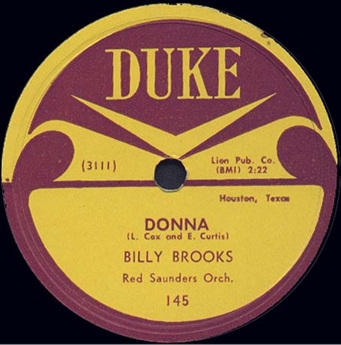
Side B of Duke 145, "I'm Gone," is a fast boogie credited to Billy Brooks and his Orchestra. (The composition is credited to Don Robey, the owner of Duke/ Peacock, an attribution that should be taken with the usual helping of salt.) All indications are that this is a different band, with a solo by a tenor player who is much grittier than Leon Washington. The matrix number is ACA3028, which indicates an earlier session. In fact, Gart and Ames (p. 221) show that "I'm Gone" (which was not mastered till August 17, 1955) did come from an earlier session, presumably one that took place November 23, 1954. The other three titles from this session (ACA3029, "Be My Baby"; ACA3030, "Then I Can Live"; ACA 3031, "From Midnight till Morning") were never released. Alvin Fielder has said that he was drumming on many of Duke's studio sessions in Houston at the time; he may well be on these sides.
A copy of Duke 149 is now in the collection of Armin Büttner. On the evidence of the matrix numbers, ACA3112 ("I Want Your Love Tonight") is from the same session with Red Saunders. The flip side, HHA 21201 ("This Is My Prayer"), would seem from the matrix to be from a different session (not clear which one, but Brooks recorded for Duke on October 28 and November 1, 1955, and did his final session for the label on February 26, 1957). However, both sides of Duke 149 credit the accompaniment to Red Saunder's Band [sic], and the band sounds the same on both sides. (However, there is no guitar on "This Is My Prayer," and the pianist doubles on celeste.) Leon Washington solos on "I Want Your Love," and there are 8 bars for Riley Hampton on "Prayer," while Mac Easton is prominent in the backing on both. "I Want" is a mambo that could have been arranged by Sun Ra.
For now, "This Is My Prayer" is included with the February 18, 1955 session; if it came from a later session, other material including the Red Saunders band ought to materialize.
The personnel were identified by ear, assuming non-catastrophic turnover since the last Joe Williams session. Fip Ricard left the band on November 10, 1954, according to Otto Flückiger's notes, so trumpet #2 must be someone else. Mac Easton recorded with Gene Ammons for Prestige in Hackensack, New Jersey, on November 26, 1954 and February 8, 1955, but is not known to have made any other excursions out of town. (Armin Büttner believes that Mac is present on "Donna," and he would have had time to return to Chicago for this session.)
From remarks by Gart and Ames, it appears that vocalist Carl van Moon also recorded in Chicago on February 18, 1955 for Duke/Peacock. The accompaniment was by Johnny Board's band, however, with arrangements by Johnny Pate.

Red also picked up some session work at the emerging Vee-Jay label in 1955, appearing on two sessions that we know of.
The Rhythm Aces: Billy Steward (1st tenor); Chuck Rowan (2nd tenor); Clyde Rhymes (baritone); Vic House (baritone/bass) prob. accompanied by Sonny Cohn (tp); Fip Ricard (tp); Marty Martinez (tb); Riley Hampton (as); Porter Kilbert (ts); McKinley Easton (bars; also as on -1); Earl Washington (p); Jimmy Richardson (b); Red Saunders (d).
Universal Recording, Chicago, late April 1955
| 55-258 | Whisper to Me (Rowan-House) | Vee-Jay 138, Solid Smoke LP 8030, Famous Groove 971010 [CD], Collectables CD 7204 | |
| 55-259 | Flippety Flop (Rowan-House) | Vee-Jay 160 | |
| 55-260 | Olly, Olly, Atsen, Free (Rowan-House-Carter) | Vee-Jay 138 | |
| 55-261 | That's My Sugar (Rowan) -1 | Vee-Jay 160, Solid Smoke LP 8030 | |
| 55-261 | That's My Sugar (Rowan) [alt.] -1 | Vee-Jay NVD2-715 [CD], Famous Groove 971010 [CD] |
Our basic session information is from Robert Ferlingere's Discography of Rhythm and Blues and Rock 'n Roll Vocal Groups, Volume 2(2nd ed., 1992), with help from the Vee-Jay Master Book. "That's My Sugar" was a remake of a track recorded at the group's previous session, in November 1954 with a different band.
Expectations for the Rhythm Aces' second session were high ("Next one promises to go over the top, [Ewart Abner] says"). They were not met. The standout among the four numbers cut in the studio was "Whisper to Me." "Olly, Olly, Atsen, Free" (as spelled on the label) drew a cover version or two. "Whisper" and "Olly" were coupled on Vee-Jay 138, which was given a rush release on 78 and 45 rpm. The record was advertised in Cash Box on May 14, 1955 (p. 20). "Ab" told Cash Box (May 14, 1955, p. 21) that the Aces were just back in Chicago after a 40 week tour across the country, they had acquired more than 400 fan clubs, and "Olly" had been featured on Jim Lounsbury's TV show on WGN "and received a most favorable reaction." The record got a favorable review from Cash Box as well (May 21, 1955, p. 24).
It turned out Vee-Jay could not sell a jump like "Olly, Olly, Atsen, Free"—or such a sophisticated number as "Whisper to Me."
There are also East Coast 45-rpm "repros" of Vee-Jay 138 in black plastic.
After a second single from the session, the company dropped the group. Vee-Jay 160 was released in November 1955.
Solid Smoke LP 8030, released in 1984, was titled 15 Cool Jewels and consisted of Vee-Jay material by the Magnificents and the Rhythm Aces. Vee-Jay Limited Partnership NVD2-715, A Taste of Doowop Volume 3, was released in 1993. Famous Grove 971010, Vee Jay Doo Wop: A Long Time Ago, Volume 3, was issued in 1997. Collectables CD 7204, Vee-Jay Rhythm & Blues: The Early Years Part One, is a compilation from 2000.
We got our personnel for the Rhythm Aces from Pruter's Doowop: The Chicago Scene. "Whisper to Me" has Stewart and House in the lead; "Olly, Olly" and "Flippety Flop" are led by House, and "That's My Sugar" is a pure group vocal.
The instrumentalists were identified by ear. The band is clearly a Red Saunders aggregation: check out the accompaniment to "That's My Sugar," which mixes bop and swing riffing. Note also the flourish by Red at the end of "Whisper to Me," which has no other instrumental solos—indeed, the horns subtone throughout. "Flippety Flop" has a trombone solo, probably by Marty Martinez. The tenor sax solo on "Olly, Olly" is not by Leon Washington—it sounds like Porter Kilbert on tenor. (This is one of just two Red Saunders band recordings not to include Leon Washington—the other came in 1956 when Paul Bascomb was featured on tenor sax.) "That's My Sugar" has a slightly rough but enthusiastic trumpet solo that combines bop with an Eldridge rasp—Fip Ricard is the obvious suspect, even though he was no longer a regular with Red by this time.
The Rhythm Aces rehearsed with Sun Ra in 1954-1955, and used some of his charts (mostly standards) during their nightclub engagements. There is no sign of Sunny on their recordings, however... Their first session for Vee-Jay was done in November 1954 with a quintet of tenor sax, guitar, piano, bass, and drums. No sign of Red Saunders involvement on that one.
By the time of the next session, Riley Hampton was probably not working with Red at the DeLisa any more. However, he was called upon on occasion for studio work.
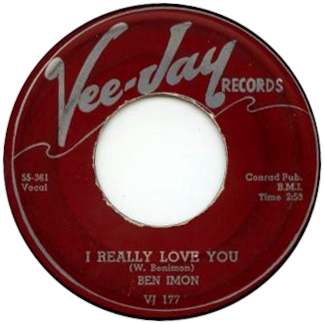
Ben Imon [William Benimon] (voc) accompanied by Riley Hampton (as); McKinley Easton (bars); Earl Washington (p); Lefty Bates (eg); Jimmy Richardson (b); Red Saunders (d).
Universal Recording, Chicago, November 10, 1955
| 55-361 | I Really Love You (Benimon) | Vee-Jay 177 | |
| 55-362 | Down in the Country (Benimon) | Vee Jay 177, Vee-Jay NVD2-718 [CD] |
Our session information comes from the Mohr-Flückiger-Demeusy files. The horn lineup is most unusual for sessions of this type; judging from "Down in the Country," Riley Hampton plays harmonies and stays in the background. "Down in the Country" features a full chorus solo on the AABA tune: Mac Easton takes a long solo on the A sections, giving unusual emphasis to his upper register, and Lefty is entrusted with the bridge. This is a major addition to Mac's solography. MFD also provide confirmation that Jimmy Richardson was still Red's regular bassist at this date.
Vee-Jay 177 was a 78 and 45 rpm single released at the time. Few copies were pressed and it remains extremely rare. Since "Down in the Country" is really a Swing number, sung in a nimble, pop singer's baritone, the session was probably doomed commercially. Bob McGrath's reference volume The R&B Indies mentions it under the singer's real name, William Benimon.
"Down in the Country" was reissued on Vee-Jay NVD2-718, A Taste of the Blues Volume Two. This various-artists collection was issued in 1993, in a series supervised by Billy Vera.
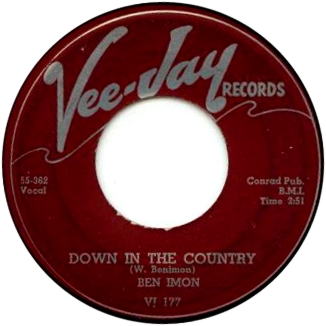

Leon Tarver (voc on *); Lewis "Bill" Ogletree (tp); Oett "Sax" Mallard (as); Cliff Davis (ts); Earl Washington (p); Jimmy Richardson (b); Red Saunders (d); Al Benson (dir).
Universal Recording, Chicago, late December 1955
| BL55-281 | Somebody Help Me* | Blue Lake 118 | |
| BL55-282 | Oh Baby I'm Blue* | Blue Lake 118 | |
| 55-283 | I Know, I Know* | unissued | |
| 55-284 | Tell It like It Is | Parrot 822, Empire Musicwerks CD-N1 | |
| 55-285 | Uptown Stomp | Parrot 822, Empire Musicwerks CD-N1 |
Parrot 822 was a single, sold in both 45 and 78 rpm. It was the last Parrot single to be issued before Al Benson sold the company to John "Lawyer" Burton in March 1956. The exact date of issue is not known but it was after December 1955.
Judging from a list of Parrot tapes that came into the hands of Chess Records in 1958-1959, these sides were cut at the last session to be recorded while Benson still ran Parrot. These sides carry a later tape box number from Universal than the Henry Gray and Jody Williams (Little Papa Joe) sessions of December 8 and 9, 1955.
The tape list also puts three tracks by singer Leon Tarver in the same box with the Benson-Ogletree sides. A listen to Tarver's two released sides, on Blue Lake 118 confirms that the Benson-Ogletree musicians accompanied his soul-blues singing.
The "Benson" on the label is Al Benson, but he does not sing or narrate on either of these sides. Ogletree had fronted a Swing band for Benson during the last days of the New Savoy Ballroom, in the summer of 1948 (see the Old Swing-Master page for more about this), and this session may have been an oblique commemoration of the old band. Lord's Jazz Discography gives no personnel beyond Bill Ogletree and misrenders one title as "Liptown Stomp."
We initially heard the instrumentals from a dub of a 78 in Mike Kredinac's collection. In December 2002, they were reissued on Empire Musicwerks CD-N1, a collection of Parrot/Blue Lake jazz sides titled Jukebox Jazz! From the Southside of Chicago.
We identified the musicians besides Ogletree by ear. Both sides are forthright, bluesy R&B, with strong piano work by Earl Washington. Bill Ogletree solos on both sides, as might be expected from the leader. Sax Mallard solos on both sides as well, and the tenorist has a solo on "Tell It like It Is." We used to think the tenor player was Red's old standby, Leon Washington, but Armin Büttner has convinced us that he doesn't exhibit Leon's tone or phrasing. The pronounced growl that the tenorist employs on "Tell It like It Is" strongly suggests Cliff Davis, who was making a lot of sessions with Al Smith during this period, and may have been brought in for rock and roll flavoring.

Blue Lake 118, consisting of two slow blues sung in an incipient soul style, was released in February 1956. The accompanists are very well recorded; Richardson's bass and Saunders' drums make quite an impact, but there are no solos for anyone and the the three horns stick to R&B riffing with a little Swing thrown in. By the time the record was released, the sale of the label must have been imminent, because the publishing company listed for both of Leon Tarver's tunes is Burton Ltd.
Red Saunders would continue at the Club DeLisa until it folded. As a great wave of rock and roll swept across the music business, the Red Saunders Band was no longer in demand for recording dates, even though some members (Sonny Cohn, Booby Floyd, Leon Washington, Earl Washington, and especially Mac Easton) continued to get studio calls individually. The last Parrot/Blue Lake sessions used studio bands assembled by the record company. However, two sessions by pop vocalist Jean Swan do seem to have used Red's current band (actually beefed up for the studio gig, instead of being slimmed down as had so often been the case in the late 1940s and early 1950s). They were the last to do so.
Jean Swan (voc); with Red Saunders (d, dir); Sonny Cohn (tp); unidentified (tp); prob. Harlan "Booby" Floyd (tb); unidentified (tb); prob. Riley Hampton (as); Leon Washington (ts); Mac Easton (bars); prob. Lonnie Simmons (org -2); prob. Earl Washington (p -1); unidentified (eg); prob. Jimmy Richardson (b); Jack Halloran Singers (voc).
Universal Recording, Chicago, c. January 1956
| YW12761 | What Happens when the Sun Goes Down (Swan) -1 | Mercury 70814 | |
| YW12762 | I'm Not Alone (McNulty-Pollack) -2 | Mercury 70814 |
We got skeletal session information from Michel Ruppli, The Mercury Label. Jean Swan appeared with the Red Saunders band at the Club DeLisa in December 1955 (as per a Chicago Defender ad) and in further shows at the club during 1956. The personnel for Red Saunders' band has been filled in on the assumption that his working band was being employed in the studio for this date (there are no solos or features except very briefly for the organist and pianist; besides, the schmaltzy arrangements would give little indication of anyone's identity). Lonnie Simmons was at the DeLisa from 1950 through April 1956. He filed a contract for 6 weeks at Stelzer's Lounge on May 17, according to the Local 208 contract list; Simmons posted another indefinite contract with that establishment on October 4.
Mercury 70814 was a single released on February 10, 1956. Mercury had an unusual practice, during this period, of putting release dates on the labels to its singles, and that's how we know. We know this single from a 45 rpm release, but it could also have had one on 78 rpm.
Billboard mentioned "Detroit canary Jean Swan" as one of 9 artists recently signed by the label ("Mercury Inks 9 New Artists; Wing Signs 2," February 11, 1956, p. 14). Billboard reviewed the single on March 3 (p. 48). Swan's signing (supposely to a five year contract…) got a slightly delayed announcement in the Chicago Defender (Al Monroe, "So They Say," March 12, 1956, p. 18). She was said to be from Atlanta originally and described as a "blues belter." More accurately, the gossip columnist called her "the eyeful getting the palms at the Club DeLisa."
Jean Swan (voc); Jack Halloran Singers (voc): Red Saunders (d, dir); Jack Halloran (dir); others presumed similar to previous session.
Universal Recording, Chicago, c. March 1956
| YW13059 | Dear Love (Lew Douglas-Gloria Fox) | Mercury 70866 | |
| YW13060 | Forget You Never (Frank McNulty-Bert Pollack) | Mercury 70866 |
Our information is again drawn from Ruppli. Mercury 70866 was a single released, according to the label copy, on April 24, 1956. It was reviewed in Billboard on May 12 (p. 102; the reviewer thought Swan was trying to sound like Joni James). We know this single from a 45 rpm release, but it could also have had one on 78 rpm. We have seen photos of the labels, but have not heard either side of this single.
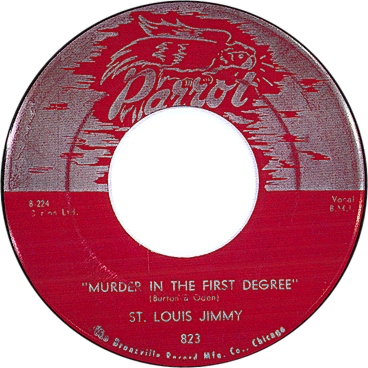
St. Louis Jimmy [James Oden] (voc) with Red Saunders Band: Red Saunders (d, ldr); Sonny Cohn (tp); Riley Hampton (as); Paul Bascomb (ts); McKinley Easton (bars); Earl Washington (p); unidentified (eg); prob. Jimmy Richardson (b).
Chicago, March or April 1956
| B 823 | Going Down Slow (Oden) | Parrot 823, Negro Art [F] M-12-SB-361, Relic LP 8025, Document DOCD-5235 | |
| B 824 | Murder in the First Degree (Burton-Oden) | Parrot 823, Negro Art [F] M-12-SB-361, Relic LP 8025, Document DOCD-5235 |
The details are from Leadbitter and Slaven's Blues Records, p. 304. However, Leadbitter and Slaven give the recording date as 1955. Research into trade magazine advertisements for Parrot, reproduced in the Gart volumes, shows that Parrot 823 was a single (both 78 and 45 rpm) released in June 1956. This release date is three months after Al Benson sold Parrot and Blue Lake to John "Lawyer" Burton! It had been assumed that all Parrots appeared before Benson sold the label, but in fact Burton had a brief fling with active record company managment. (Burton later announced two LP releases of Parrot material on a company called Burtone, but nothing ever came of these). Clearly the B prefix on the matrix number betokens Burtonian origin; all previous Parrot releases had uses different matrix series. (The matrix numbers on the label of this single are B 223 and 224 instead of the B 823 and 824 in the vinyl.)
Parrot 823 was the last single on its label; it was accompanied by a June 1956 Lou Mac release on Blue Lake 119, which was the last on that label. The session is sometimes given a 1955 recording date, but sessions under Benson's direction continued well into December 1955, and the Burtonian matrix numbers suggest that this session was cut after he bought the company.
LS do not specify the horns, saying only that "brass" was present. A check of a copy in Dan Kochakian's collection reveals the presence of trumpet, alto sax, tenor sax, and baritone sax. The only horn solos are by the tenor saxophonist, who gets spots on both sides. We used to think that this was Leon Washington, but Yves Smierciak has contended that the solos sounded like Paul Bascomb's work, and now that we are more familiar with Bascomb's Chicago-period recordings we are inclined to agree. Bascomb had broken up his own larger band at this point, and was appearing with an organ trio at the Esquire Club (which would remain his steady gig until 1971). The guitarist does not sound like either Ike Perkins or Lefty Bates; maybe Bascomb brought him along.
Negro Art M-12-SB-361, Story of the Blues: Chicago Blues 2, was an LP released in France around 1968. Relic LP 8025 was issued in the 1980s (thanks to Dan Kochakian for finding this one). Document DOCD 5235 is a CD issued in 1997 under the title St. Louis Jimmy Oden, Complete Recorded Works Vol 2: 1944-1955. (The Document compilers thought that this session was cut in 1955.)


Lou Mac [Lou McClinton] (voc) with Red Saunders Band: Red Saunders (d, ldr); Sonny Cohn (tp); Riley Hampton (as); Paul Bascomb (ts); McKinley Easton (bars); Earl Washington (p); unidentified (eg); prob. Jimmy Richardson (b).
Chicago, March or April 1956
| B 825 (B-225 on label) | Take Your Trouble to a Friend (Burton-Klein) | Blue Lake 119 | |
| B 826 (B-226 on label) | Move Me (Willie Dixon) | Blue Lake 119 |
Blue Lake 119 was a single issued in June 1956.
These two sides by singer Lou Mac have the same backing as the two by St. Louis Jimmy; they may have been cut at the same session. However, the guitarist sounds different from the guitarist on the St. Louis Jimmy sides.

The demise of Parrot / Blue Lake left Red without a steady record company affiliation in Chicago. He would never have another one, though he appeared occasionally on sessions for another 2 decades.
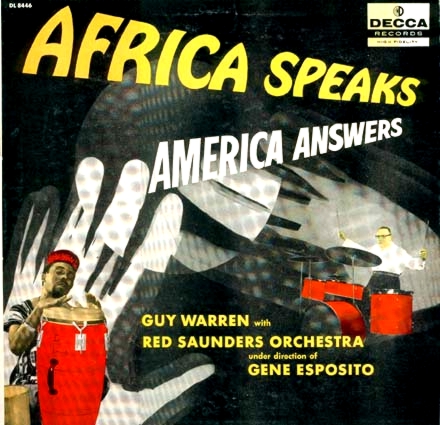
Red did land another recording project. It was an ambitious LP featuring Ghanaian drummer Guy Warren. The results were highly revelatory, as far as Red's drumming went, but the "Red Saunders Orchestra" was actually a group of White studio musicians assembled by multi-instrumentalist Gene Esposito, who'd had a working relationship with Warren for a little while. Most of the Chicago-based musicians remain obscure, but Esposito had a long career on the local scene, as did guest violinist Johnny Frigo. And at the time, Jerry Friedman and Billy Gaeto were seen as up and coming "modernists" (i.e., beboppers).
Africa Speaks—America Answers!
Guy Warren (d, bamboo drums, talking drum, bgo, cga, p innards, voc); Gene Esposito (tp -4, 5, 11; vib -2, 3; p -1, 9; voc); Tony Naponelli (ts -4, 10, 11); Ronnie Colbert (prob. as -3, 4, 7, 8, 10; bars -5); Johnny Lamonica (p -3, 4, 5, 7, 8, 10, 11); Johnny Frigo (vln -2, 8); Jerry Friedman (b except -1, 2, 6); Red Saunders (d, bamboo drums); Bill Gaeto (d, perc); unidentified females (voc -4).
Universal Recording, Chicago, probably September 1956
| 100728 | Africa Speaks (Warren) -1 [GW, ens voc] | Decca DL 8446, Festival FR12-1499 [Aus], Brunswick LAT 8237 [Br], Teichiku JDL-6021 [J], Brunswick [Fr, Gr] 10115EPB | |
| 100737 | Ode to a Stream (Warren) -2 | Decca DL 8446, Festival FR12-1499 [Aus], Brunswick LAT 8237 [Br], Teichiku JDL-6021 [J] | |
| 100732 | Duet [sic] (Warren) [3 drummers only] | Decca DL 8446, Festival FR12-1499 [Aus], Brunswick LAT 8237 [Br], Teichiku JDL-6021 [J], Brunswick [Fr, Gr] 10115EPB | |
| 100736 | Eyi Wala Dong (My Thanks to God) [An African's Prayer (Eyi Wala Dong)*] (Warren) -3 [GW voc] | Decca DL 8446, Decca 30352*, Decca 9-30352*, Festival FR12-1499 [Aus], Brunswick LAT 8237 [Br], Teichiku JDL-6021 [J] | |
| 100735 | Monkies [sic] and Butterflies (Warren) -4 [GW, ens voc; GW, females voc] | Decca DL 8446, Decca 30352, Decca 9-30352, Festival FR12-1499 [Aus], Brunswick LAT 8237 [Br], Teichiku JDL-6021 [J] | |
| 100733 | J.A.I.S.I. (Jazz as I See It) (Warren) -5 [GW, ens voc] | Decca DL 8446, Festival FR12-1499 [Aus], Brunswick LAT 8237 [Br], Teichiku JDL-6021 [J] | |
| 100734 | Invocation of the Horned Viper (Warren) -6 [GW voc] | Decca DL 8446, Festival FR12-1499 [Aus], Brunswick LAT 8237 [Br], Teichiku JDL-6021 [J], Brunswick [Fr, Gr] 10115EPB | |
| 100731 | Chant (Warren) -7 [GW, ens voc] | Decca DL 8446, Festival FR12-1499 [Aus], Brunswick LAT 8237 [Br], Teichiku JDL-6021 [J] | |
| 100738 | My Minuet (Warren) -8 | Decca DL 8446, Festival FR12-1499 [Aus], Brunswick LAT 8237 [Br], Teichiku JDL-6021 [J] | |
| 100729 | The High Life (Warren-Esposito) -9 [GW, GE voc] | Decca DL 8446, Festival FR12-1499 [Aus], Brunswick LAT 8237 [Br], Teichiku JDL-6021 [J], Brunswick [Fr, Gr] 10115EPB | |
| 100739 | The Eyes of a Fawn (Warren) -10 | Decca DL 8446, Festival FR12-1499 [Aus], Brunswick LAT 8237 [Br], Teichiku JDL-6021 [J] | |
| 100730 | Fr-ed-To-ne (Warren) -11 [GW voc] | Decca DL 8446, Festival FR12-1499 [Aus], Brunswick LAT 8237 [Br], Teichiku JDL-6021 [J] |
Guy Warren was a drummer and percussionist from Ghana. He was born on April 4, 1923, in what was then called the Gold Coast. His full name at birth was Kpakpo Kofi Warren Gamaliel Harding Akwei. When he was seven, visiting sailors taught him how to dance the Charleston. In his late teens, he was given a record player and an Artie Shaw 78 by a British army officer. He studied music theory at Achimota College, but quit in 1943 and made his way to New York, when he worked briefly with jazz trombonist Miff Mole. For the next several years, he played in combos in Accra. In 1950, he joined a couple of former bandmates in London, where he worked extensively with British jazz musicians. On returning to West Africa, he took groups to Nigeria and Liberia and became the first DJ in Liberia.
On his second trip to the US, Warren arrived in Chicago in 1954 and was on hand for Charlie Parker's February 1955 gig at the Bee Hive (he appeared in the very last known photo of Bird, and stated in his autobiography that Bird had invited him to make a concert appearance in New York, which of course never happened). Around this time, Warren also made a guest appearance on Allyn Edwards' radio show on WRCA out of New York City ("Vox Jox," Billboard, February 26, 1955, p. 30). Decca DL 8446 was the first in a series of Afro-jazz recordings that Warren would make in the 1950s. Warren was briefly featured with the Duke Ellington band, but largely scuffled (his sporadic gigs are detailed below) during his time in Chicago. Moving to New York City, he made an LP for RCA in 1958, and another one for Decca in 1959. He returned to Ghana in 1959, then traveled to India and Britain in the 1960s. According to Val Wilmer, in 1963 he published an autobiography. He recorded two more LPs for English Columbia (1963 and 1968) and a final LP for Regal Zonophone (1972); the sessions for all three were done in London. Thanks to Gilbert Hsiao for information on Warren's later recordings; the Da Capo Guide to Contemporary African Music calls Guy Warren the "spiritual father of Afro-beat."
In mid-March 1955, at one of Joe Segal's Tuesday night jam sessions (then being held at Roosevelt University), Warren reportedly wowed the crowd and garnered praise from Wilbur Campbell ("African Drummer Score in Session," Los Angeles Sentinel, March 24, 1955, p. A10; the syndicated story was also picked up by the Baltimore Afro-American, March 26, 1955, p. 7). Although Gene Esposito was not quoted in this article, he was a regular participant in Segal's jam sessions. And Esposito obviously caught up with Guy Warren. On November 30, 1955, Gene Esposito and his High Lifers featuring Guy Warren were playing Geno's Dance Lounge at 83rd and Jeffery (Southtown Economist, p. 10). The gig was brief (another band was due into Geno's on December 7). In 1955, there really was nothing like this music being performed anywhere else in the United States; one wonders what Geno's patrons thought of it.
In the early part of 1956 plans for Africa Speaks were already getting talked up: "Bandleader Red Saunders has a killer diller recording session coming up after he and the native African drum sensation, Guy Warren, work out their routine for an album of out-of-this-world hide beating" (Al Monroe, "So They Say," Chicago Defender, March 12, 1956, p. 18). On March 24, Ted Watson's column in the Pittsburgh Courier (p. A 35) claimed that Warren and Saunders were rehearsing daily at the Club DeLisa "preparing tunes from which they will record an album of drum solos." In the end, the numbers that were recorded were not merely drum solos, or drum ensembles, but there was time for further evolution.
Appearing to announce the release of Africa Speaks—which would not be taking place for a few months—another story about it came out in the Defender on September 22, 1956. Wouldn't you know it? The Gene Esposito trio, featuring Guy Warren, was about to open at the Jazz Scene. In fact, Esposito, bassist LeRoy Jackson, and Warren began working the Jazz Scene on September 26. Max Miller had opened the club in July 1955 as Max Miller's Jazz Scene and run it for over a year, with house bands that featured him first on piano, and later on vibes; he had just turned over management of the club and ended his run there. A blurb in the Defender for September 25 ("Ex-Gillespie Star 'Jazz Scene' Opener," p. 15) referred to Warren as a "Decca recording artist." Warren was still at the Jazz Scene three weeks later ("Jazz Star from Africa Shines on Radio Airer," Chicago Defender, October 16, 1956, p. 7).
Probably, then, the recording session had taken place, but since Red had financed it, the deal to put the record out on Decca took some time to finalize. It appears, in any event, that October 10 was the mastering date. Tommi Uschanov (email communication, April 15, 2013) has shown the Decca matrix numbers on the LP (100728-100739) are bracketed on one side by a Jerry Lewis LP (100712-100723, recorded on October 8) and a side by the Four Aces (100724, recorded October 9) and on the other by a single by the Morrison Sisters (100740-100741, October 11) and a single by Merv Griffin (100742-100743, also October 11).
In March 1957, Warren was in New York to participate in an independence day celebration for Ghana (Baker E. Morten, "African Drummer Beats His Way to Music Fame," Chicago Defender, March 2, 1957, p. 5). Decca DL 8446, Africa Speaks—America Answers!, was released in May 1957. A Billboard review of DL 8443 ran on April 20, 1957, and a review of DL 8445 ran on April 27. In its issue of May 16, 1957 (p. 21),Down Beat published a review by Nat Hentoff, who liked everything about the LP but the cover. The review was placed in the Popular Records section, hence the absence of stars in the rating. A month later, Leonard Feather used "Africa Speaks" in a "Blindfold Test" with drummer Osie Johnson ("Osie Can You Say," Down Beat, June 13, 1957, p. 33). Johnson liked the performance but compared it adversely with a record he had just heard by the Haitian drummer Tiroro.
An announcement that actually postdated the LP's release ran on June 13, 1957 (Lee Blackwell, "Off the Record," p. 10). Here the run-up was to a gig that Warren had landed as a member of the Billy Strayhorn Trio, which played the Blue Note July 3 through 7, just before Duke Ellington's big band was due into the club ("Lurlean Hunter, Billy Strayhorn Blue Note's Next," Chicago Defender, June 24, 1957, p. 19). Probably before Warren got back to Chicago for the Strayhorn gig, Red Saunders was at WAAF, promoting "his" new LP to DJ Marty Gaye (Cash Box, June 22, 1957, p. 36); there was no mention of Guy Warren. This was the kind of activity that would eventually turn Warren against him.
We got our personnel and details from the liners to the orginal LP (which include notes by Red himself). The matrix numbers are taken from Tom Lord's Jazz Discography; we've put the tracks in order as they were placed on the LP so we won't have to change the complicated system of numerical tags for the instrumentation. Naponelli's name was spelled "Naponneli" by Decca. Bruyninckx' discography mentions an unidentified alto sax player, and Saunders' liners never give the altoist's name. We note that alto and baritone are never on the same track together and that there is only one appearance by the baritonist, which lends credence to the supposition that Colbert was doubling. An item in the Defender ("The Eddie Baker Trio Scores Hit," June 3, 1957, p. 17) listed this session among recording credits for pianist Eddie Baker, but we have no confirmation that he was present.
Africa Speaks—America Answers! appeared in the USA as Decca DL8446. There were coordinated releases the same year in Britain, Australia, and Japan, giving Red much wider exposure than he'd gotten off the Canadian Columbia issue of "Hambone." The Australian release, on Festival FR12-1499, had a different cover (someone didn't think Red looked African, so the company replaced his photo with a second one of Guy Warren.) The British release, Brunswick LAT 8237, sported a third cover photo, which displayed a bass drum, a tom-tom, three African drums, and one string bass (see http://www.discogs.com/Guy-Warren-with-Red-Saunders-Orchestra-The-Africa-Speaks-America-Answers/release/4250621). The Japanese release, whose cover we cannot report on, was on Teichiku JDL-6021.
Walter Bruyninckx listed Decca 10115 as an LP, but as Tom Lord's entry makes clear, it was a 4-track EP, issued in both France and West Germany. Decca 30352 (the 45s were 9-30352) was a US single released in June 1957, with "Eyi Wala Dong" retitled "An African's Prayer (Eyi Wala Dong)"; Billboard reviewed it on June 10, 1957 (p. 34). The single carries the same matrix numbers we listed above; both production and DJ copies are extant. The LP has not been reissued on CD; we call this a missed opportunity.
Although Red Saunders did not get another chance to record with an African drummer, he would put his experience with Guy Warren to good use, in some of his educational activities during the second half of the 1960s.
From 1970 onwards, Guy Warren spent most of his time in Ghana. In the late 1970s, he changed his name for the second and final time, to Kofi Ghanaba. During his last years, he converted to Buddhism and lived in a village called Midie outside of Accra, performing in public on rare occasions. He also completed a second autobiography, which has yet to see publication. (In it, he complained that Red had ripped him off.) Kofi Ghanaba's last concert took place in Accra in September 2008, and he died on December 22 of that year.
We are grateful to Val Wilmer for her well researched obituary on Guy Warren, published in The Guardian, 7 February 2009, p. 47 (http://www.guardian.co.uk/music/2009/feb/07/obituary-kofi-ghanaba), and for excerpts from Warren's 1963 autobiography. We are indebted to Tommi Uschanov (email communications, April 15 and 16, 2013) for his research on the recording and release of Decca DL 8446, and to Ken Perkins for photos of the cover and labels to the Australian release on Festival FR12-1499.
During the 1950s, Jo Ann Henderson sang regularly at the Club DeLisa. She was Red Saunders' mistress during the 1950s and 1960s, and Red managed her career. Billboard from December 1957 reports: "Wally Phillips' 'Teen Club' show with WGN-TV hosted Joan [sic] Henderson, a sensational new artist with a new label, PHONOGRAPH. With Joan were her manager, Red Saunders, and Paul Gallis and Porky Panico for PHONOGRAPH Records." An item in the Chicago Defender for December 11, 1957 reports on the record, "Baby Please Don't Go" b/w "Leave Me Alone." The accompaniment is credited to trumpeter "'Porkie' Panico and his famous band." Red Saunders is described as a co-partner in the International Artists Inc. Booking Agency, and is quoted as saying that both sides are designed to "make a big noise in record circles." The record is said to have been recently released (and, in Cash Box, December 28, 1957, p. 54, to have been selling). It does not appear, however, that Red played on it. Paul Gallis would be a record promoter for many years after his Phonograph venture; his only recording as a leader came in 1962 for Seymour Schwartz's Heartbeat label.

The Club DeLisa was slipping into its final decline. On January 2, 1957, Mike DeLisa, the oldest of the four DeLisa brothers, died of a heart attack. For several months during the year, the club experimented with using two house bands; the other ensemble was a Latin band led by Juan Soler, "The Mambo King." Soler was eventually dropped. Then on January 1, 1958, Louie DeLisa succumbed to a heart attack. Although James and John DeLisa remained, the club would not recover. From December 27, 1957 through January 2, 1958, the Red Saunders band did the holiday season show at the Regal Theater, with Percy Mayfield, the Ravens, Jackie Wilson, Billy "the Kid" Emerson, Jackie Wilson, the Falcons, the Five Satins, and others. Al Benson was the MC (Cash Box, December 28, 1957, p. 56, courtesy of Dan Kochakian.) The last Club DeLisa advertisement to mention Red and his band—the last Club DeLisa advertisement of any kind, after nearly 24 years—appeared in the Defender on January 25, 1958. The club brought Lonnie Simmons back for January, but to no avail; on January 11 and 18th, Red's name was actually left out of the advertisements, probably by accident, since the nightclub roundups in the Defender still mentioned his name. The club shut down after a final show on February 16, 1958 ("Club DeLisa Up For Sale; Rings Down Curtain Feb. 16," Chicago Defender, February 15, 1958, p. 22).
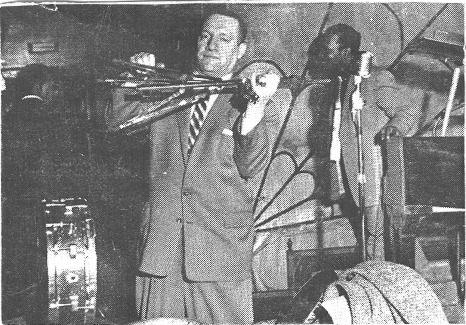
The DeLisa held one last breakfast dance; Lonnie Simmons helped to lower the house lights afterward. The occasion was commemorated in a brief article in Jet magazine:
As Chicago's salon set reveled the morning's wee hours away at a breakfast dance, an era in the South Side's gay night life died. The famed Club DeLisa closed its doors after 25 years. For the most part, the club's 100 entertainers, waitresses, bartenders and other attendants went about last-night business calmly as many patrons flocked to the club on an erroneous report that blues singer-turned-minister Gatemouth Moore would preach the DeLisa's funeral.
The closing meant more to no one than it did to bandleader Red Saunders, who went to work at the DeLisa in 1937. "I haven't had a vacation since 1952," said Red. "I guess I'll take one now."
In its heyday, the DeLisa helped spawn the careers of such entertainers as Billy Eckstine, Joe Williams, Lurlean Hunter, George Kirby and Jo Ann Henderson.
Despite poor business among night clubs generally, the DeLisa closing was described as "a family matter." ("Chicago Night Club Era Ends with Closing of Club DeLisa," Jet, March 6, 1958, pp. 60-61).
After his unplanned vacation, Red picked up a job at one of his old haunts, the Brass Rail in the Loop (indefinite contract filed on March 6, 1958). Soon he found a new home, at what had been the DeLisa's main rival in its last years. On his opening night at Roberts Show Lounge, on July 9, 1958, his band backed Dakota Staton. On October 2, he filed an indefinite contract with the club; on December 18, he filed a contract for another 11 days.
Red continued with Herman Roberts' club into the new year, filing another contract for 2 weeks on January 8, 1959. In April he took an extended gig at Jane's Hideaway (filed on April 2, the contract called for the unusually precise figure of 6 weeks and 2 days). On June 2, he filed a contract for a week at the Tivoli Theater. Thereafter Red took over the house band at the Regal Theater. He would be the bandleader for the majority of the shows at the Regal until early 1967. The Regal (Chicago's counterpart to the Apollo) finally closed its doors in 1968.
Some of Red's musicians would remain with him after the DeLisa shut down. Sonny Cohn left to join Count Basie in March 1960 (he had briefly subbed a few months earlier). Cohn would play first trumpet in the Basie band for more than 30 years, remaining after the leader's death in 1984. He was also the band's road manager for a time. Fip Ricard would be back with Saunders in 1961 and again (after his own briefer stint with Basie) in 1964-1965. Leon Washington took a full-time job with the Musicians Union in 1963, after his and Red's efforts had led to a partial merger of the two segregated Union locals. Leon died on Febuary 19, 1973. Porter Kilbert, after several years as a freelance musician and a moderately successful combo leader, died in Chicago on October 23, 1960; he was only 39. We do not know exactly when Earl Washington left the band. He made a single as a leader for the Chess brothers—Checker 905, featuring two R&B instrumentals, was reviewed in Cash Box on October 22, 1958 (p. 50). He made a series of recordings for the Formal and Jazz Workshop labels in the early 1960s. He performed at the Playboy Club and the Gaslight Club, among other venues. Earl Washington suffered a heart attack and died on June 16, 1975. Walter Cole continued to play bass with Red well into the 1960s. Riley Hampton told Walter C. Allen that he had hung up his alto saxophone in 1957; a more accurate date is 1959. Hampton's focus switched to arranging and directing recording sessions, in which roles he was active at both Vee-Jay and Chess from the late 1950s into the mid-1960s. Mac Easton would continue to be a mainstay with Red for several more years.
Meanwhile, other proven veterans, such as tenor saxophonists Lucius Washington and Neal Green and pianist Prentice McCarey, took jobs with Red when opportunities permitted.
Early in 1960, after more than a decade without Union problems, Red Saunders found himself in front of the Board of Local 208, American Federation of Musicians, and its formidable president, Harry Gray (all references are from the Board minutes for March 17). For two weeks starting February 19, 1960, his band had backed Josephine Baker in a show at the Regal. La Baker demanded strings, which posed a problem since Red didn't usually work with them and Local 208 didn't have a slew of violinists in its membership. Saunders therefore recruited some from Local 10 (i.e., they were White musicians). This distinctly displeased Local 208's leadership.
Red Saunders stated that he had signed a contract with the Regal Theater for 10 musicians, for the Josephine Baker Show, which would be for two weeks, starting February 19th. Not knowing what instrumentation would be required, he used his regular orchestra. Two days before the opening, he learned that Josephine Baker insisted upon 3 violins, 1 accordian [sic], 1 guitar, and a Bongo player. [Alan] Lane was the only 208 member who was available [on violin]. He hired the Local 10 musicians because they had played for Josephine Baker at the Chicago Theater, several years ago. Saunders stated that the best qualified musicians in Local 208, are working on daytime jobs, and cannot arrange to leave them on short notice. He admitted calling Kermit Dudley and Bobby Waugh, but never contacted Leon Abbey, who had called him two or three weeks before the engagement, asking if he would require the services of a violinist. Abbey had informed him that he had played for Miss Baker for many years, and knew exactly what to do for her set.
Saunders was asked why he took seventeen men on the stage for the first performance, and he answered that it was his understanding that Josephine Baker would pay for the extra seven men. It later developed that she would only pay for 3, and he had to dismiss four people; two of them worked two days, and he paid these men out of his own money.
The Board had a long discusssion with Saunders, and made it quite plain to him, that they were displeased with the manner in which he was conducting the business of his orchestra.
The Board instructed the Secretary to write a letter to member Saunders, explaining to him the duties and responsibilities of an orchestra leader.
The Board's displeasure was heightened because of a more recent incident, in which Red and band had agreed to work a 6-day week followed by a 4-day week at Roberts' Show Club accompanying Billy Eckstine—which put them in violation of the five-day week that the Chicago locals had adopted in 1951. The Board was not inclined to treat these as equivalent to two 5-day weeks; the 6-day week, from March 8 through 13, was not allowed without special dispensation from the Board. To make things worse, Red and his band had taken on a special early show on March 13 (at 6 PM) for a club that was using the nightery for their affair. Roberts was told that he would have to hire a different band for such an event, and pay them on the "miscellaneous scale," which would cost more. Roberts was allowed to keep Red and band for the 4-day engagement (March 17 through 20) but told to pay them for 5 days, and to clear all "matinees" at his club through the President's office. And the Board fined Saunders $100 for breaking the "Five-day Week Law," but held the fine in abeyance for 6 months.
Would a bandleader with Red's 23 years of experience—and his level of business acumen—have taken kindly to being called on the carpet, fined, and lectured by the Board of Local 208?
Later in 1960 Red was able to link up with King Kolax for their second recording session together, backing a singer named "Hifi" White. White, then enjoying a long run at McKie's Disc Jockey Lounge, was regularly featured in smaller Chicago clubs during the 1960s. Around 1966 he began to promote concerts and dances.
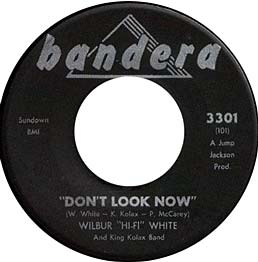
Wilbur "Hifi" White (voc) with King Kolax (tp, ldr); Bill Atkins (as); Johnny Board (ts -1; fl -2); McKinley Easton (bars); Prentice McCarey (p); Walter "Chippy" Cole (b); Red Saunders (d).
Chicago, August 1960
| 101 | Don't Look Now (White-Kolax-McCarey) -1 | Bandera 3301, Wolf 120.297 [CD] | |
| 102 | In the Center of My Heart (White-Kolax-McCarey) -2 | Bandera 3301 |
Bandera was a small label on the South Side of Chicago, run by Vi Muszynski and Bernie Harville; it opened for business in 1958. Bandera 3301 was a 45-rpm single released probably in late 1960. Information about the original release (including the personnel list) is taken the from the Mohr-Flückiger-Demeusy Files. MFD identify the bassist simply as "Chippie"; Walter Cole was Saunders' regular bassist during this period (in 1953, he went as Walt Champion; see above).
There is a prominent flute part on "In the Center of My Heart"; since Johnny Board doubled on flute with Lionel Hampton's big band we've concluded he is responsible. On "Don't Look Now" Johnny Board has a tenor sax solo.
In the 1990s, "Don't Look Now" was reissued on an Austrian CD, Wolf 120.197 [CD], The La Salle Chicago Blues Recordings Volume II. Wolf says that the accompaniment is by a King Kolax band, but gives the date as 1959 and credits Armand "Jump" Jackson with playing the drums. The source of the confusion is that Jump Jackson produced the session for Bandera. Indeed, Wolf gives no release number for "Don't Look Now" on the La Salle label, and the track on the Wolf collection is the exact same one that we know from the Bandera single.
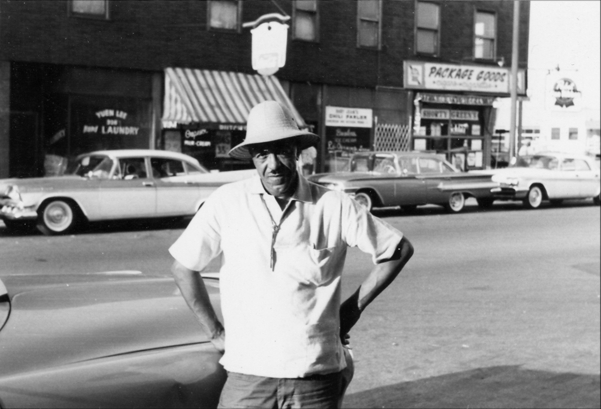
During the Christmas season in 1960, Red put together a large ensemble that, among other things, was hired to play at the inaugural ball for Illinois Governor Otto Kerner (Springfield, January 9, 1961). An item in the Pittsburgh Courier ("Saunders' Band Will Play Governor's Ball," December 24, 1960, p. 24) gave the full personnel: Charles Gray, King Kolax, and Fip Ricard, trumpets; James Harbert and Harlan "Booby" Floyd, trombones; James Spaulding, William Atkins, Leon Washington, and Mac Easton, saxophones; Prentice McCarey, piano; Walter Cole, bass. James Spaulding, who had been working with Sun Ra a couple of years earlier, was probably the youngest member. This particular big band couldn't have stayed together for long, but it set the pattern for the bands that Saunders would continue to lead when he got the booking.
In 1961, Red Saunders began a recorded association with veteran Chicago jazzman Junie C. Cobb, who actually played in his Regal Theater band for a time. Cobb was born in Hot Springs, Arkansas, around 1896. He was leading his own band in Chicago in 1920 and first appeared on record in 1928. Junie Cobb was a true multi-instrumentalist who at various times recorded on clarinet, tenor sax, violin, piano, and banjo; he could also play trumpet and drums. Red had worked with his brother Jimmy Cobb in the early 1930s. The singer on the Golden Rule and Riverside dates, Annabelle Calhoun, was Cobb's girlfriend; he had been her accompanist since the 1930s.
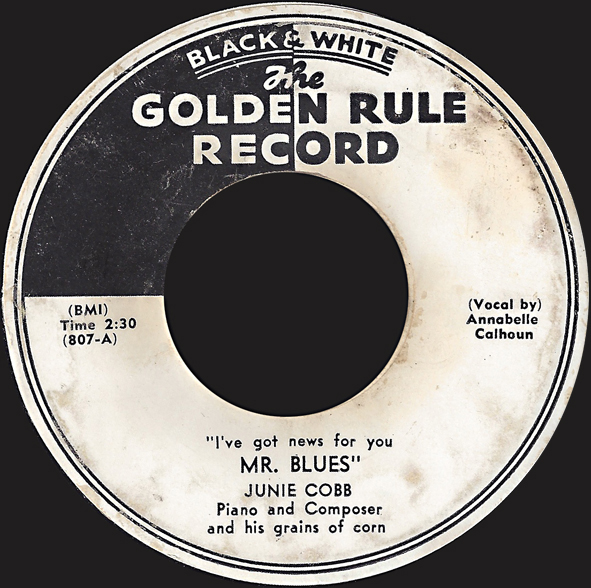
Red's first session with Junie Cobb was done for Cobb's own Golden Rule label. It is extremely obscure; we knew about it only because it was mentioned in a 1961 article about the artist.
Junie C. Cobb (p); unidentified (tp); Leon Washington (ts); unidentified (as); unidentified (eg); unidentified (b); Red Saunders (d); Annabelle Calhoun (voc)
Chicago, c. June 1961
| Triple Trouble (Cobb) | Golden Rule 806 | ||
| unidentified title | Golden Rule 806 | ||
| 807A-R1 234 BRS | I've got news for you Mr. Blues (Cobb) | Golden Rule 807-A | |
| 807B-T5 234 BRS | Just Because of You (Cobb) | Golden Rule 807-B |
This single was mentioned in Björn Englund's article "Introducing Junie Cobb," which ran in Jazz Journal, Volume 14, issue 8 (August 1961). Here's what Englund had to say:
After being out of the studios for some thirty years, Cobb has recently cut a few sides for his own Golden Rule label, with tenor saxist Leon Washington and drummer Red Saunders, among others. Of these Triple Trouble, one of his own compositions, is the most satisfactory, with particularly fine piano playing very reminiscent at times of Jelly Roll Morton*.
The paragraph is footnoted as follows:
*The number of this record is Golden Rule 806, and can be obtained direct from 5353 Indiana Ave, Chicago 15, Ill. We are not sure of the price, but $1.50 should cover it. (p. 7)
In his liners to the Junie Cobb LP that he produced for Riverside, Chris Albertson mentions "...a friend who had just returned from that city brought me a thoroughly obscure 45 rpm single by 'Junie Cobb and His Grains of Corn'." This is a group name that Cobb had used back in 1928 and 1929. Albertson also mentions that Leon Washington soloed on the single. (Our thanks to Yves Fran¸ois Smierciak for alerting us to this information.)
Recently Armin Büttner located a companion single, Golden Rule 807. We're surmising that Cobb did a regulation four-tune session, but we would still like to see both sides of 806— and collectors are always welcome to surprise us with further material. There are BRS marks in the trail-off vinyl to both sides of 807, which may be a clue as to the studio. The studio production isn't the world's greatest: the trumpet and two saxes are both recessed and subjected to annoying reverb, except during the alto sax solo on "I've Got News for You Mr. Blues."
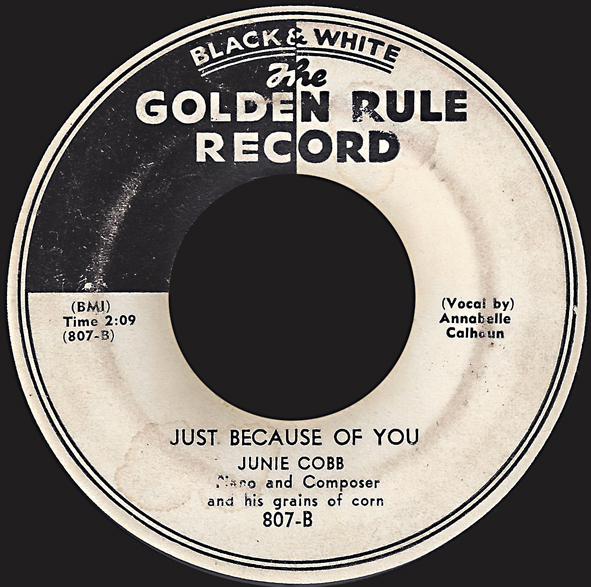
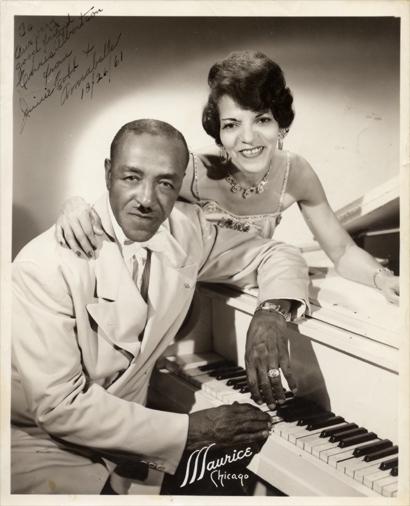
Red went on to make a second session with Junie Cobb that has attained much wider circulation.
Junie Cobb's New Hometown Band
Junie C. Cobb (p, voc); Fip Ricard (tp); Harlan "Booby" Floyd (tb); Leon Washington (cl -1, ts -2); Ikey Robinson (bj); Walter "Chippy" Cole (b); Red Saunders (d); Annabelle Calhoun (voc).
Chicago, September 8, 1961
| 376 | I'm Gonna Have You [AC voc] -1, 2 | Riverside RLP415, OJCCD 1825 | |
| 377 | Just because of You (Cobb) [JC, AC voc] -2 | Riverside RLP415, OJCCD 1825 | |
| 378 | Be Mine -1 | Riverside RLP415, OJCCD 1825 | |
| 379 | Once or Twice -1 | Riverside RLP415, OJCCD 1825 | |
| 380 | Belligerent Blues [AC voc] -2 | Riverside RLP415, OJCCD 1825 | |
| 381 | Mister Blues (Cobb) -2 | Riverside RLP415, OJCCD 1825 | |
| 382 | Swing Your Hurdy Gurdy -1, 2 | Riverside RLP415, OJCCD 1825 | |
| 383 | Just Squeeze Me [AC voc] -1 | Riverside RLP415, OJCCD 1825 |
Fip Ricard accurately described the lineup and the circumstances in his 1964 interview (he was a last-minute replacement for Bill Martin, who was playing in Dixieland bands at that point in his career). Ricard, Floyd, Leon Washington, and Cole were all regulars in Saunders' band at the Regal Theater when this session was cut. Floyd would leave in 1966 to join Count Basie.
Our basic session information comes from Lord. Riverside RLP 415 was an LP released in 1962; there was a stereo release that same year as RS9415, according to the Goldmine Guide to Collectable Jazz Records, 2nd edition. There is a 1990s CD reissue in the Original Jazz Classics series, OJCCD 1825. Lord's personnel list refers to "Fortunatus Richard" on trumpet and "Harlem Floyd" on trombone (Riverside has "Harlen"); Lord is also unsure whether the bassist was named Walter Cole or Walter Hill. In fact, Walter Cole (who sometimes went as Walt Champion—are you confused yet?) began working with Red in 1953 and became Red's regular bassist after Jimmy Richardson left the band. The clarinet and tenor sax credits for Leon Washington (who, along with Cobb, is the dominant soloist on the date) were done by ear. It is worth noting that Red Saunders took drum breaks on "Swing Your Hurdy Gurdy," "Once or Twice," and "Just because of You"; these are his last known drum solos on record (though he did get a drum break on his TV show from 1974).
Reflecting on the Cobb session, which was part of a "Living Legends" series for Riverside, Chris Albertson comments, "I wish I had done a Saunders session as well" (email, January 12, 2005).
In 1962, Junie Cobb joined a Dixieland band led by veteran drummer Jasper Taylor. He died in obscurity around 1970.
It would be hard to document all the Regal Theater shows that Red and his band worked. Here is just a taste. The Recordland All-Stars of 1963, a review that ran from January 18 to 25, 1963, included Jerry Butler, Dee Clark, Gladys Knight, The Crystals, the Isley Brothers, Jimmy McGriff and his trio, Redd Foxx, and, of course the Red Saunders Ork (Cash Box, February 2, 1963, p. 18). We know the ticket buyers got their money's worth.
On March 20, 1963, while still working the Regal, Saunders led a successful campaign to get black musicians admitted to the all-white Musicians Union Local 10 in Chicago. For a detailed history of the struggle to integrate the Musicians Union in Chicago, see the late Charles Walton's history in Bronzeville Conversations. While Red and his supporters wanted to do their part for the Civil Rights movement, it is clear that they also wanted to get out from under the autocratic regime of Harry Gray, who had controlled Local 208 since 1937.
Here is Red's account, from his interview with Art Hodes in 1967:
In November of '62 [we formed] the Chicago Musicians for Harmonious Integration. We met right here in my basement. There were 12 of us. I'm not going to mention any names. But when Barney Richards was elected president of Local 10 [the White union], that broke the power structure. It relieved the tension. But we were organizing all the time. On March 20, '63, we had decided we would force membership into Local 10. On that date, 150 of our musicians [from the old segregated Black Local 208] went down to Local 10 to test membership, and they accepted us. Richards accepted us. No one had been informed; even the national union was caught off guard. Barney Richards used his own judgment.
Today? Close to 2,000 of our musicians are in there now. Barney Richards saw there would be problems that he'd need help on; he saw the need for assistance. He appointed me. And Leon Washington became a business agent. The merger didn't come about easy. There was much wrangling and mudslinging. Local 208 didn't want to merge; it meant a loss of identity, property, income, money. The wrangling was both on the local and national level. But the merger finally came about—officially—in [January] 1966. (p. 40)
While the multi-year contention between the two union locals was going on, Red landed an opportunity to do another blues session in the studio, for the USA label. By this time saxophonist Neal Green was working regularly with Red. Trumpeter Billy Brimfield is best known to jazz fans as the usual front-line partner of an avant-grade tenor saxophonist, the late Fred Anderson.

Willie Mabon (voc, p); with Red Saunders Band: Red Saunders (d, ldr); William Brimfield (tp); John Watson (tb); Neal Green (ts); unidentified (eg); unidentified (b).
Chicago, October 29, 1964
| 862 | Lonesome Blue Water (M. Neal) | USA 787*, America [Fr] AM 6136 | |
| 863 | Some Time I Wonder (M. Neal) | USA 787*, America [Fr] AM 6136, P-Vine Special [J] PLP-9017, Flyright [Br] FLY 580 | |
| RK3M-6368 | Something for Nothing | USA 805, P-Vine Special [J] PLP-9017, Flyright [Br] FLY 580 | |
| RK3M-6373 | Baby Sweets | USA 805, P-Vine Special [J] PLP-9017, Flyright [Br] FLY 580 |
USA 787 was a 45-rpm single, probably released around the end of 1964. The labels on USA 787 give Willie Mabon's name only. Al Perkins is listed as the producer on USA 787. "Some Time I Wonder" [sic] is still another sequel to "I Don't Know."
USA 805 was a 45-rpm single released in 1965, judging from the R-series matrix numbers, which indicate that pressing was handled by RCA Victor. USA 805 may have credited the Red Saunders Band, as mentioned by Leadbitter, Fancourt, and Pelletier; this is still to be researched.
Our basic source is Leadbitter, Fancourt, and Pelletier, Blues Records 1943-1970: L-Z (published 1994). LFP spell Green's first name as "Neil."
America AM 6136 was released in France in 1974; the title on this LP was Willie Mabon: Chicago 1963. P-Vine Special PLP-9017 was released in Japan in 1980 under the title Willie Mabon: I'm the Fixer. Its cognate, Flyright FLY 580, same track lineup and title, was released in Britain in 1981. Neither of these compilations saw fit to include "Lonesome Blue Water." The Flyright notes refer to "? Broomfield" as the trumpet player and Al Duncan as the drummer. See Stefan Wirz's Flyright discography, to which we are indebted for information about the America reissue, at http://www.wirz.de/music/flyrifrm.htm.

After his gig at the Regal ended, Red spent several months in 1967 putting on the "Evolution of Jazz" shows in the Chicago public schools: these included African drumming by Roger McCall, spirituals by the Hutchinson family, blues singing and guitar playing by Bobby King, piano by Lil Hardin Armstrong, demonstrations of Dixieland with Art Hodes on piano, big band music, and "avant garde" (well, by Red's standards) with tenor saxophonist Vernice "Bunky" Green. 23 performers were involved and the show was done at 12 different high schools. At this point in his career, Red was moving toward directing and conducting, often leaving the drumming to others.
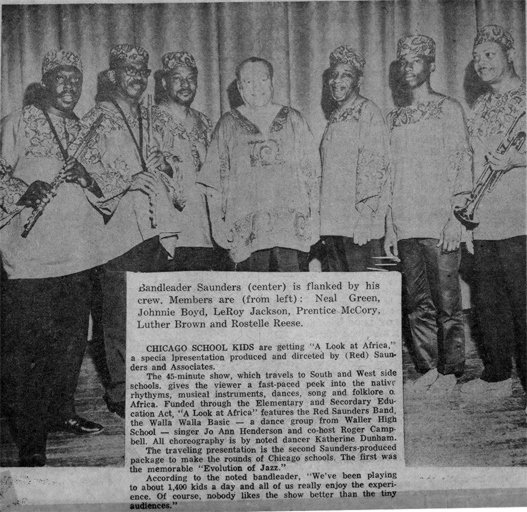
In the Fall of 1968, Red put together a smaller ensemble which presented a 45-minute show called "A Look at Africa" in schools on the South and West sides of Chicago. A dance group from Waller High School appeared with them (to choreography by Katherine Dunham), along with vocalist Jo Ann Henderson. Besides Red, who got to put his experience with Guy Warren to good use, the band consisted of Rostelle Reese (trumpet); Cornelius Lee "Neal" Green (saxes and flute); Johnnie Boyd (saxes and flute); Prentice McCarey (piano); LeRoy Jackson (bass); and Luther Brown (prob. percussion).
Red also worked with traditional jazz pianist Art Hodes in 1968 (including a performance at the New Orleans Jazz Festival).
Subsequently, Red Saunders went into business as a booking agent, though he continued to lead big bands when demand warranted (as in an outdoor concert in Summer 1973 that was covered in the Chicago Defender, and on a 1974 TV show that has been preserved). Red often hired other drummers for these gigs, and adapted to conditions by using electric bass and electronic keyboards.
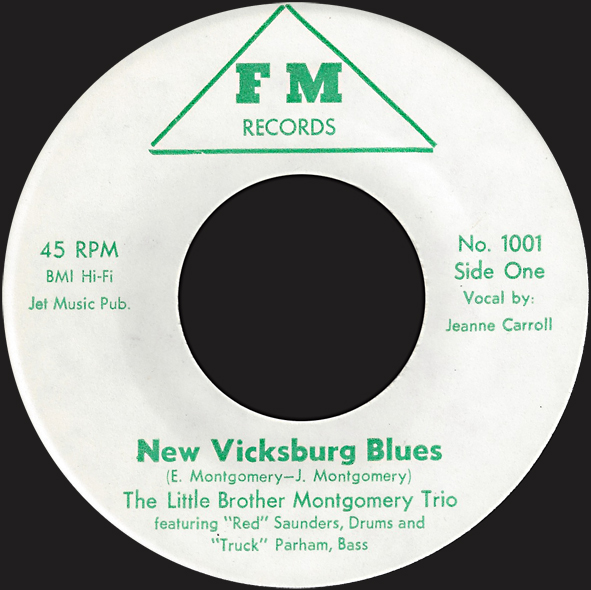
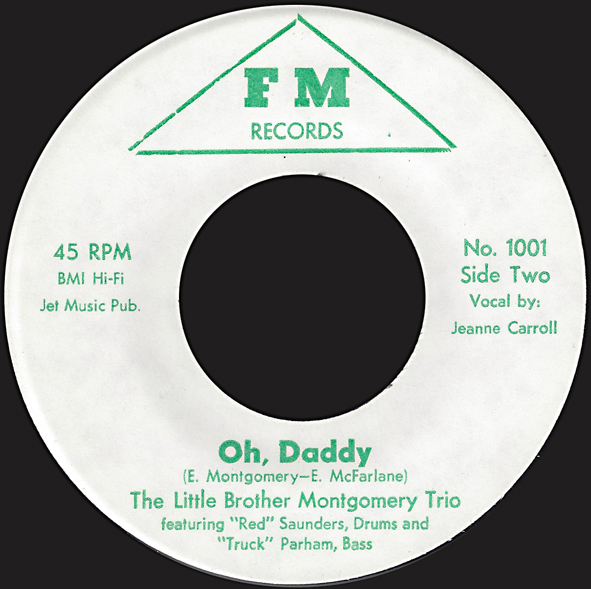
Red's final studio sessions stem from a long affiliation with blues pianist Eurreal "Little Brother" Montgomery.
Eurreal "Little Brother" Montgomery (voc on *, p except *); Duke Montgomery (p on *); Charles "Truck" Parham (b); Red Saunders (d); Jeanne Carroll (voc on %).
Chicago, December 6, 1968
| FM1001 Side One | New Vicksburg Blues (E. Montgomery - J. Montgomery) % | FM Records 1001, Matchbox SDR213 | |
| FM1001 Side Two | Oh Daddy (E. Montgomery - E. McFarlane) % | FM Records 1001, Matchbox SDR213 | |
| FM1002 Side One | Mini Skirt Blues (E. Montgomery)* | FM Records 1002, Earwig LP4918, Earwig CD4918 | |
| FM1002 Side Two | Brother Red's Boogie (E. Montgomery) | FM Records 1002, Matchbox SDR213, Earwig LP4918, Earwig CD4918 |
FM was a record label operated by Little Brother Montgomery and his wife. FM Records 1001 and 1002 were 45-rpm singles released at the time. Matchox SDR213 was a British LP. Earwig LP4918 and CD4918 are titled Little Brother Montgomery: At Home.
Our basic information is from Lord, who duplicates the first two items in his Jeanne Carroll and Little Brother Montgomery listings. The label copy is from records in Armin Büttner's collection. The FM label is covered in the All Music Guide to the Blues.
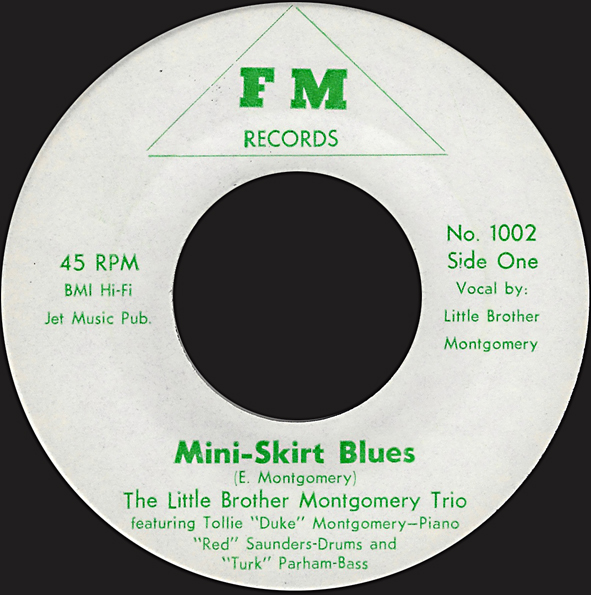
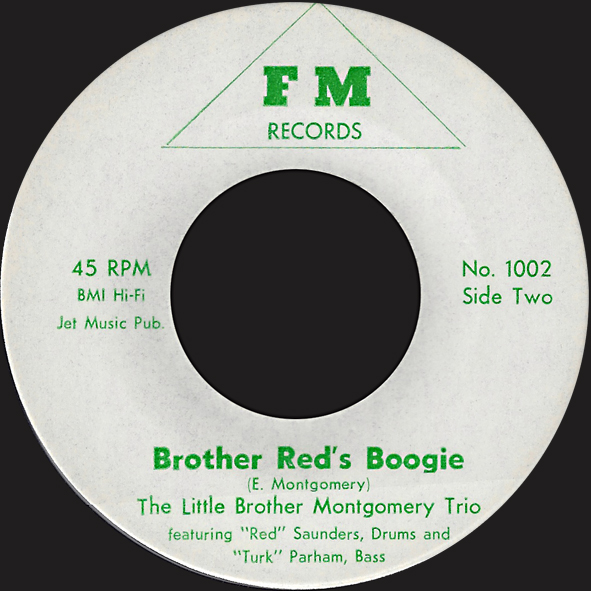
According to jazz impresario Joe Segal (in his notes to the 1972 collection, Southside Jazz on Chess CHV-415): "Red is still very active in Chicago and in addition to playing social affairs and dances has been touring Chicago's schools demonstrating a comprehensive history of Jazz Music." After Leon Washington's death, Red often used tenor saxophonist Eddie Johnson in his big band. Such recording gigs as came Red's way, however, did not call for a large aggregation.
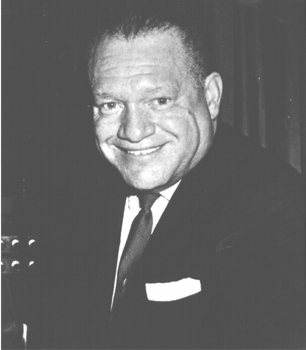
Edith Wilson (voc); Leon Scott (tp); Preston Jackson (tb); Franz Jackson (cl -1; ts -2); Little Brother Montgomery (p, voc); Ikey Robinson (bj -3, 4-string g); Charles "Truck" Parham (b); Red Saunders (d).
Sound Studios, Chicago, July 5, 1973
| Easin' away from Me -1, 3 | Delmark DS-637, DD-637 [CD] | ||
| That Same Dog -1 [LBM, EW voc] | Delmark DS-637, DD-637 [CD] | ||
| Hey! Hey! Boogie -2, 3 | Delmark DS-637, DD-637 [CD] | ||
| My Handy Man Ain't Handy No More -1 | Delmark DS-637, DD-637 [CD] | ||
| Lonesome -2 | Delmark DS-637, DD-637 [CD] | ||
| Twiddlin' -1, 3 | Delmark DS-637, DD-637 [CD] |
Delmark DS637, He May Be Your Man... But He Comes to See Me Sometimes! was an LP issued in 1976. It was reissued on CD in 1993. Information from the liner notes to the CD.
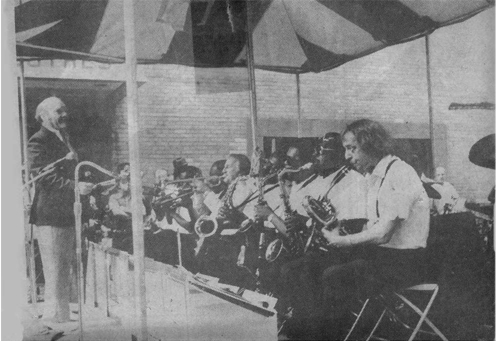
In August of 1973, Red Saunders led a 15-piece band (including singer Jo Ann Henderson) that performed "noon-hour" concerts at Quincy Court in downtown Chicago. A couple of photos ran in the Chicago Defender on August 25.
Edith Wilson (voc); Leon Scott (tp); Preston Jackson (tb, voc); Oliver Alcorn (cl); Little Brother Montgomery (p, voc); Ikey Robinson (bj -1, 4-string g); Charles "Truck" Parham (b); Red Saunders (d).
Sound Studios, Chicago, September 3, 1973
| Poppa-Mama Blues [EW voc] | Delmark DS-637, DD-637 [CD] | ||
| Put a Little Love in Everything You Do [EW voc] | Delmark DS-637, DD-637 [CD] | ||
| I Must Get Mine in Front [LBM voc] | Delmark DE-663 [CD] | ||
| Old Maid Blues [LBM voc] | Delmark DE-663 [CD] | ||
| Glitsy's Blues | Delmark DE-663 [CD] | ||
| Wailing Blues -1 | Delmark DE-663 [CD] | ||
| Goodbye Mr. Blues [alt.; PJ voc] | Delmark DE-663 [CD] |
Delmark DS637, He May Be Your Man... But He Comes to See Me Sometimes! was an LP issued in 1976. It was reissued on CD in 1993. Delmark DE663, Goodbye Mister Blues by Little Brother Montgomery, was recorded at the same series of sessions as the Edith Wilson numbers, but was not released till 1993. Information from the liner notes to the CDs.
A recent discovery provides the first documentation of a Red Saunders big band after the Regal Theater closed down. On a 1974 television show Red and band backed two well-known soul artists.
George Kirby (voc); Della Reese (voc -3); Jackie Wilson (voc -1); with Red Saunders' Band: Red Saunders (d -2, 3; ldr); 2 unidentified tps except -3; 2 unidentified tbs except -3; unidentified (as) except -3; unidentified (ts) except -3; unidentified (as, bars) except -3; unidentified (p); unidentified (eg -1); unidentified (eb); unidentified (d -1); unidentified (cga).
Soundstage TV show, WTTW, Chicago, 1974
| Theme -2 | TV show | ||
| I'm a Happy-Go-Lucky Square [GK voc] -2 | — | ||
| Eep-Ipe, I Want a Piece of Pie [GK voc, unaccompanied] | — | ||
| (Your Love Keeps Lifting Me) Higher and Higher [JW voc] -1 | — | ||
| I Want the World to Know [JW voc] -1 | — | ||
| I'll Be Satisfied [JW voc] -1 | — | ||
| Lonely Teardrops [JW voc] -1 | — | ||
| Cottontail (Ellington) | — | ||
| Lady Be Good (Gershwin) [GK voc] | — | ||
| Mack the Knife (Brecht-Weill-Blitzstein) [GK, ens voc] | — | ||
| Cottontail (Ellington) | — | ||
| Good Morning Blues [DR voc] -3 | — | ||
| That Reminds Me of You [DR voc] -3 | — | ||
| In the Still of the Night (Porter) [DR voc] -3 | — | ||
| One for My Baby (and One for the Road) (Mercer) [DR voc] -3 | — | ||
| September in the Rain [DR voc] -3 | — | ||
| Every Day I Have the Blues [DR, JW, GK voc] -2 | — |
A video of this TV show is in the collection of Mike Kredinac. This Soundstageepisode is a 60-minute TV show produced in 1974 for Public Broadcasting System stations by WTTW, Chicago. The show tries to recreate the atmosphere during the Summer of 1958 at Club Paradise in Idlewild Beach, Michigan, a beach resort that catered to Black vacationers in the era of segregation (the "club," complete with middle-aged patrons sitting at tables, is obviously a set in the TV studio). Both Jackie Wilson and Della Reese performed at the club, which was operated by Arthur "Daddy" Braggs, early in their careers; Della Reese recorded her first session (for United) after being "discovered" there. Red Saunders didn't play at Club Paradise, but his band backed Jackie Wilson at the Regal Theater at the beginning of 1958 (see above), and he had worked with Della Reese on multiple occasions George Kirby, who serves as MC, was a comic who broke in at the Club DeLisa in the late 1940s; he had performed with Red on countless occasions.
Only the musical portions of the show are listed above. The show opens with a monologue by George Kirby. Red comes out (he has no speaking role in the show) and leads the band in a brief theme. George Kirby does some brief singing ("Eep, Ipe" is completely unaccompanied), including vocal trombone and string bass imitations. (Though an excellent vocalist, George Kirby got few few opportunities to sing on record. He can be heard on "Legs Keep Getting Bigger" with Red's band from 1949, and on "Ice Man Blues" with Tom Archia on 1947.) Kirby concludes with some vigorous dancing ("Look at that fat man twist!") and a bit of stand-up comedy.
Jackie Wilson is introduced; during his set his guitar player directs the band, his drummer (much younger than Red) is at the traps, and Red is off-stage. Wilson's clothing (velvet bell-bottoms and platform shoes) could never be mistaken for 1958 attire. After Jackie's energetic set, which includes some nice plunger-muted trombone on "That's All I Need," George Kirby interviews him backstage, along with "Daddy" Braggs. Portions of the Red Saunders band instrumental, "Cottontail," including piano and drum solos, are heard in the background as they talk.
Kirby does more comedy. He throws in a passable imitation of Ella Fitzgerald (!) singing "Lady Be Good" (accompanied by p, eb, and d), and follows this with an impression of Louis Armstrong doing "Mack the Knife" with the band. He concludes "Mack" with an imitation trumpet solo while the band shouts, "Higher! Higher!" Red Saunders is introduced and more of "Cottontail," including a tenor sax solo and a piano solo, is heard in the background while Kirby talks to Della Reese backstage. Della Reese sings a set accompanied by piano, electric bass, and Red's drums; the rest of the band sit with their instruments. Red gets a nice drum break on "September in the Rain." The show closes as George Kirby, Jackie Wilson, and Della Reese do some impromptu blues singing that Reese turns into "Every Day I Have the Blues." There are alto and tenor sax solos during this number, and a blues riff continues under the credits.
Most of the band members are not clearly visible for very long during the video. Red's band uses what had become his standard lineup of 4 brass and 3 saxes, and the choice of "Cottontail" suggests that Eddie Johnson may have been present on tenor sax, but this remains to be confirmed, and the rest of the musicians need to be identified (none of them are mentioned in the credits).
Edith Wilson (voc); LeRoi Nabors (tp); Preston Jackson (tb); Oliver Alcorn (cl); Little Brother Montgomery (p); Ikey Robinson (bj -1, 4-string g); Ed Wilkinson (b); Red Saunders (d).
Sound Studios, Chicago, April 16, 1975
| Mistreatin' Blues [EW voc] -1 | Delmark DS-637, DD-637 [CD] | ||
| Hesitating Blues [EW voc] | Delmark DS-637, DD-637 [CD] | ||
| He May Be Your Man [EW voc] | Delmark DS-637, DD-637 [CD] | ||
| Slow Creepin' Blues [EW voc] | Delmark DS-637, DD-637 [CD] | ||
| Riverside Blues | Delmark DE-663 [CD] |
Delmark DS637, He May Be Your Man... But He Comes to See Me Sometimes! was an LP issued in 1976. It was reissued on CD in 1993. Delmark DE663, Goodbye Mister Blues by Little Brother Montgomery, was recorded at the same series of sessions as the Edith Wilson numbers, but was not released till 1993. Information from the liner notes to the CDs. The liners to the Little Brother Montgomery CD incorrectly list the clarinetist for this session as Franz Jackson, and list Oliver Alcorn as playing soprano and tenor sax.
Little Brother Montgomery (p, voc); LeRoi Nabors (tp); Preston Jackson (tb, voc); Franz Jackson (cl -1; ss -2; ts-3); Ikey Robinson (4-string g); Truck Parham (b); Red Saunders (d).
Sound Studios, Chicago, January 7, 1976
| Goodbye Mr. Blues [PJ voc] -1 | Delmark DE-663 [CD] | ||
| South Rampart St. Parade -1 | Delmark DE-663 [CD] | ||
| Tishomingo Blues [LBM voc] -2 | Delmark DE-663 [CD] | ||
| Struttin' with Some Barbecue -1 | Delmark DE-663 [CD] | ||
| Boy in the Boat -3 | Delmark DE-663 [CD] | ||
| Saturday Night Function -1 | Delmark DE-663 [CD] | ||
| Panama Rag -1 | Delmark DE-663 [CD] |
Delmark DE663, Goodbye Mister Blues by Little Brother Montgomery's State Street Swingers, is a CD released in 1993. Information from the liner notes.
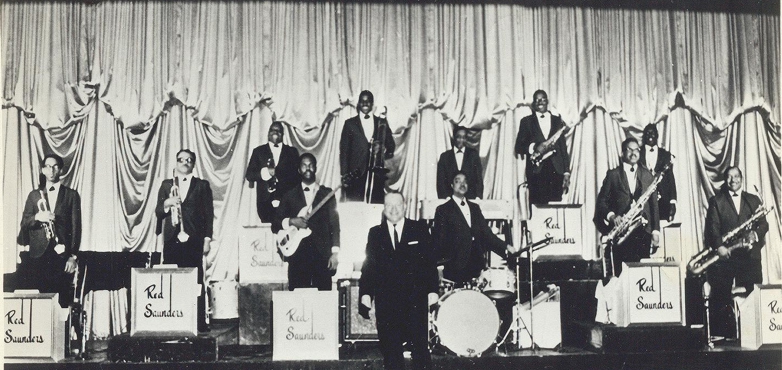
Red Saunders continued to work right up until his death on March 4, 1981; his death certificate listed the causes as acute cardiopulmonary arrest, congestive heart failure, and diabetes. (At the time of his death, he had two scheduled engagements, which were filled by his son, Red Jr.)
Mac Easton outlived Red by a few years; he died in Chicago on May 1, 1986 after being retired from music for some time (his death certificate lists his occupation as "retired laborer"). Booby Floyd died in 1987. Jimmy Richardson died on May 3, 1988 in Denver; before retiring, he had spent his later years working as a janitor for the Chicago Public Schools. Johnny Avant died in Chicago on September 6, 1988. Fip Ricard played in Sammy Davis, Jr.'s band from 1966 until the singer's retirement in 1989, directing the band at the Chicago Theater during Davis's last appearance in the Windy City. In his last years, he taught at Eubanks School of Music in Los Angeles. He died of a heart attack on April 26, 1996 ("Sammy Davis Jr.: 1925-1990," Los Angeles Sentinel, May 24, 1990, p. A1; "'Fip' Ricard," Los Angeles Sentinel, July 11, 1996, p. A18). Joe Williams, who continued to sing and record till the end, died in Las Vegas on March 29, 1999, at the age of 80. Sonny Cohn retired from the Count Basie band in the early 1990s, but remained active around Chicago in the Morris Ellis band and Von Freeman's combo. In 1996, he recorded on a Delmark date led by Jodie Christian; joining him in the front line was Eddie Johnson. He made his last appearance on a recording in 2004 and died in Chicago on November 7, 2006.
The following are items that some discographies have misattributed to Red Saunders. He has been confused with two other drummers, Albert G. Saunders and Charles "Chick" Saunders, both of whom were active in Chicago in the late 1940s. Chick's last name is sometimes given as "Sanders." He was also mixed up with a very different drummer, Connie Kay, because of longstanding confusion over remakes in the Atlantic Records discography.
Lil Green (voc); Howard Callender (tp, ldr); Alonzo A. Fox (tp); Frederick Neely (tp); Julius E. Brooks (tp); Benjamin Stroud (tp); James Whitney (tb); Henry L. Stratham (tb); Stanford A. Grier (tb); Richard H. Fox (as); Richard J. Overton (as); Elmer "Tone" Williams (ts); Howard A. Robertson (ts); Vincent J. McCleary (bars); Jimmy Nelson (p); Walter Johnson (b); Albert G. Saunders (d); Morey Feld (d).
RCA Studios, Chicago, July 23, 1946
| D6VB2521 | It's So Bad with My Man and Me | Victor 20-1957 | |
| D6VB2522-1 | Blowtop Blues | Victor 20-1957, LPV 574 |
This Lil Green session included a drummer identified as "Red" Saunders in some sources. However, Lord gives his full name as Albert G. Saunders, which would be a different musician—then gives "Red" as his nickname. The band is definitely not Red's; it does not include anyone who is known to have worked with him.
Victor 20-1957 was a 78 rpm single released at the time. Victor LPV 574 was an LP, released in the early 1970s, titled Romance in the Dark.
Lil Green (voc); Howard Callender (tp, ldr); Richard Fox (as); Richard Overton (as); Elmer "Tone" Williams (ts); Jimmy Nelson (p); Walter Johnson (b); Albert G. Saunders (d).
RCA Studios, Chicago, July 31, 1946
| D6VB2557 | How Come You Do Me like You Do? | Victor 20-2214, Rosetta LP 1310 | |
| D6VB2558 | That Old Feeling | Victor 20-2102, Rosetta LP 1310 | |
| D6VB2559 | Last Go Round Blues | Victor 20-2102 | |
| D6VB2560 | No Good Man | Victor 20-2214 |
Again, the drummer on this session is listed as Red Saunders in some sources. Lord hedges by calling him Albert G. "Red" Saunders. Victor 20-2102 and 20-2214 were 78 rpm singles released in the late 1940s. Rosetta LP 1310 is an LP from the early 1980s titled Lil Green 1940-1947.
Walter Davis (p, voc); Leonard "Baby Doo" Caston (eg); Charles Saunders (d).
RCA Studios, Chicago, February 12, 1946
| D7VB0304 | Things Ain't What They Used to Be | Victor 20-2335 | |
| D7VB0305 | Oh Me Oh My Blues | Victor 20-2487 | |
| D7VB0306 | Just One More Time | Victor 20-2335 | |
| D7VB0307 | It's Been So Long | Victor 20-2487 |
Jepsen's Jazz Records lists the drummer as Red Saunders. Leadbitter and Slaven's Blues Records 1943-1966 give the date and identify the drummer as Charles Saunders. This same Charles "Chick" Saunders (sometimes spelled "Sanders") made some other blues sessions for Victor around this time, a session for Columbia (with Willie "Long Time" Smith) on June 13, 1947, and at least one more session for Columbia with Rosetta Howard and the Big Three. Jepsen jumped to conclusions.
The final spurious attribution arose from mixups in the discography of Big Joe Turner's Atlantic recordings.
Joe Turner (voc); Jesse Stone (p, dir); unidentified (tp); unidentified (as); Big Al Sears (ts); unidentified (bars); unidentified (eg); unidentified (b); Connie Kay (d).
New York City, January 28, 1955
| A-1424 | Morning, Noon, and Night | Atlantic 1080, LP 8023, Charly 1070, Atlantic 81663 [LP and CD], Rhino/Atlantic 71550 [CD] | |
| A-1425 | Ti-ri-lee [?] | unissued [?] | |
| A-1426 | Hide and Seek [JT, ens voc] | Atlantic 1069, EP 586, LP 8005, LP 8010, Atlantic 81752 [LP and CD], Rhino/Atlantic 71550 [CD] | |
| A-1427-2 | Flip, Flop, and Fly (Calhoun-L. W. Turner) | Atlantic 1053, Quality [Can] 1358, Atlantic EP565, Atlanitc LP 8005, Atlantic LP 8010, Atlantic LP 1239, Charly 1070, Atlantic 81752 [LP and CD], Rhino/Atlantic 71550 [CD] |
This session has been attributed in error to a Red Saunders band.
Ruppli places this session in New York City—then gives (roughly) the personnel that we have listed for the October 7, 1953 session! Jepsen gives the same information but places the session in Chicago, which would be expected if that particular lineup were correct. Meanwhile, back in 1958 Hugues Panassié credited these sides to "a small orchestra featuring Connie Kay on drums." The liners to Atlantic 81752 attribute this session to the Jesse Stone Orchestra featuring Al Sears, and place it in New York City. Ruppli and Jepsen both invert matrix numbers 1425 and 1426.
Thanks to James Wolf for checking the original 78-rpm releases of Atlantic 1053, 1069, and 1080 and finding the matrix number error. Quality 1358 was a Canadian 78 (presumably also 45 rpm) single replicating Atlantic 1053. The "Ti-ri-lee" on Atlantic 1053—and all subsequent releases that he and others have checked—is from the October 7, 1953 session; it was not recorded on this date, as claimed by Ruppli and Jepsen and by most of the reissue packages. If A-1425 was a new version of "Ti-ri-lee," no issues of it have been located.

Atlantic 1053, 1069, and 1080 were singles released at the time. Atlantic 8010 and 1239 were apparently various-artists compilations featuring R&B artists; details needed. Charly 1070 was an LP titled Joe Turner: Jumpin' with Joe. Atlantic 81663 was a 2-LP set or single CD, released in 1988, and titled Rhythm & Blues Years. Atlantic 81752 appeared on both LP and CD in 1989 under the title Greatest Hits. The Charly gives no specifics on the sessions. The credits on Atlantic 81663 and 81752 mention only the Jesse Stone Orchestra and Al Sears; the Italian bootleg CD on Blues Encore 52008, Big Joe Turner: The Blues Boss, does the same. In addition, all of the tracks from this session that are known to exist are included in the 1994 3-CD set on Rhino/Atlantic 71550, Big, Bad & Blue. On this box set, the wrong personnel credits are given (the same personnel as October 7, 1953, plus possibly Al Sears!)
Joe did go to Chicago after finishing this session; the Chicago Defender for January 29, 1955 advertised an appearance by Joe Turner on February 4 at the Trianon Ballroom (part of the "Top Ten Rhythm & Blues Review"). However, all three available tracks from this session feature the same fairly large band, and Al Sears solos on "Hide and Seek" and "Flip, Flop, and Fly."
Be sure to visit the Club DeLisa Web site, http://www.clubdelisa.com.
Back to Red Saunders Research Foundation page.
Back to Robert Campbell's home page.